The 11 Most Beautiful Onsen Towns In Japan You Need To Visit In 2024
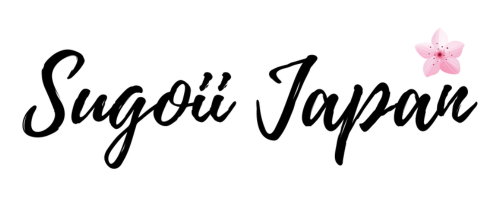
Best Onsen Towns In Japan – Japanese hot springs, or onsens, are renowned across the world for being a symbol of rest and relaxation. They’re aspects of the Japanese culture that are so intrinsic and distinct that it’d be a crime not to visit one during your visit to Japan.
Onsen baths were historically used as a means of purifying the body both physically and spiritually. There were quite a few rules and regulations regarding bathing back in the day, however, these days, there are many relaxed onsen baths throughout the country that cater wonderfully for foreigners who want a taste of the unique experience.
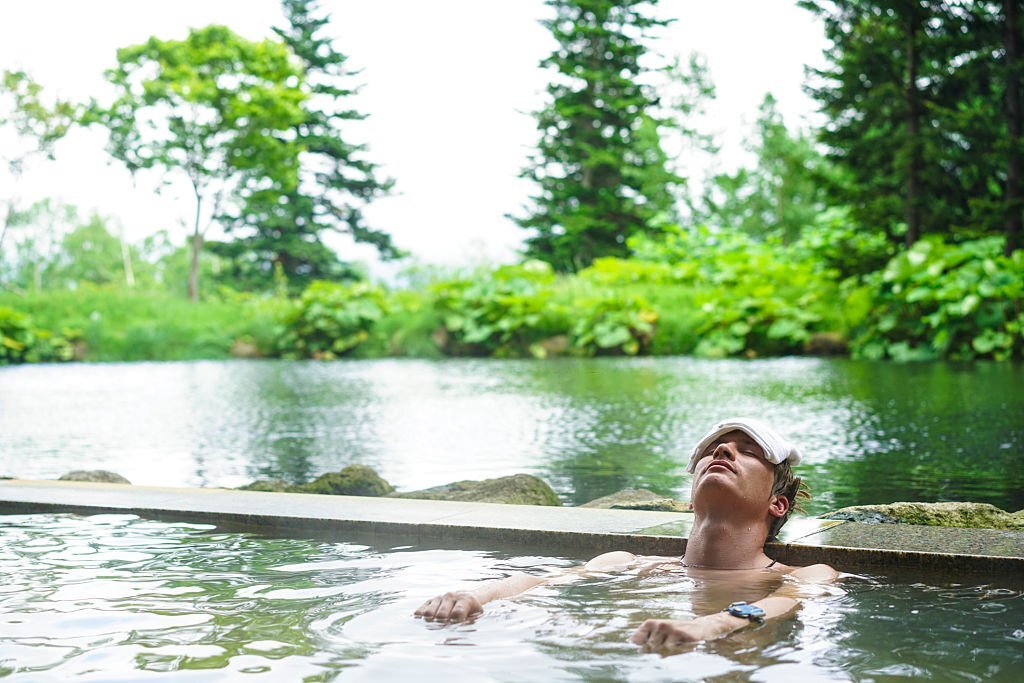
Onsen bathing is a very Japanese affair, and thus you can expect there to be a few things to know before you go. If it’s your first time, please refer to our Dos and Don’ts here, and if you’re interested in finding more about the history of onsen baths, we’ve got an interesting and detailed article here for you to have a read: Onsen Etiquette .
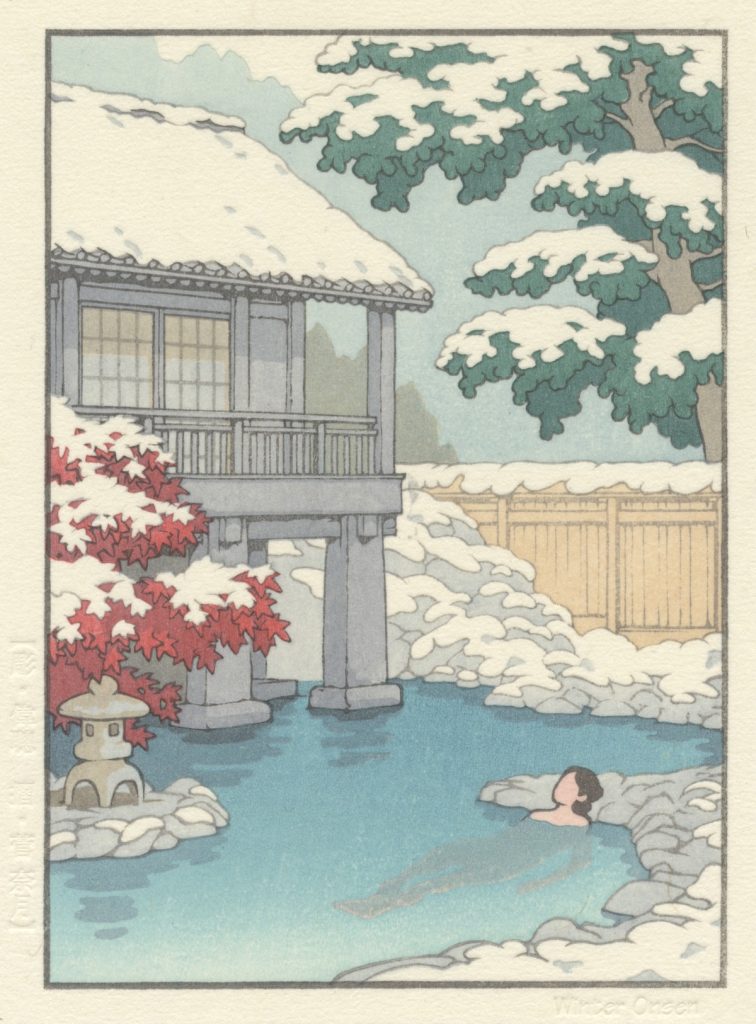
Apart from onsen baths being a beautiful feature of the Japanese culture, it’s also an easy and great way to spruce up your travel itinerary, especially if you’re looking for something out of the ordinary.
However, once you begin looking into it, you’ll start to realise that there are many, many hot springs located throughout the country. In fact, that is even entire towns dedicated to the onsen bathing pools in that area. It’s quite a handful when you begin looking into which one to build into your itinerary.
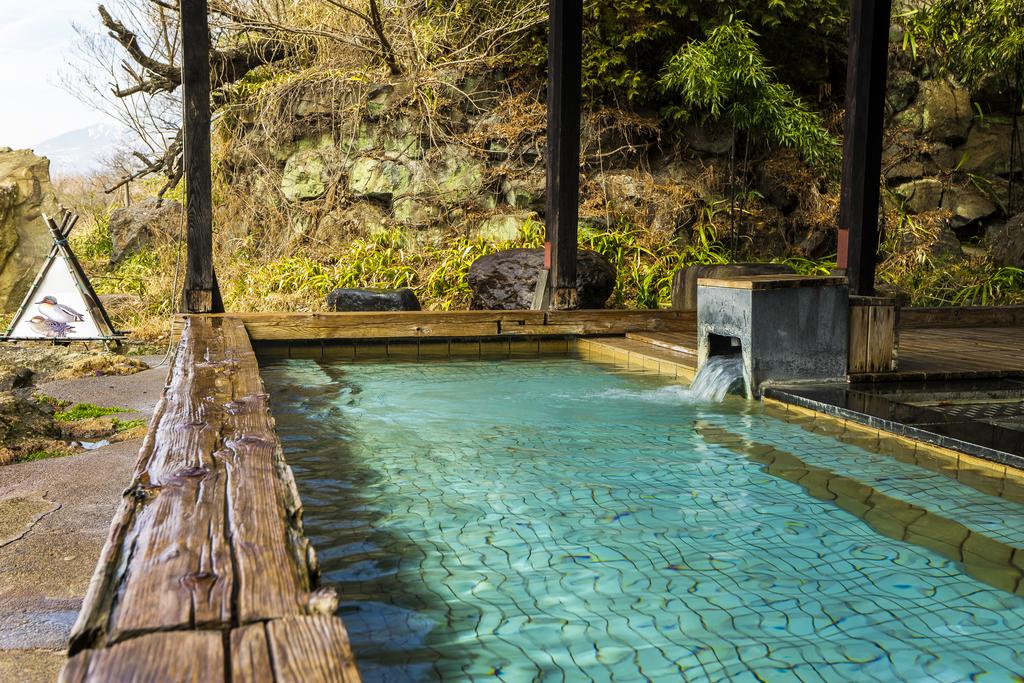
Thankfully, we’ve put together a list of the 10 best hot spring cities you can visit when you’re in Japan. Visit one, two, three, or make it your lifelong goal to visit them all over multiple trips – it’s up to you.

The 11 Best Onsen Towns In Japan
You will find below our complete list of the 11 best onsen towns in Japan .
- Kusatsu Onsen
- Kurokawa Onsen
- Yufuin Onsen
- Okuhida Onsen
- Yunomine Onsen
- Noboribetsu Onsen
- Shuzenji Onsen
We also added a location of each onsen towns in the map below so you can easily add them to your travel itinerary.
1. Gero Onsen
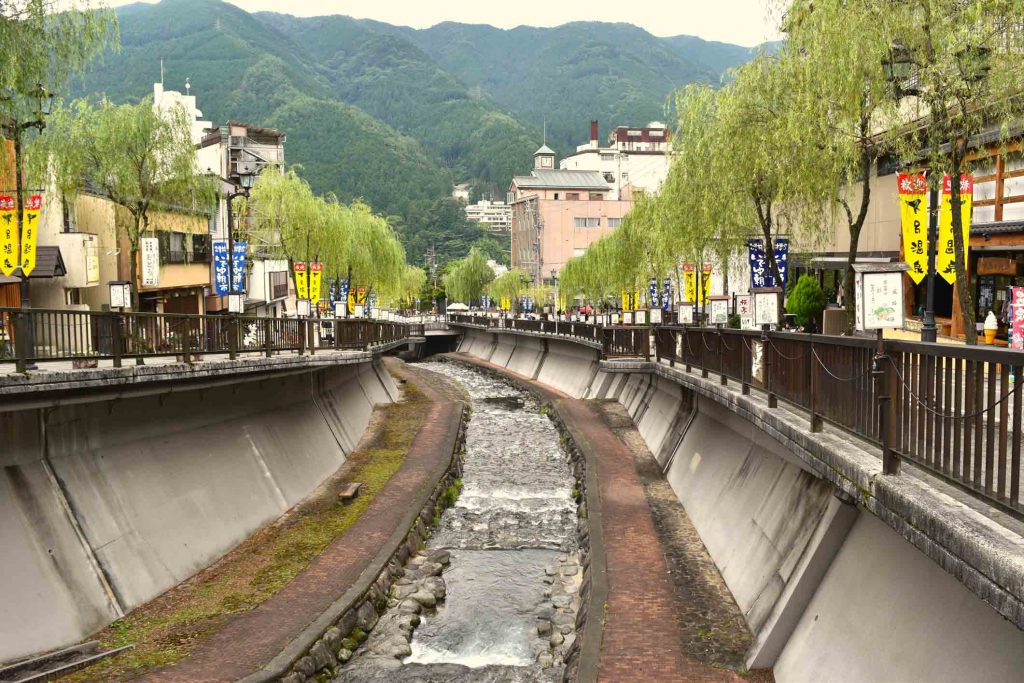
Gero Onsen, located in the mountainous Gifu region , has been famously referred to as one of the top three hot springs of Japan by an esteemed Confucian scholar (alongside Arima Onsen and Kusatsu Onsen ). It’s definitely more off-the-beaten track than not, however, that doesn’t mean it comes without charm. In fact, the discreet location and lack of spotlight on this onsen means that it’s the perfect getaway for those looking for peace and quiet to unwind and recharge.
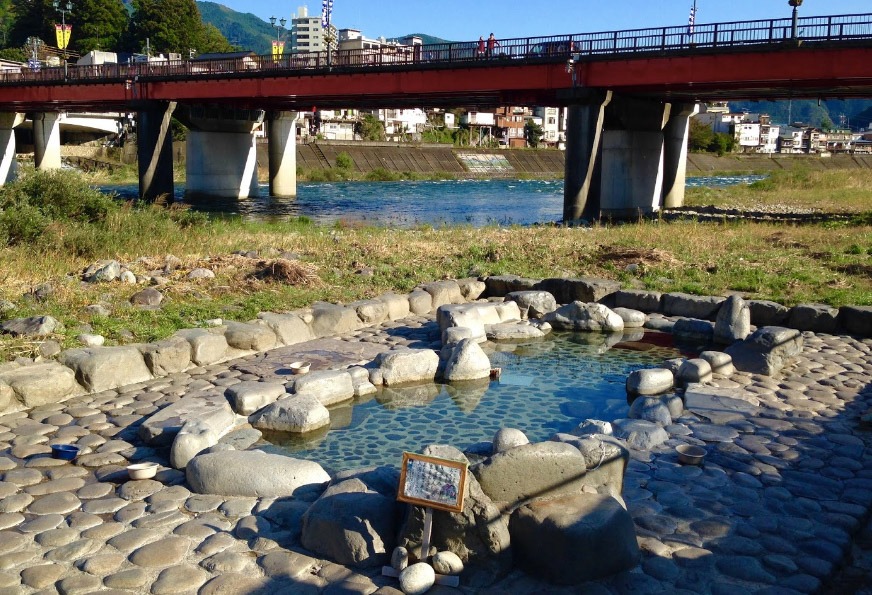
The city itself offers stunning ryokan accommodation that provide onsite hot spring baths, however, you’re encouraged to purchase a Yu-Meguri-Tegata spa pass whilst there and go onsen-hopping to really get the most of the onsen experience.
Read more about this beautiful onsen town here: Gero Onsen >>
2. Kusatsu Onsen
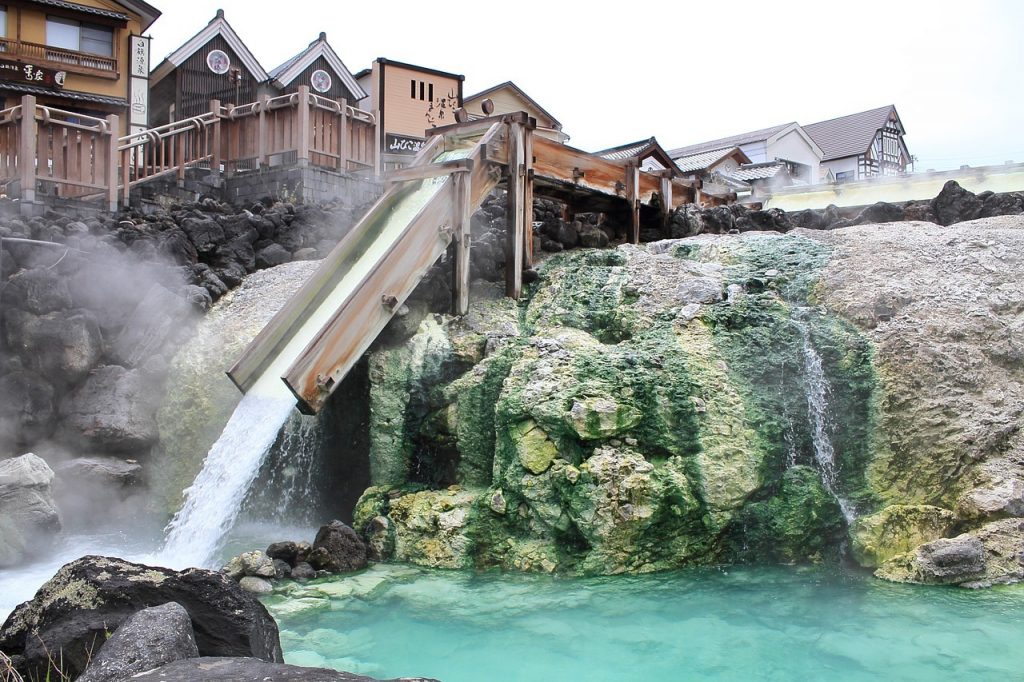
Nestled deep and high up on the mountains of the Gunma prefecture sits Kusatsu Onsen, a sleepy town that’s said to hold one of the best hot springs in all of Japan (refer to above paragraph!). As noted by one famous scholar, it’s said to be one of the top three hot springs, and for good reason.
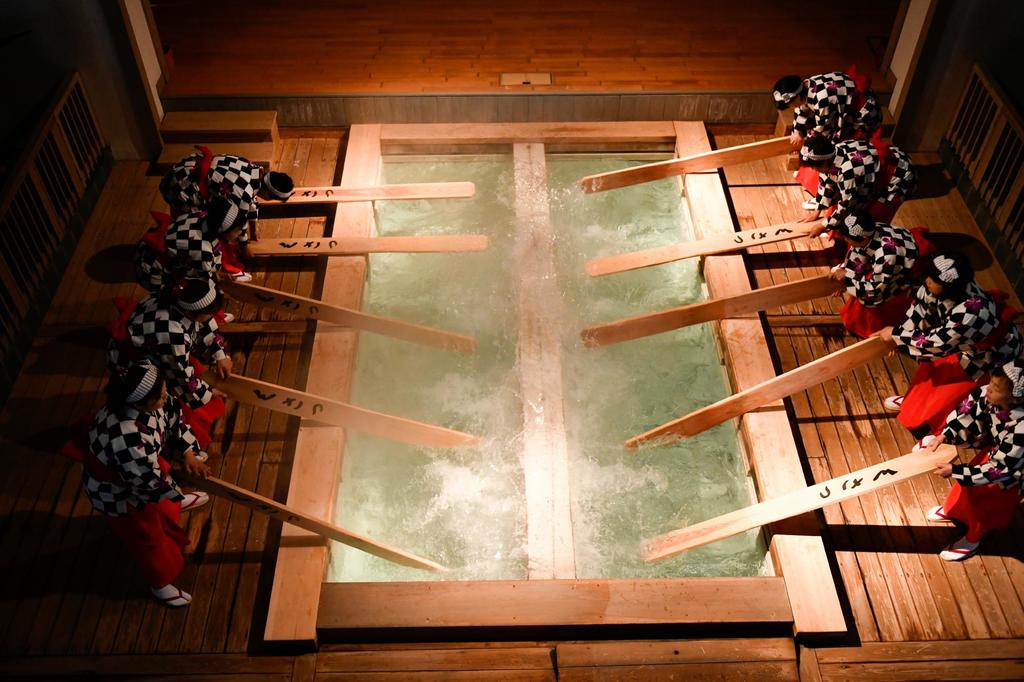
We could go into detail about how the unique but rarely spotted method of cooling down hot sulfuric acid is on display here for visitors to experience, and how literally thousands of litres of water flows down from the mountains to this town every single minute of the day, however, it truly is something you need to experience for yourself. Visit as an overnight trip, or stay for a few days to really get the most of the onsen town experience.
Read more about this city here: Kusatsu Onsen >>
3. Kurokawa Onsen
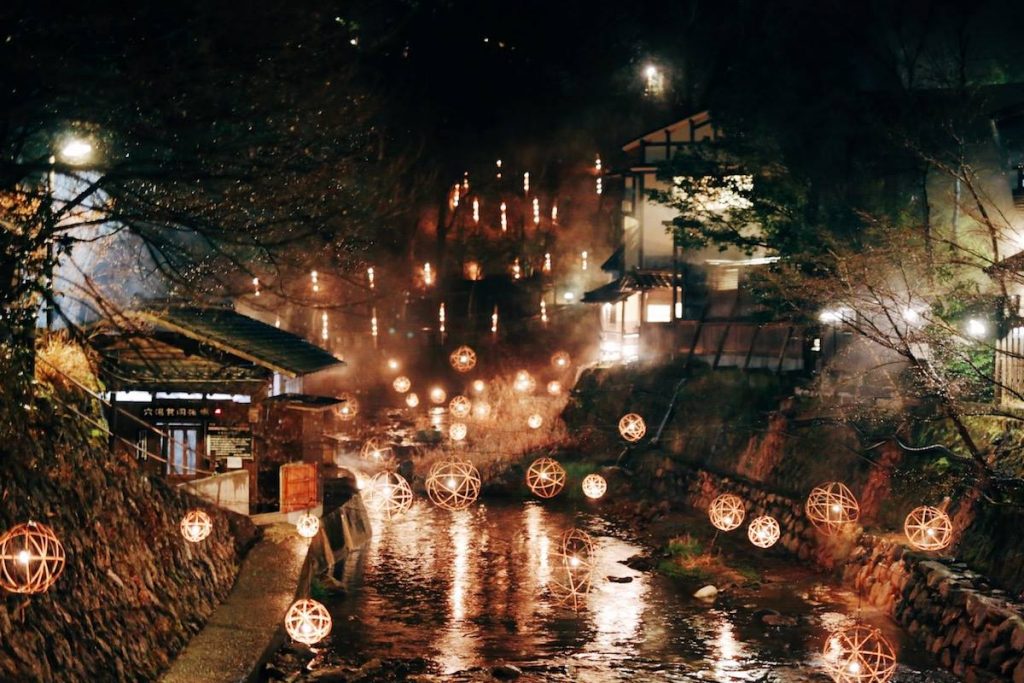
All the way west of Japan sits Kurokawa Onsen, one of Kyushu’s greatest offerings. This old-school onsen town has been around for centuries, but got its deserved break in the 1960s when the public began to pay attention to the wonderfully preserved structures and authentic ambience of this place. It draws more of a local crowd, and at any point in time you’ll find tourists walking leisurely through the town in their yukata, quietly enjoying the atmosphere and taking in the gorgeous sights.
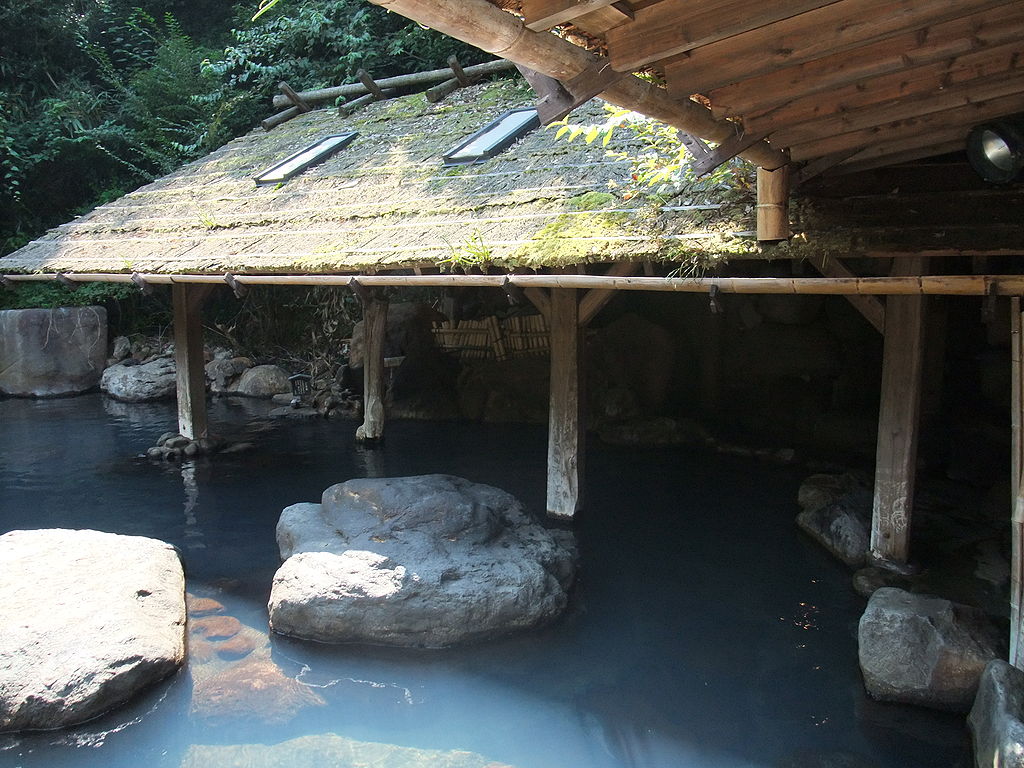
One thing you’ll note about this place is that although it’s considered a top spot for Japanese locals, it’s still relatively rustic looking and feeling, and that is because there has been substantial effort put into preserving the historic roots of the town. Thus, you will be truly getting a historical experience if you visit this place!
Read more about this lovely place here: Kurokawa Onsen >>
4. Yufuin Onsen

If you’re after a quaint countryside onsen town that offers a laid-back and enjoyable atmosphere, plenty of hot spring options, and incredible food, then Yufuin Onsen is a great choice. This small onsen town sits at the foot of Mount Yufu within the Oita Prefecture, and is a great option if you want to combine some intense mountain hiking with a languid hot spring hopping experience.
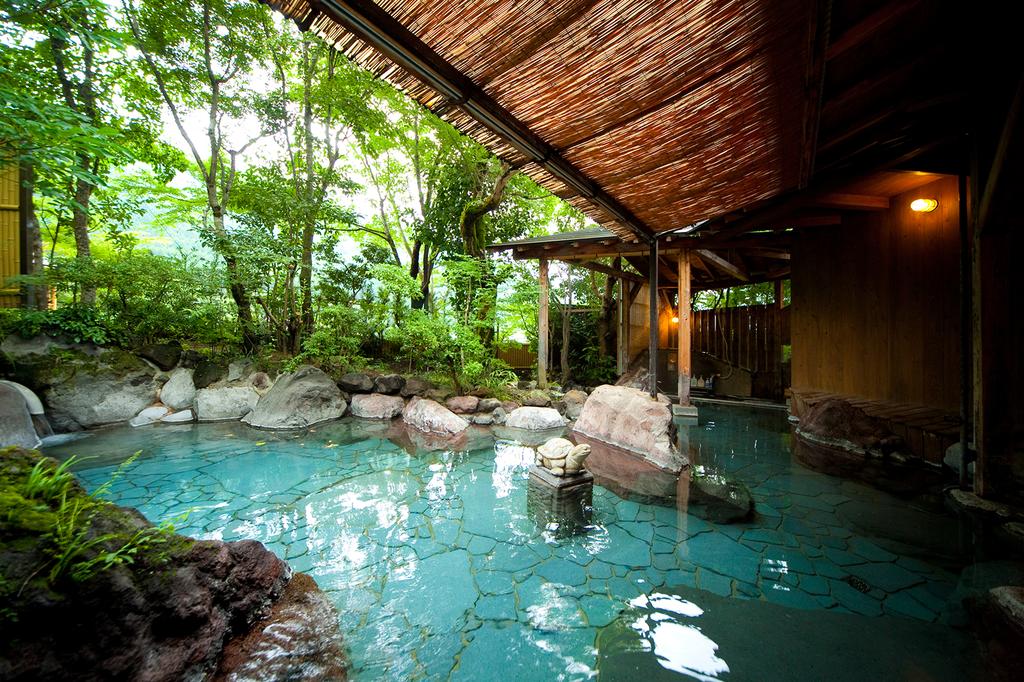
Unlike many other towns where there is one main strip of onsen baths, here, you’ll have to walk around town, exploring the little strips to alleyways to access all the baths and shops and restaurants, which is a great little change!
More travel tips to visit this onsen town here: Yufuin Onsen >>
5. Okuhida Onsen
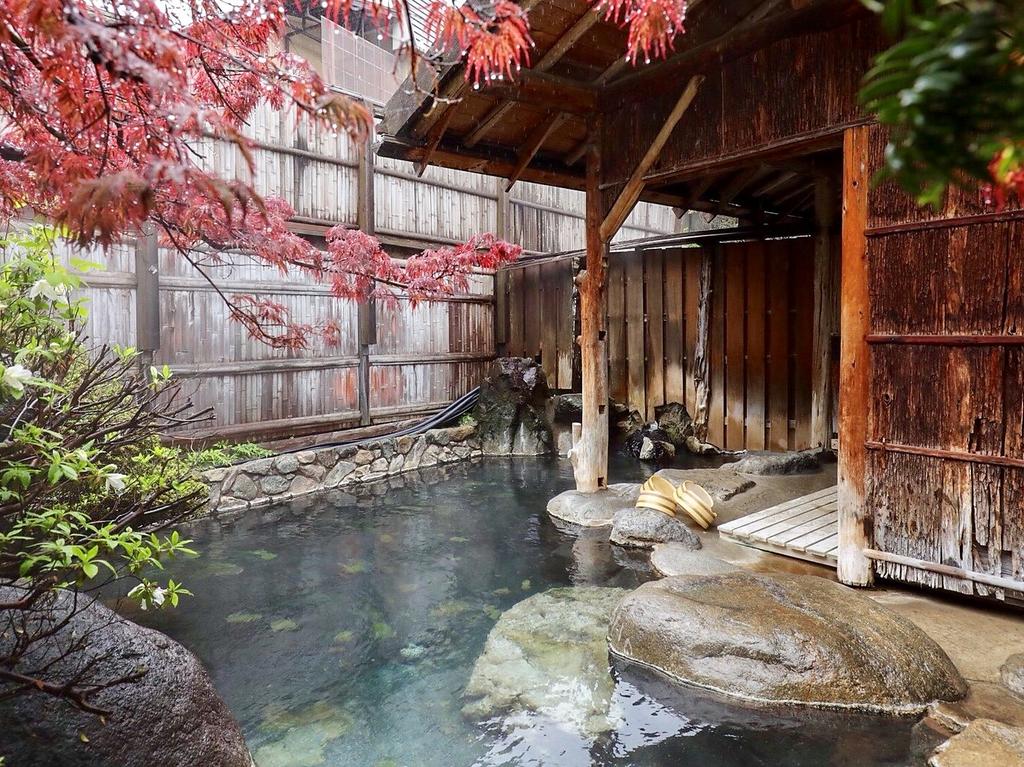
For a magical experience, the onsen village of Okuhida, which is made up of a whopping five different onsen towns, is the place to go. Because of its location deep in the mountains, you can imagine that the water quality is of superb quality and abundant quantity. What makes Okuhida Onsen stand out is the fact that it’s home to an incredible number of rotenburos (outdoor open-air baths).
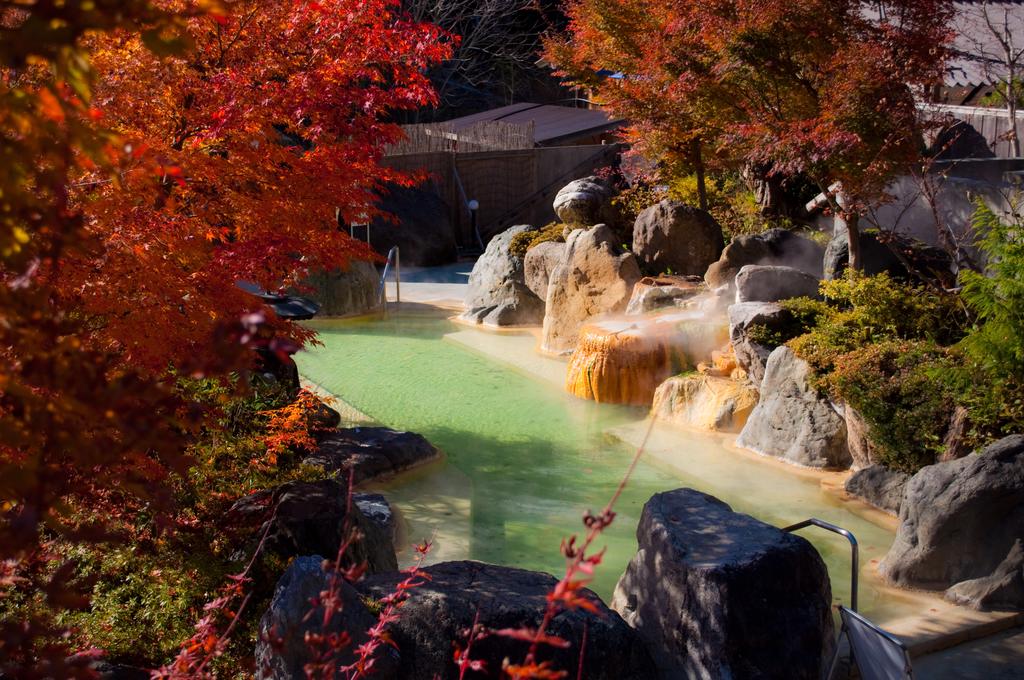
During any time of the year, whilst you’re soaking in the steaming hot baths, slowly feeling your muscles giving way, you can take in the views of the mountains which stretch for miles and the starry night sky and know that you’ve experienced something intrinsically Japanese.
Discover more this area here: Okuhida Onsen >>
6. Yunomine Onsen

Located along the famous Nakamichi trail of the vast network of Kumano Kodo trails , Yunomine Onsen is a popular stopover for those completing the hike. Noted as the only hot spring that is included as a UNESCO World Heritage Site, this quaint town absolutely boils over with charm and character. With its discovery being more than 1800 years ago, some even declare it as the oldest hot spring across Japan!
Here, you won’t find bustling crowds, loud cheers, or any rambunctious behavior. Instead, you’ll find an extremely serene atmosphere, historic structures, small roads, and the feature that shot Yunomine Onsen to its popularity level today – the Tsuboyu Onsen, which is a tiny, century-old onsen that’s said to have great healing waters.
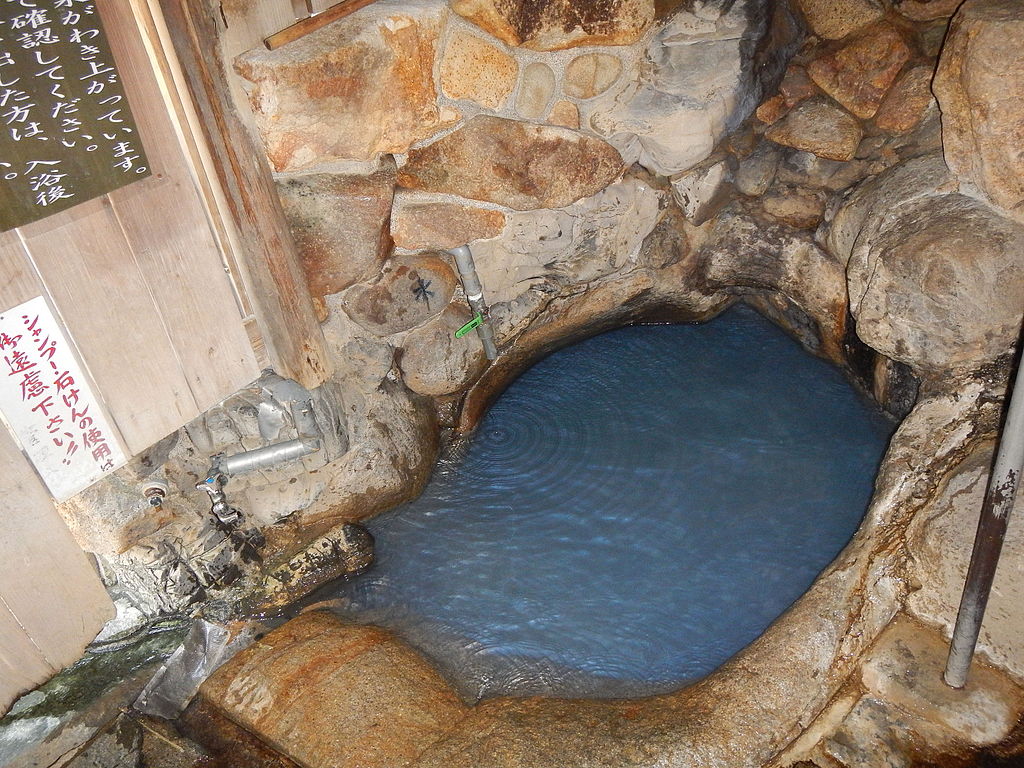
Read more about this onsen town here: Yunomine Onsen >>
If you are visiting Osaka and want to visit an onsen town in that area, make sure to also read our post about the best onsen towns near Osaka !
7. Zao Onsen
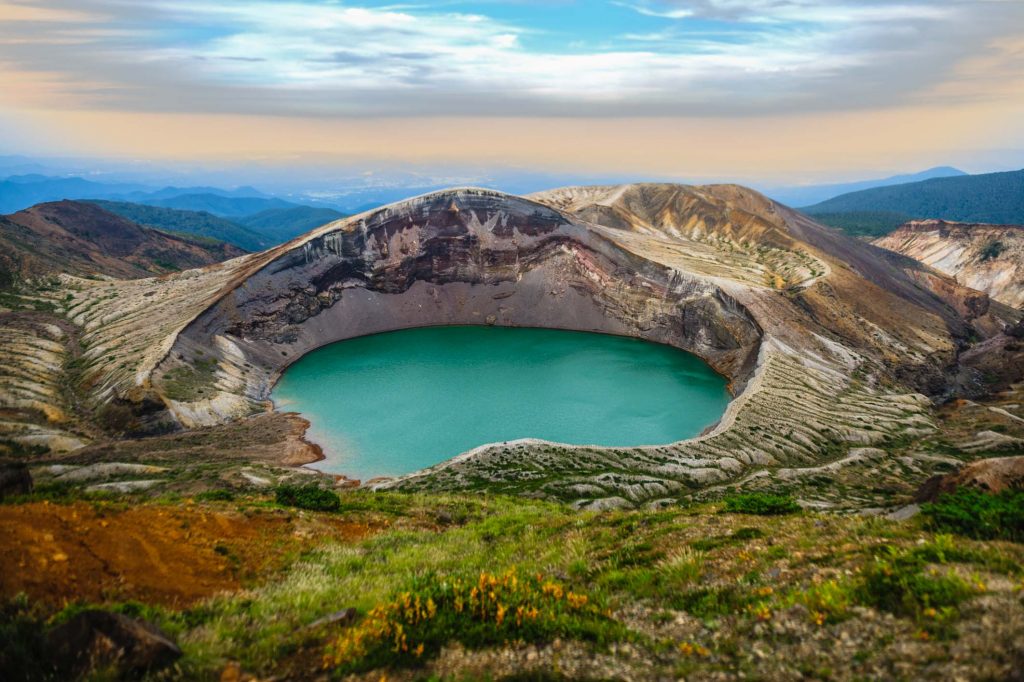
Zao Onsen is mostly known for two major things: an exciting snow resort destination during winter, and an easily-accessed, majestic hot spring destination throughout the entire year. If we’re being honest, the town itself is slightly more commercialized than most, but the number of visitors it draws per year is extraordinary.
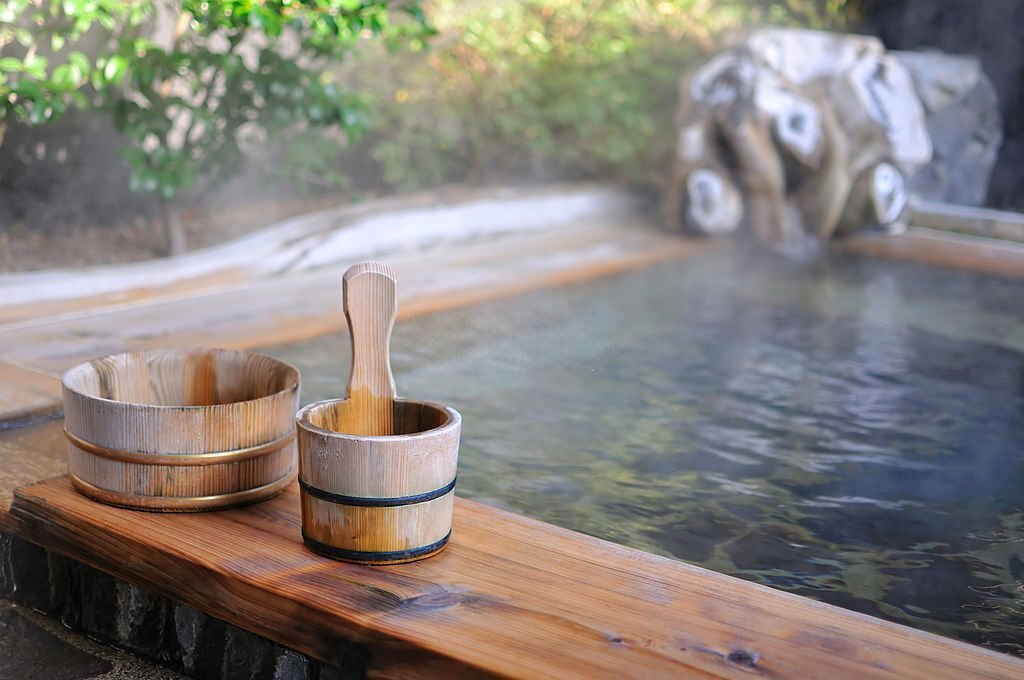
It’s a popular choice not only because of its hot springs, but also due to the number of activities visitors can participate in whilst there, from skiing and snowing, to hiking, exploring the area using the ropeway, and experiencing some local culinary delights.
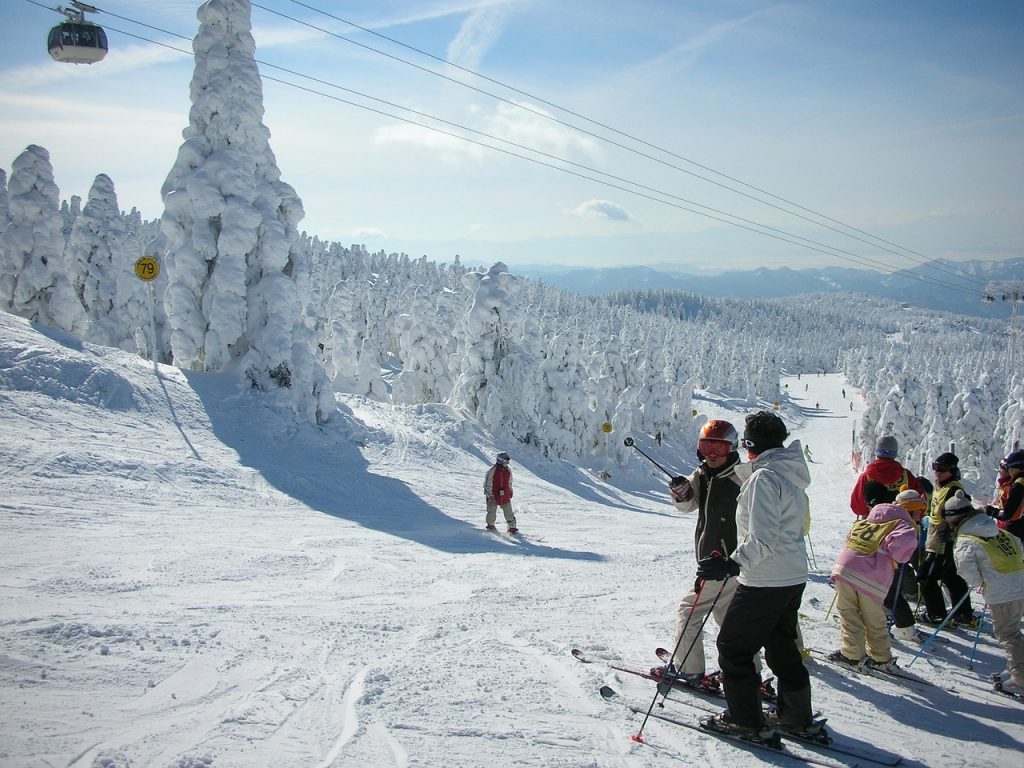
From Tokyo, it’s an easy 2.5 to 3-hour direct train trip, so if you have larger groups or are part of a traveling family, this option is great for convenience and ease of travel.
Read more about this cool city here: Zao Onsen >>
8. Noboribetsu Onsen
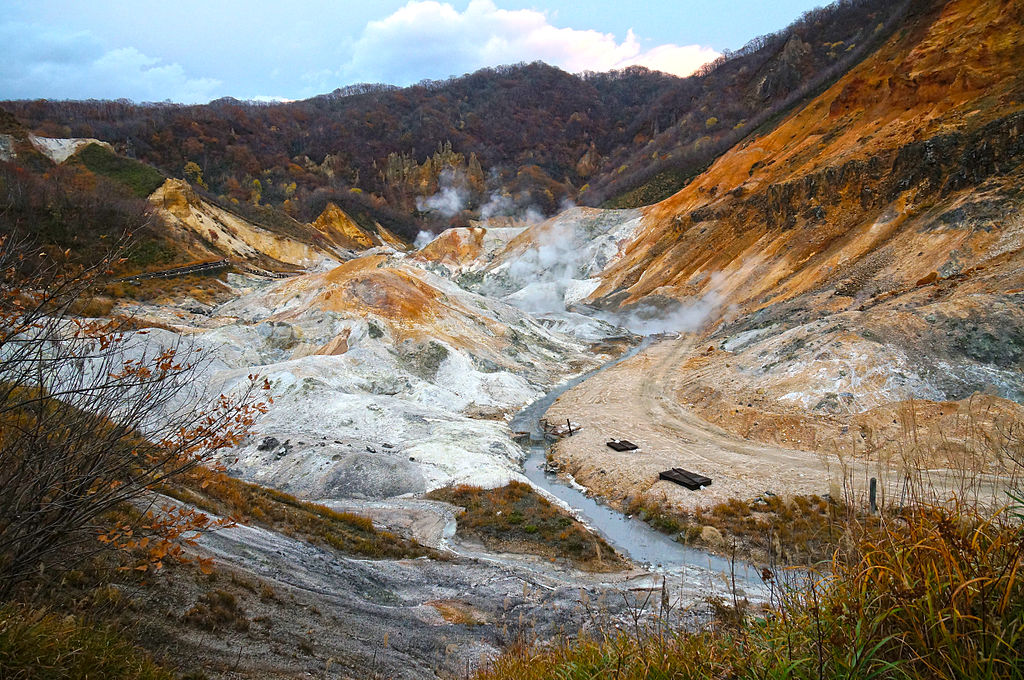
For an onsen town experience unlike any other, Noboribetsu Onsen up north offers a fantasy-like experience. Due to its unique location at the foot of the volcanic Mount Hiyori, the trails of Hell Valley are constantly surrounded by mist, smoke, and fog, making it look and feel as though you’re walking through a dystopian town.
In our opinion, the photographic opportunities here are one of a kind, which may be reason enough for some people to put it onto their itinerary!
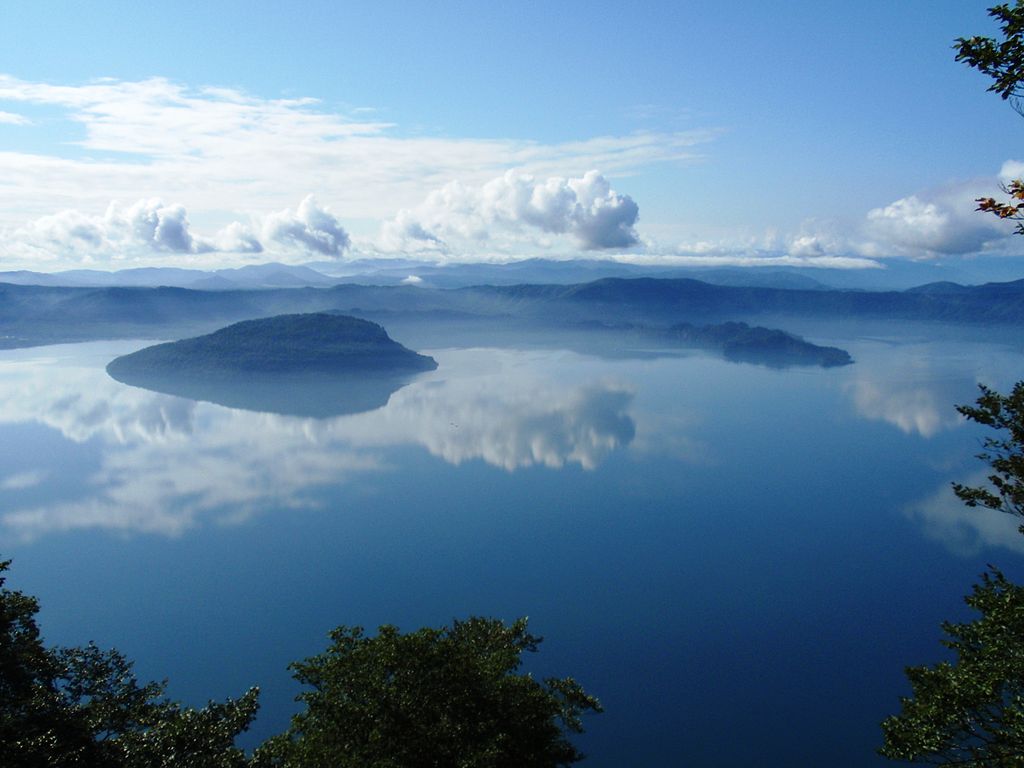
Aside from that, there are plenty of activities to participate in here, including, of course, visiting the numerous hot spring baths throughout the town, visiting the picturesque Lake Kuttara (the ‘roundest’ lake in Japan), witnessing some real-time gurgling hot spring lakes, and resting your feet in a natural footbath.
Read more about this spot here: Noboribetsu Onsen >>
9. Shuzenji Onsen
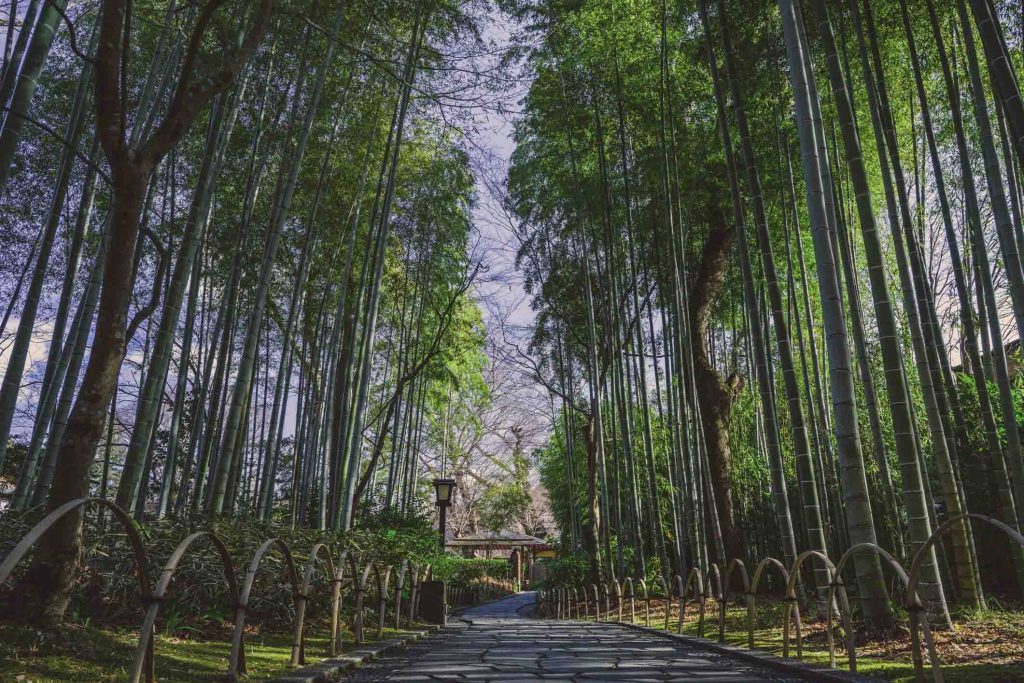
The Izu peninsula is best known for its gorgeous azure blue water, but if you delve a little deeper, you’ll find that the hills of Izu hosts the gorgeous Shuzenji Onsen town, a quaint but locally-famous town which offers a wonderful insight into Japan’s nature and hot spring baths. Instead of mountain views, you’ll find yourself wandering through forests under tall bamboo trees, breathing in the fresh air.
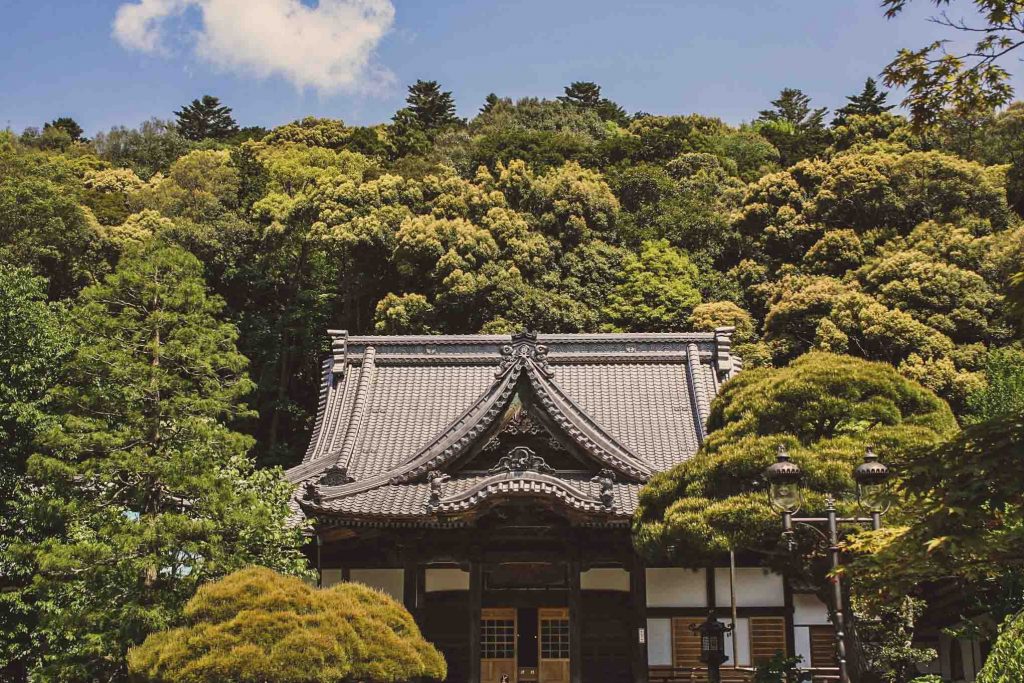
Whilst it does not boast an extensive list of activities to do, its easy-to-get-to location and slow atmosphere this makes it a great option for all travelers; whether you’re on a tight schedule and want to just do a day trip (it’s only 90-minutes away from Tokyo), or whether you’d like to spend a few days away from the city life to experience the famous Japanese Zen.
Read more about this area here: Shuzenji Onsen >>
If you visit Shuzenji, make sure to keep some time to also visit the beautiful city of Atami !
10. Dogo Onsen
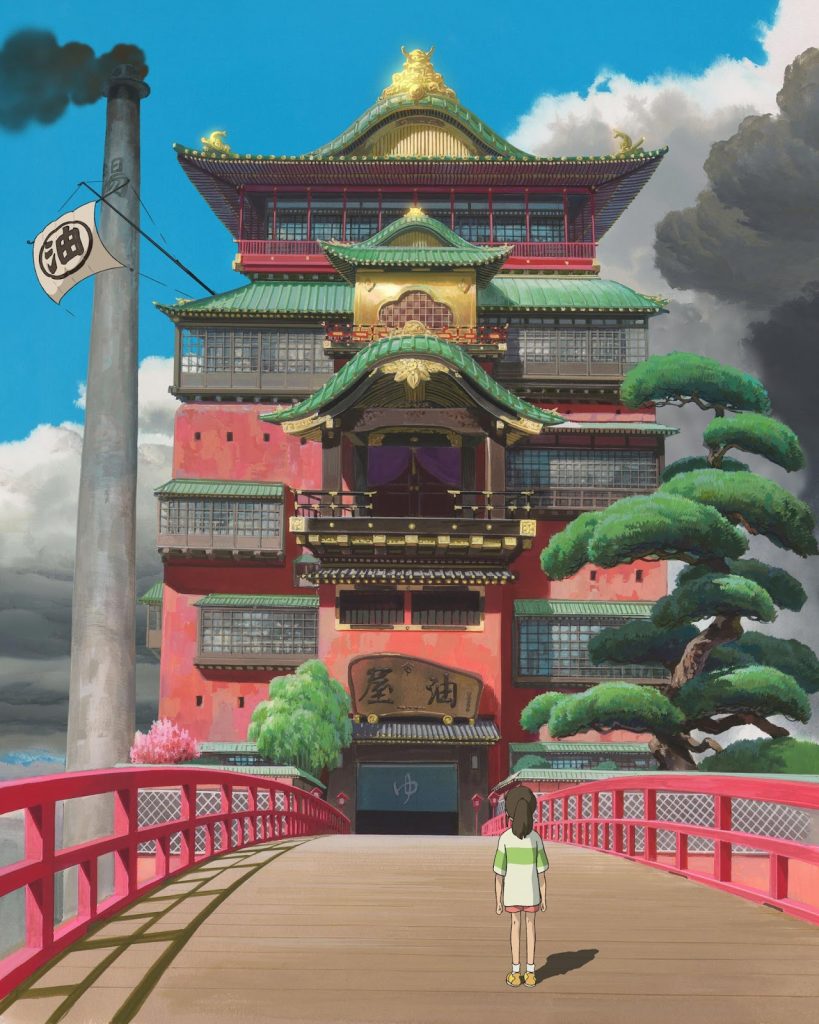
Dogo Onsen shot to international popularity after the anime Spirited Away featured it in its film. However, prior to that, Dogo Onsen was still a popular choice amongst Japanese locals, and the gorgeous exterior and interior are only part of its overall charm. Located on the island of Shikoku, it’s not necessarily on the main route that tourists like to visit in Japan, but that’ just part and parcel with its charm.
Whilst many other onsen towns offer ambient atmospheres and rustic landscapes that are surrounded by nature, Dogo Onsen is unapologetically full of life . The colours are vibrant in this town and the restaurant owners and shop keepers are happy and chatty.
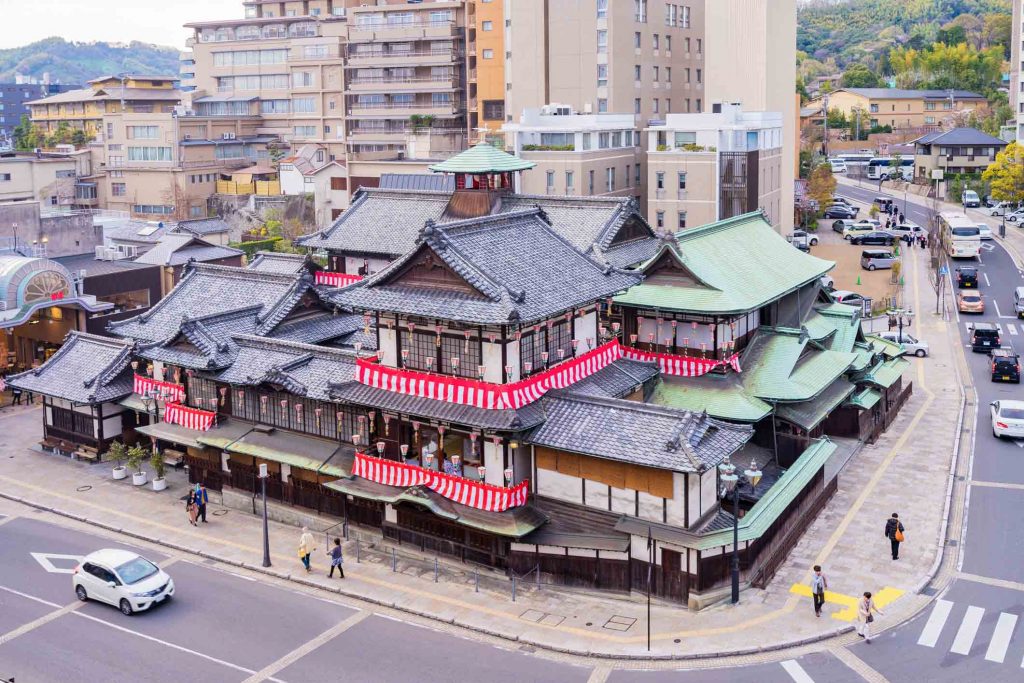
When visiting Dogo Onsen town, you may feel inclined to visit the famous Dogo Onsen Honkan, but if you look further into this town, you’ll find that there are many other onsen bathing options where you won’t have to fight a crowd.
However, if you’re just looking for an epic photo opportunity that screams ‘I was at the onsen in Spirited Away!’, then we recommend heading to the Dogo Onsen Honkan at night when the lanterns are all lit up for a spectacular sight.
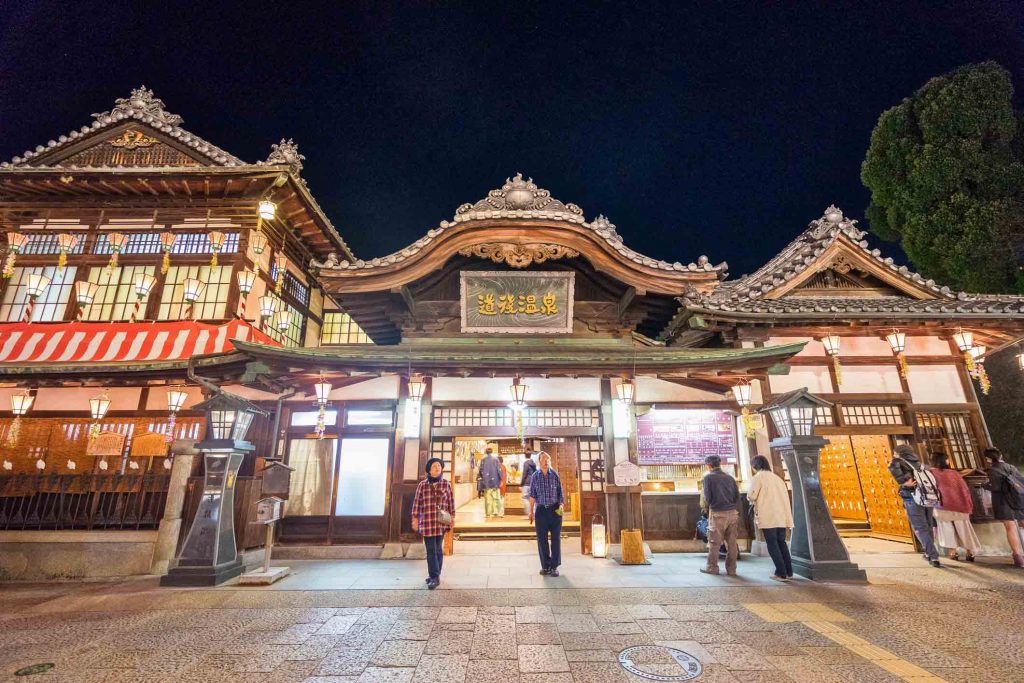
More info about this own town here: Dogo Onsen >>
11. Ito Onsen
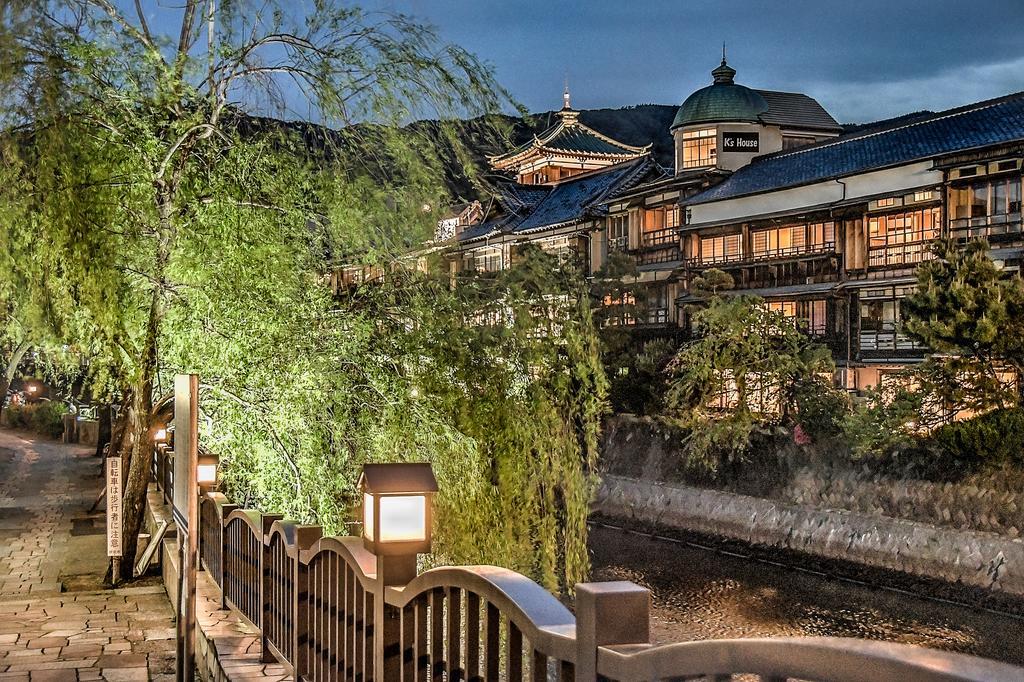
Around 2 hours away from Tokyo, Ito Onsen is a real hidden gem lost in Izu Peninsula. If you want to enjoy a calm and relaxing town with awesome onsen options, I really recommend you to get there and spend one or 2 nights.
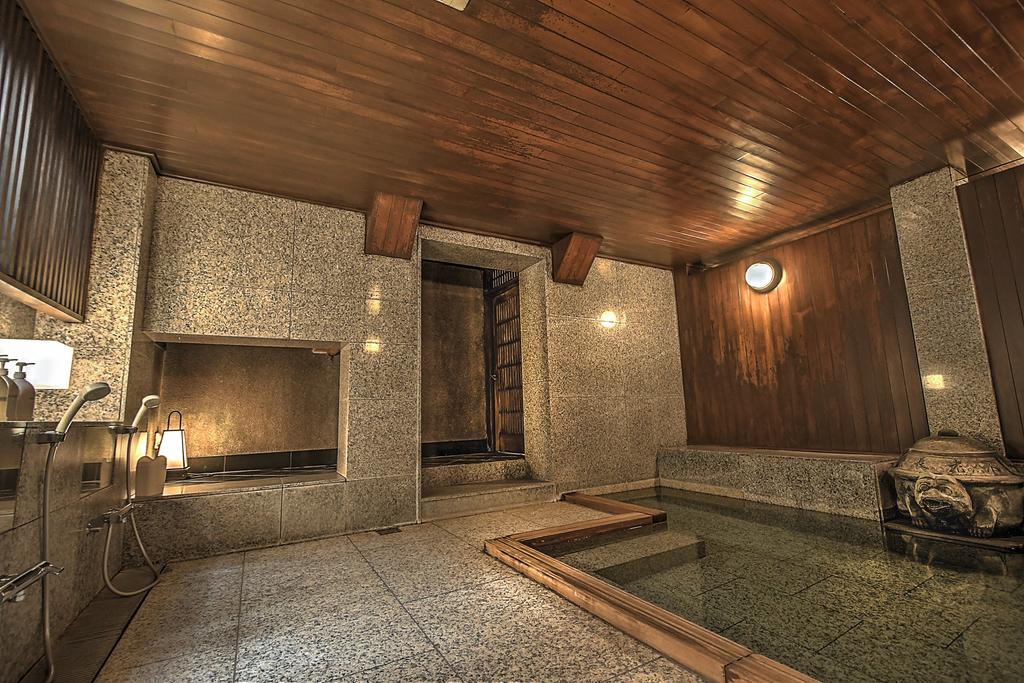
In addition to the hot springs, Ito is actually located by the sea so you can enjoy a nice walk on the beach during your stay. Make sure you eat the local seafood, it’s affordable and delicious!
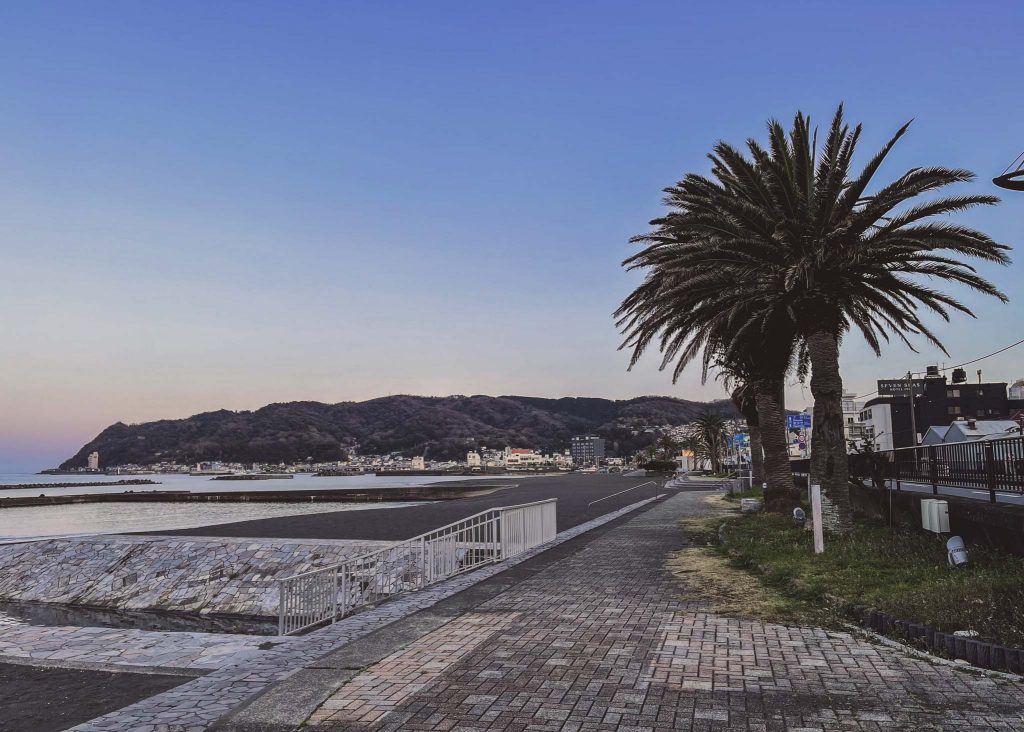
Their are also plenty of things to do around this onsen town so make sure you read our full travel guide to Ito Onsen !
Given the high density of onsen towns across Japan, chances are we’ve covered at least one that can be easily reached from where you may be visiting in Japan.
Our above linked articles details all the information you may need for each hot spring city – how to get there, where to stay, and what to do. We recommend that you give each one a read to figure out which experience would best suit you, and go from there!
For less popular onsen towns, you can also check out our new posts about Nyuto Onsen hidden in Akita prefecture or also our travel guide to visit Ikaho Onsen .
Leave a Reply Cancel reply
Your email address will not be published.
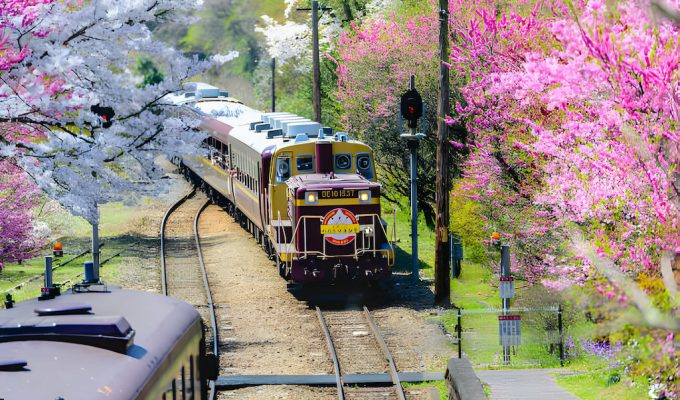
A Complete Guide To Enjoy Peach Blossom In Japan
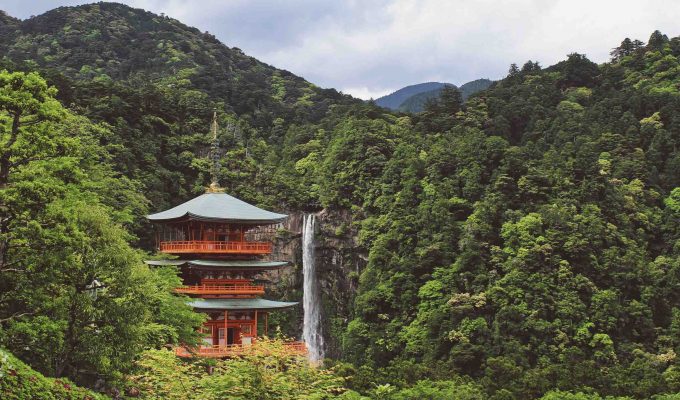
Japan Travel Blog 2024 – The Ultimate Guide To Visit Japan
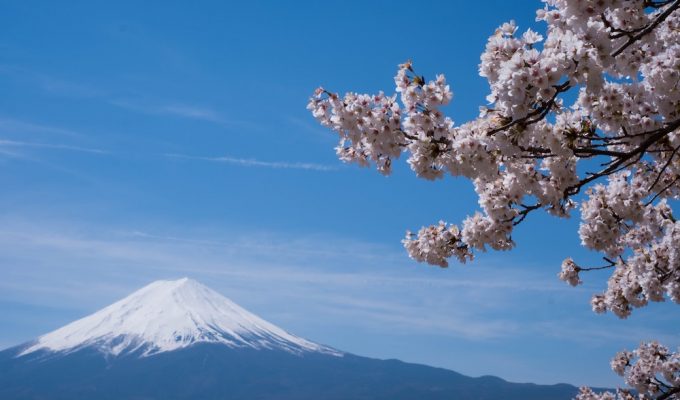
Cherry Blossom Forecast Japan Spring 2024 – When To Enjoy Sakura
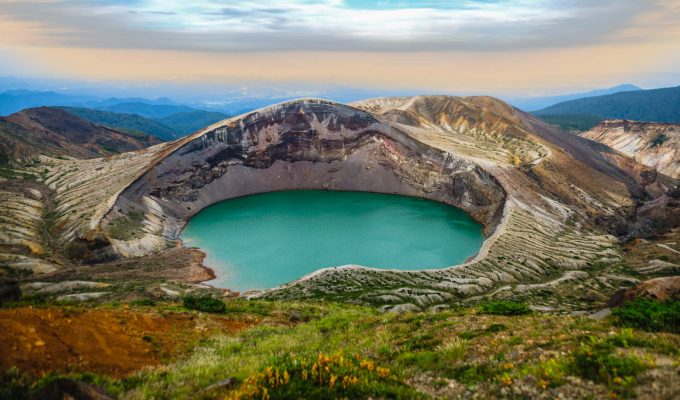
Zao Onsen – Get Off The Beaten Track And Visit This Gorgeous Onsen Town
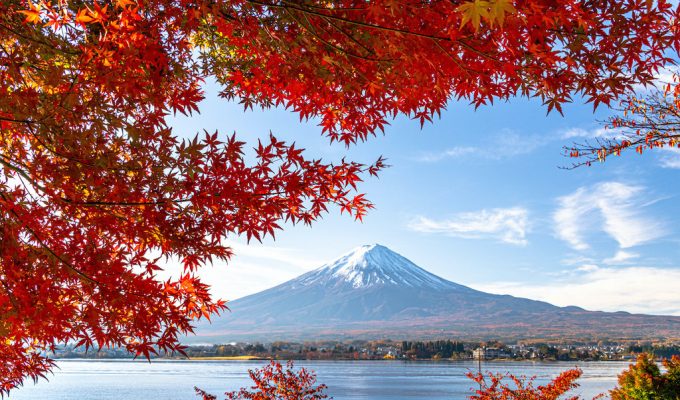
The 10 Most Beautiful Autumn Leaves Spots In Japan
The 10 coolest & most unique hotels in japan.
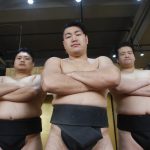
Welcome To The New Sumo Restaurant In Tokyo: Asakusa Sumo Club
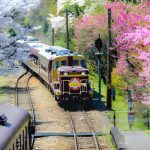
Discover Otsu – 10 Things To Do In This Beautiful Hidden Town Near Kyoto
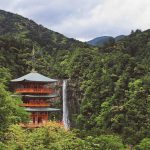
Explore Kichijoji in Tokyo – Full Area Guide You Have To Read!
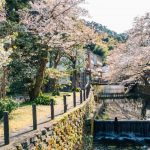
The 7 Best Onsen Towns Near Kyoto You Have To Explore
- Search Please fill out this field.
- Newsletters
- More to Explore
- Things To Do
Japanese Onsen: The Complete Guide
Visiting onsen, or hot springs baths, is a national pastime in Japan. They’re literally part of the landscape, as they’ve been around since tectonic activity formed the Japanese archipelago millions of years ago. Wherever there’s a mountain — and there are a lot of mountains in Japan — there are usually onsen.
Japanese people have been enjoying the therapeutic and medicinal benefits of hot springs since ancient times. Now, foreign travelers are finally catching on, electing to stay at traditional ryokan with luxe communal baths instead of regular, run-of-the-mill hotels.
We’ve prepared a thorough guide that explains the various dos and don’ts of enjoying Japan’s best kept secret.
The Etiquette of Onsen
Onsen can be intimidating for first-time visitors. The thought of bathing next to unknown bodies often deters shyer types from using them at all. However, most people find that their anxiety evaporates once they’re immersed in the pleasant warmth of a steaming natural bath.
Rest assured, onsen etiquette is all pretty straightforward. First and foremost, hot spring baths require that you enter completely naked — this means no swimsuits. If you’re a guest at a ryokan, you’ll typically receive a yukata , a light cotton kimono, that you can wear to change into after you’ve bathed. Your lodgings will also provide one average-sized towel and one small towel. Make sure to bring these with you when you decide to venture to the baths. Remember that onsen are usually separated into male and female areas, although there are several co-ed onsen scattered around Japan.
Unfortunately, transgender, genderqueer, and intersex patrons may face considerable difficulty entering an onsen, although there is presently an effort in Beppu to make hot spring resorts more friendly to people of all genders.
How to Bathe
The changing area of onsen often has lockers or baskets where you can store your clothes and belongings — after shedding your clothes, take only the small towel with you into the bathing area. It’s common sense, but in no circumstances should you use your camera or cell phone in the changing room or bathing area!
Before entering the baths themselves, you’ve got to shower first. You will probably see small plastic seats and shallow buckets stacked neatly at the entrance. Grab one of each and head to one of the small showers lining the side of the room. Wash your body thoroughly, making sure to rinse off any soapy residue. The small towel you can use to scrub your body, and/or tie up your hair — whatever you do, make sure that neither the towel nor your hair ever touches the water of the baths. While soaking, most people fold up their towels and rest them on top of their heads.
Once you’re completely clean, you’re ready to enjoy the onsen!
The Tattoo Problem
While many onsen forbid patrons with tattoos (citing past problems with organized crime ), others turn a blind eye to smaller tattoos, or don’t mind tattoos on foreign guests. If you’re significantly inked, it’s best to double check with the onsen before your visit. If your tattoos are small, it might be wise to simply place a band-aid over to them as a temporarily concealer. There are many tattoo-friendly establishments out there, so don’t worry if your first choice hot spring turns you down.
The Baths of Japan
Hot spring water varies from onsen to onsen. Onsen owners usually tout their baths as containing some kind of positive effects — medicinal, therapeutic, or beautifying. For example, the Takimotokan onsen in Hokkaido is home to five different springs, each with their own distinct benefits. The sodium spring supposedly softens your skin and relieves eczema, while the “ferrous sulphate” spring is meant to enhance circulation.
This trend is not specific to Takimotokan: hot springs all over Japan claim the unique, curative powers of their geothermal waters. The best hot spring destinations are in no way secluded to one area of Japan — you can find amazing onsen in almost every Japanese prefecture. If you’re staying near Tokyo, one of the most accessible onsen spots is Hakone, a small town with the country’s most jaw-dropping vistas of Mount Fuji.
Private Baths
Finally, for those people who still aren’t convinced that public bathing is for them, there are hundreds of private onsen out there, and/or onsen that can be rented for private parties only. While a bit on the pricier side, Ryokan Kurashiki near Okayama, and Gora Kadan in Hakone, are two such onsen that come highly recommended.
Check out Kyoto's Bamboo Forest too.
Related Articles
More related articles.

Japanese Onsen: The Complete Guide to Bathing in Japan
By: Author Lora
Posted on Last updated: May 16, 2024
Welcome to the tranquil world of Japanese onsens, where relaxation and rejuvenation await amidst natural hot spring waters. If you’re looking for the best Japanese onsens, you’ve come to the right place.
In this guide, I’ll take you on a journey through the various facets of onsen culture, from bathing etiquette to the best hot springs across Japan.
This post contains affiliate links. If you click one of them, we may receive a small commission (for which we are deeply grateful) at no extra cost to you.
Table of Contents
Japan Essentials
We almost always find the best flights to Tokyo and Osaka on Momondo . It may be worthwhile to compare these with Skyscanner and a new but promising flight aggregator, WayAway .
Don’t lose time upon arrival at the airport and order your Japan travel SIM or portable WiFi device in advance so that it’s ready and waiting for you at the airport when you arrive.
Find out which JR Pass will save you the most for your trip to Japan.
Check out our ultimate Japan travel blog where you can find many more interesting Japan articles to prepare for your trip.
Need help with your Japan trip planning? Check out this post on how to plan your trip to Japan.

What Is An Onsen?
An onsen is a special kind of hot spring in Japan that people love for its healing powers and peaceful atmosphere.
These natural hot springs can be found all over Japan and have been loved for many years.
Imagine soaking in warm water surrounded by beautiful nature. That’s what an onsen offers.
The water has minerals that can make you feel better, not just in your body but also inside. Each onsen has its own type of water with different benefits.
People in Japan have been enjoying onsens for a long time. It’s not just about getting clean; it’s a chance to relax and feel good.
Some onsens are simple, while others are fancier and offer private baths or even rooms to stay in.
Even though times change, people still love onsens. They’re a place to take a break from busy life, relax, and feel refreshed.
An onsen isn’t just a place—it’s an experience that lets you connect with nature and feel better inside and out.

History Of Onsen
Onsens have a rich history deeply rooted in Japanese culture and tradition.
The practice of bathing in natural hot springs dates back thousands of years, with early records tracing back to the Nara period (710-794) when onsens were revered for their healing properties.
During the Edo period (1603-1868), onsens flourished as social hubs where people from all walks of life would gather to relax, socialize, and conduct business.
Bathing in onsens became not only a means of physical rejuvenation but also a communal activity that fostered camaraderie and connection.
Throughout history, onsens have been closely associated with Shintoism and Buddhism, with many hot springs located near temples and shrines.
The belief in the spiritual purity of hot spring waters further elevated the status of onsens as sacred places of healing and purification.
Today, onsens continue to play a significant role in Japanese culture, attracting millions of visitors each year seeking relaxation and wellness.
While modern amenities and facilities have evolved, the timeless allure of onsens remains, offering a glimpse into Japan’s rich cultural heritage and deep reverence for nature’s gifts.

Types Of Onsens And Their Benefits
Onsens offer a diverse array of baths, catering to different preferences and needs, including indoor baths, outdoor baths, and mixed-gender baths.
Each type provides a unique experience, inviting guests to immerse themselves in the therapeutic waters of Japan’s natural hot springs.
Indoor Baths (Uchiyu): Indoor baths, nestled within cozy buildings, provide a warm and inviting atmosphere, ideal for soaking during chilly weather.
Guests can relax and unwind in the comfort of these enclosed spaces, enjoying the soothing heat of the water without concern for the elements outside.
Outdoor Baths (Rotenburo): Outdoor baths, or rotenburo, offer a picturesque setting amidst nature’s embrace. Imagine soaking in warm water while surrounded by breathtaking views of mountains, forests, or even the ocean.
These open-air baths provide a sensory experience, allowing guests to breathe in the fresh air and feel connected to the natural world around them.
Mixed-Gender Baths (Konyoku): Mixed-gender baths, where men and women can bathe together, offer a rare opportunity for socializing and bonding.
Though less common nowadays, these baths provide a communal atmosphere, allowing friends and family of all genders to enjoy the onsen experience together.
No matter which type of bath you choose, each offers its charm and benefits.
Whether you seek the cozy ambiance of indoor baths, the scenic beauty of outdoor baths, or the communal vibe of mixed-gender baths, onsens have something for everyone to enjoy.
So, take your pick and dive into relaxation amidst the therapeutic waters of Japan’s onsens.

Common Types Of Onsens
There are several common types of onsens, each offering a unique experience.
In this section, you’ll learn about the best onsen Japanese bath that suits you the most.
- Sulphur Onsen: These onsens are rich in sulfur, emitting a distinctive smell. They are renowned for their therapeutic properties, particularly beneficial for skin conditions such as psoriasis and eczema.
- Sodium Chloride Onsen: Also known as saltwater onsens, these baths are believed to induce muscle relaxation and enhance blood circulation, promoting overall well-being.
- Hydrogen Carbonate Onsen: With a high concentration of hydrogen carbonate, these onsens are thought to purify the skin, offering a refreshing and cleansing experience.
- Iron Onsen: Rich in iron, these onsens have a reddish-brown hue and are associated with healing properties for conditions such as anemia and other blood-related ailments.
- Acidic Onsen: Featuring a low pH level, acidic onsens are believed to moisturize and nourish the skin, providing relief from dryness and promoting skin health.
- Alkaline Onsen: Onsens with a high pH level, alkaline onsens are renowned for their skin-cleansing effects, leaving bathers feeling rejuvenated and refreshed after soaking.
Each type of onsen offers a unique bathing experience, allowing guests to immerse themselves in the therapeutic benefits of Japan’s natural hot springs.

Famous Onsen Towns
Here’s a list of famous onsen towns in Japan:
- Hakone (Kanagawa Prefecture): Known for its stunning views of Mount Fuji and numerous hot spring resorts, Hakone is a popular destination for onsen enthusiasts.
- Beppu (Oita Prefecture): Beppu is famous for its wide variety of hot spring sources, including mud baths and sand baths, making it one of Japan’s most renowned onsen towns.
- Kusatsu (Gunma Prefecture): With its high-quality sulfuric waters and vibrant atmosphere, Kusatsu Onsen is beloved by locals and tourists alike for its therapeutic properties.
- Noboribetsu (Hokkaido): Noboribetsu Onsen is known for its unique “Hell Valley” landscape and sulfuric hot springs, attracting visitors seeking relaxation and natural beauty.
- Yufuin (Oita Prefecture): Surrounded by picturesque countryside and scenic mountains, Yufuin Onsen offers a tranquil setting for visitors to unwind and enjoy the therapeutic hot springs.
- Atami (Shizuoka Prefecture): Located along the coast, Atami Onsen is known for its ocean views and abundance of hot spring resorts, making it a popular destination for seaside relaxation.
- Yamanaka (Ishikawa Prefecture): Yamanaka Onsen is celebrated for its elegant ryokan and traditional atmosphere, providing guests with a peaceful retreat in a charming rural setting.
- Shirahama (Wakayama Prefecture): Shirahama Onsen is renowned for its unique sand baths along the scenic coast, offering visitors a distinctive onsen experience by the sea.
These are just a few examples of the many famous onsen towns scattered throughout Japan, each offering unique charm and therapeutic waters for visitors to enjoy.

How To Bathe In An Onsen
Experiencing an onsen involves more than just soaking in hot spring waters; it’s a ritual deeply rooted in tradition and respect.
Here’s a step-by-step guide to ensure you make the most of your onsen experience:
1. Changing Room: Upon arrival at the onsen, you’ll be guided to the changing room, known as “koshitsu.”
Here, you’ll disrobe and store your belongings in lockers provided. It’s customary to bring only essentials into the bathing area, leaving valuables behind for safekeeping.
2. Before Entering the Bath: It’s crucial to adhere to proper hygiene etiquette before stepping into the hot spring waters.
Head to the washing area, known as “aburayu,” where you’ll find shower stations and stools.
Use the provided soap and shampoo to thoroughly wash and rinse your body, ensuring cleanliness and respect for fellow bathers. Use the shower to fill the bucket with water and carefully pour that over your body. It is not customary to wash yourself with the shower head.
3. Bathing: Once you’re clean, it’s time to immerse yourself in the tranquil waters of the onsen. Slowly enter the bath, allowing your body to adjust to the temperature.
Take your time to relax and unwind amidst the serene surroundings, letting the therapeutic properties of the hot spring waters soothe your body and mind.
4. After the Bath: After enjoying your soak, it’s essential to rinse off any remaining traces of minerals from your skin.
Return to the washing area to shower once more, using the provided soap and shampoo.
Gently pat your skin dry with a towel, taking care not to rub too harshly, as the minerals from the onsen can leave your skin feeling soft and hydrated.
By following these simple steps, you can fully immerse yourself in the onsen experience, leaving you feeling refreshed, rejuvenated, and deeply connected to Japan’s rich bathing culture.

Onsen Etiquette
When visiting an onsen, it’s crucial to adhere to proper etiquette to ensure a harmonious experience for everyone.
Here’s an expanded guide to onsen etiquette to help you navigate this cherished Japanese tradition:
- No Shoes: Upon entering the onsen facility, remove your shoes and place them in the designated area. This helps maintain cleanliness and respect for the sacred space of the onsen.
- Nudity is Required: Although there exist some mixed-gender onsen, onsens are typically gender-segregated and require complete nudity. Leave swimwear, underwear, and towels outside the bath area to uphold the cultural norms of the onsen and ensure a hygienic bathing environment.
- Shower Before Entering: Before immersing yourself in the hot spring waters, it’s customary to shower and cleanse your body thoroughly. Use the provided soap and shampoo to ensure cleanliness and hygiene. Most onsens offer complimentary soap and shampoo for guests’ convenience.
- Don’t Dip Your Head Underwater: To maintain water purity, refrain from dipping your head underwater while bathing. Keep your head above water and enjoy the soothing warmth of the onsen without contaminating the water for others.
- Keep the Noise Down: Respect the tranquil ambiance of the onsen by keeping noise levels to a minimum. Engage in quiet conversation, or simply relax and unwind in serene silence to enhance the overall experience for yourself and fellow bathers.
- Don’t Stare: Avoid staring at others while in the bath, as it can make fellow bathers feel uncomfortable. Instead, maintain a relaxed and respectful demeanor, focusing on your own relaxation or the surrounding natural scenery.
- Free Soap and Towels: Many onsens provide complimentary soap and towels for guests to use during their visit. Take advantage of these amenities to ensure a comfortable and hygienic bathing experience.
- Hair Considerations: If you have long hair, consider tying it up or using a hairband to keep it out of the water. This helps prevent hair from entering the bath and maintains cleanliness for yourself and others.
- Small Towel Etiquette: Avoid letting your small towel touch the water, as it can contaminate the bath. Instead, you can place it on the top of your head to prevent dizziness while soaking in the warm waters.
- No Swimming: Onsens are for bathing and relaxation, not for swimming or vigorous activities. Maintain a calm and leisurely demeanor while in the bath to respect the tranquil atmosphere for everyone.
- Dry Yourself Before Going Back to the Changing Room: After finishing your bath, dry yourself thoroughly before returning to the changing room. This helps prevent dripping water and maintains cleanliness in the communal areas of the onsen.
By following these guidelines, you can fully immerse yourself in the rejuvenating ambiance of Japan’s cherished bathing culture while respecting the traditions and comfort of fellow bathers.
We mentioned it already above, most onsen are gender separated and you have to be nude.
Manners in Japan: Do’s and Dont’s in Japan

Mixed-Gender Onsen
Most onsen have separate bathing areas for men and women. This is because of cultural norms, hygiene, comfort, and tradition.
Mixed-Gender Onsens To Visit
Takaragawa onsen osenkaku.
- Located in Gunma Prefecture’s Minakami Hot Spring Resort, Takaragawa Onsen Osenkaku is one of Tokyo’s nearest mixed-gender hot springs. Its expansive outdoor baths, nestled alongside the Takaragawa River, are revered as Japan’s finest. Since 2019, all guests must wear special bathing suits provided by the facility for the mixed-gender baths.
- These unisex outdoor baths provide a serene setting for relaxation and connection. For a more traditional experience, gender-separated indoor bathing facilities are available. Female guests can also enjoy a smaller women-only outdoor bath, perfect for personal rejuvenation.
Awanoyu Ryokan
- Awanoyu Ryokan: The ryokan’s highlight is its famous mixed-gender outdoor bath, “ White Bone Hot Spring”, complete with charming waterfalls.
- Men enjoy the bath au naturel, while women can opt to cover up with a towel. Note that non-staying guests can only bathe from 10:30 AM to 2:00 PM.
These are just a few examples, and there are more mixed-gender onsen throughout Japan for you to explore.

Being Nude In An Onsen
One of the unique aspects of visiting an onsen in Japan is the tradition of bathing completely nude.
In Japanese culture, nudity in communal baths is seen as a way to promote cleanliness, relaxation, and equality among bathers.
While the idea of being naked in front of strangers may seem daunting to some, it’s important to understand the cultural significance and embrace the experience with an open mind.
For many visitors, the opportunity to soak in the rejuvenating hot spring waters without the barrier of clothing can be incredibly liberating.
It allows bathers to fully immerse themselves in the therapeutic benefits of the onsen and appreciate their natural surroundings without any distractions.
It’s worth noting that while most onsens in Japan adhere to the tradition of nudity, there are some exceptions.
Some onsens, particularly those catering to tourists or located in more modern facilities, may allow guests to wear swimsuits or towels while bathing.
This option provides a more comfortable experience for those who may feel uncomfortable with full nudity or prefer to maintain some level of modesty.
Onsens That Allow A Bathing Suit
- Oedo Onsen Monogatari (Tokyo): Located in Odaiba, this onsen theme park allows guests to wear swimsuits while enjoying the hot spring baths.
- Yunessun Spa Resort (Hakone): Known for its unique themed baths, Yunessun allows swimsuits in certain areas, including the outdoor hot spring with scenic views.
- Takaragawa Onsen Osenkaku: We mentioned this one already above. Since 2019, all guests must wear special bathing suits provided by the facility for the mixed-gender baths.
Keep in mind, that this isn’t a complete list.
There are more onsen places where you can wear bathing suits. We’ve just mentioned a couple here to give you an idea.

How About Tattoos In Onsen?
Tattoos are common in Japan, but some connect them to the yakuza ( Japanese organized crime).
This has made people hesitant about tattoos, especially in places like onsens, which are traditional Japanese bathhouses.
As a result, many onsens banned tattoos to prevent any problems.
What should you do if you have tattoos? Cover your tattoos . Some onsens allow tattoos if they’re hidden. You can do this in several ways.
Ways To Cover Tattoos When Going Into An Onsen
- Wear Clothing: Some onsens allow you to wear clothes, especially if they have outdoor baths.
- Tattoo Covers: You can buy special covers or sleeves online made specifically to hide tattoos.
- Use Bandages or Waterproof Tape: You can use bandages or waterproof tape to cover your tattoo. Just make sure to use ones that stay on well in water.
Personal Tip : Before you go, it’s a good idea to talk to the onsen staff about their rules for tattoos and if they have any suggestions for covering them.
Tattoo-Friendly Onsens
- Yunessun: Known for its unique themed baths, Yunessun allows covered tattoos in certain areas, including the outdoor hot spring with scenic views.
- Yamato-no-yu: This hot spring facility close to Narita Airport is tattoo-friendly. Whether you have small tattoos or larger ones, you can unwind in the soothing hot spring waters with peace of mind.
- Akazawa Onsen Hotel: This tattoo-friendly hotel offers a peaceful retreat for those seeking relaxation and rejuvenation.

Private Baths
Private onsen baths, also known as “kashikiri onsen” in Japanese, offer a luxurious and intimate experience for those seeking privacy and relaxation.
These baths provide individuals or groups with exclusive access to hot spring facilities, away from the crowds typically found in public onsens.
One of the main advantages of private onsen baths is the ability to enjoy the therapeutic benefits of hot spring water in a secluded and tranquil environment.
Whether you’re celebrating a special occasion with a loved one or simply seeking solitude, private baths offer a serene retreat where you can unwind and rejuvenate your body and mind.
Many ryokans, hotels, and traditional Japanese inns offer private onsen options, ranging from small, intimate tubs to larger outdoor baths with scenic views.
Some accommodations even provide in-room onsen facilities, allowing guests to enjoy a soak without leaving the comfort of their own quarters.
Private onsens are all over Japan. Here are some of our location-based suggestions:
- Best Ryokans With Private Bath In Kyoto
- Best Ryokans In Hakone With Private Onsen
- Best Ryokans In Osaka With Private Bath
- Best Ryokans In Tokyo With Private Ba th
- Best Ryokans In Hokkaido With Private Bath
For travelers with tattoos or those who prefer modesty, private onsen baths offer a convenient solution, as they eliminate any concerns about public nudity or potential restrictions at communal hot springs.

Frequently Asked Questions (FAQ)
Can you use an onsen when you have your period .
Yes, many onsens allow guests to bathe while menstruating, but it’s essential to be considerate of others.
Some women may choose to wear tampons or menstrual cups to prevent any discomfort or leakage.
Additionally, if you’re feeling unwell or experiencing severe cramps, it’s best to avoid soaking in hot springs.
Can You Bring Alcohol To An Onsen?
Most onsens prohibit the consumption of alcohol within the bathing areas to maintain a tranquil and respectful atmosphere.
However, some establishments may have designated areas where alcohol consumption is permitted, such as relaxation lounges or dining areas.
It’s always best to check with the onsen’s rules and regulations before bringing alcohol onto the premises.
Conclusion
In conclusion, Japanese onsens offer a blissful retreat from the hustle and bustle of everyday life, where one can immerse themselves in natural beauty and therapeutic waters.
Whether you’re seeking relaxation, cultural immersion, or health benefits, an onsen experience is sure to leave you feeling refreshed and rejuvenated.
Onsen in Japan: A Guide to Natural Hot Springs and Relaxation
- Published on : 04/01/2024
- by : Japan Experience
- Add to favorites
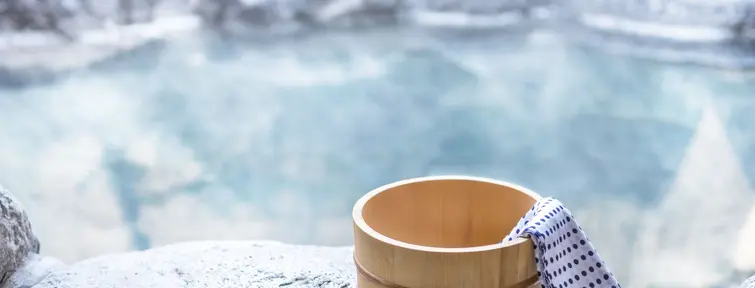
Sources thermales, "onsen"
@Keisuke Kai
What are onsen and why are they popular in Japan?
Onsen, meaning "hot springs" in Japanese, are natural springs heated by geothermal activity beneath the earth's surface. With over 27,000 hot springs scattered across the archipelago, Japan boasts a rich history and culture surrounding these mineral-rich baths that spans centuries. Soaking in an onsen is not only a beloved way to relax and unwind but also famous for its therapeutic benefits , attracting visitors from across the globe.
The tradition of onsen bathing is deeply ingrained in Japanese culture. Originally established as health retreats, these hot springs have evolved into a top tourist draw and significantly shaped the country's bathing practices. Families, couples, and friends often embark on weekend getaways to onsen towns - locations with a high concentration of hot springs and bathing facilities - to indulge in the healing waters and escape the stresses of daily life.
Types of onsen and their unique mineral compositions
Japan's onsen are classified into various types based on their mineral composition. The 19 designated chemical elements that define an onsen each offer different health benefits, colors, and even smells to the waters.
Some of the most common onsen types include:
- Sulfur onsen (硫黄泉), known for their distinct odor and milky appearance, are believed to aid in treating skin conditions and arthritis.
- Sodium chloride onsen (ナトリウム泉) have a salt content similar to seawater and are said to promote heat retention and alleviate muscle pain, cuts, and burns.
- Iron onsen (鉄泉) are characterized by a rusty color and are thought to combat anemia when consumed.
- Carbonated onsen (炭酸泉) are naturally bubbly and feel soft on the skin, offering benefits for skin ailments.
- Radium onsen (ラジウム泉) contain trace amounts of radioactive elements that may help lower blood pressure and relieve gout or circulatory issues.
The combinations of minerals in each onsen create unique soaking experiences and are frequently advertised as part of their allure.
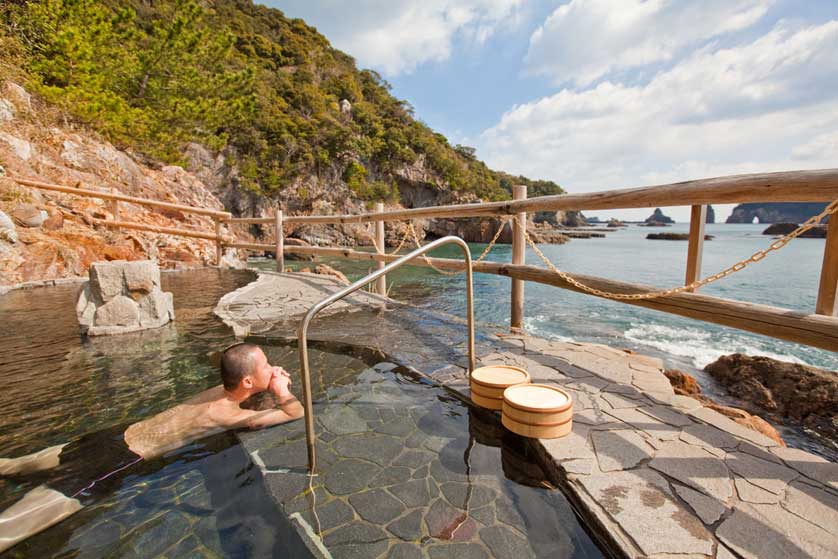
Kumano Onsen
Health benefits of soaking in onsen
Onsen have long been revered for their restorative properties , with the mineral-rich waters offering myriad health benefits. The heat of the water, which must be at least 25°C (77°F) to be classified as an onsen, promotes blood circulation and increases the body's metabolism.
The absorption of minerals through the skin is thought to further enhance onsen's positive effects. Sulfur may aid in treating skin conditions like eczema or psoriasis, while carbonic acid can lower blood pressure. Many onsen are lauded for their ability to soothe aching muscles, alleviate joint pain, and promote better sleep.
Soaking in an onsen also offers mental health benefits . The serene atmosphere and calming ritual of bathing can melt away stress, providing a meditative and rejuvenating experience that refreshes both body and mind.
Varieties of onsen experiences: indoor, outdoor, traditional and modern
Onsen come in a wide array of styles, catering to different preferences and offering varied ambiances . Traditional onsen are often housed within rustic wooden structures, featuring classic elements like shoji screens and stone baths. Modern facilities may boast sleek, minimalist designs with state-of-the-art amenities.
Many onsen offer both indoor baths (内湯, uchiyu) and outdoor baths (露天風呂, rotenburo). Indoor baths range from intimate, dimly-lit spaces to expansive bathing halls with multiple pools. Outdoor baths allow visitors to soak while immersed in nature , surrounded by lush greenery, rugged rocks, or even perched on a cliffside with ocean views.
Some onsen facilities provide additional features such as saunas, cold plunge pools, or waterfalls that massage the shoulders and back. Unique experiences like sand baths , where bathers are buried in naturally-heated sand, or steam rooms fed directly by the hot springs offer alternative ways to reap the benefits of the geothermal waters.
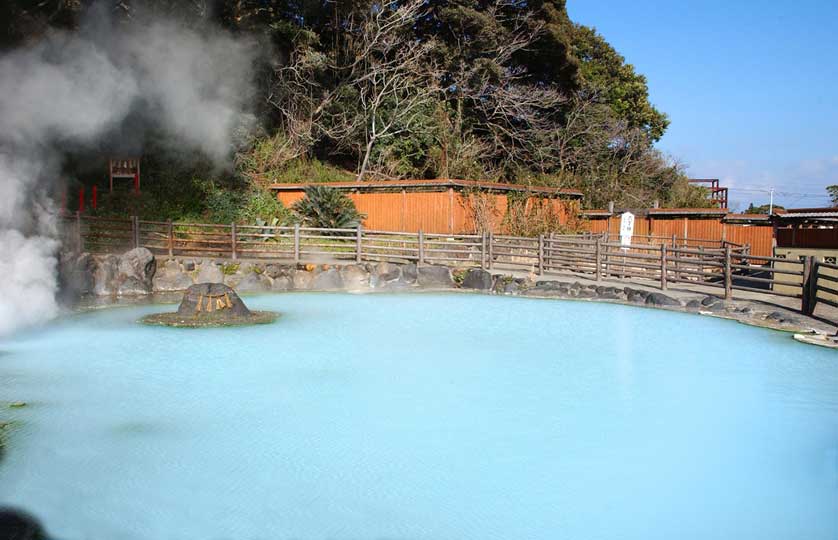
Beppu Onsen, Oita Prefecture, Kyushu, Japan
Where to enjoy onsen: ryokan, hotels and public bath houses
Onsen can be enjoyed in various settings, from traditional ryokan inns to modern hotels and public bathhouses. For the quintessential onsen experience , staying at a ryokan is highly recommended. These Japanese-style inns often feature on-site hot spring baths, allowing guests to soak at their leisure. Some ryokan even offer private open-air baths connected to guest rooms for the ultimate in privacy and luxury.
Many hotels and resorts in onsen towns also boast their own hot spring facilities, catering to visitors who prefer more Western-style accommodations. These range from simple baths to extensive spa complexes with multiple pools, saunas, and massage services.
For a more casual experience or day trip, public bathhouses (銭湯, sento) are a great option. Found in most cities and towns, sento offer a chance to soak in onsen waters without the need for overnight stays. Some popular onsen towns like Kinosaki even provide passes that allow visitors to hop between several different public baths to sample a variety.
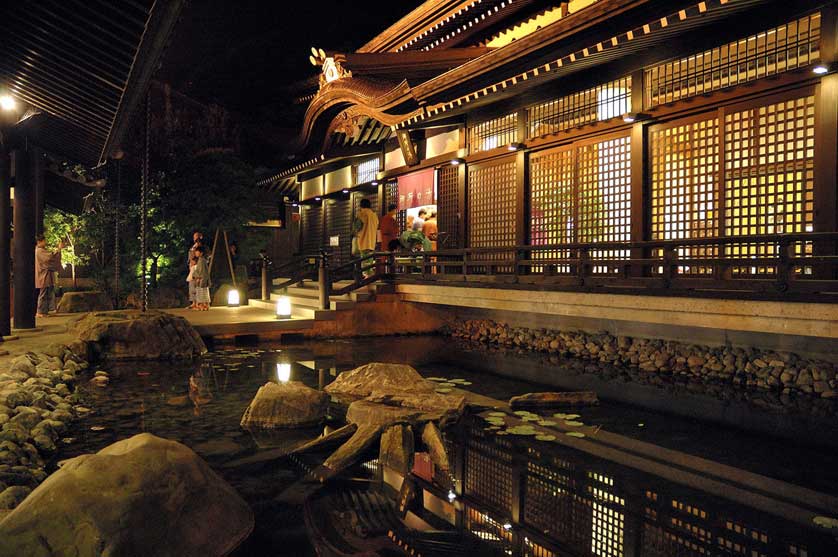
Kinosaki Onsen, Kyoto Prefecture, Japan
Etiquette and tips for bathing in onsen
Bathing in an onsen involves following certain etiquette and customs to ensure a pleasant experience for all. Most importantly, bathers must thoroughly cleanse their bodies before entering the hot spring waters. Bathing areas are typically equipped with showers, stools, and toiletries for this purpose.
Onsen are enjoyed nude , with clothing and swimsuits prohibited in the bathing areas. Male and female baths are usually separated, although some traditional onsen may offer mixed-gender bathing. A small towel is used for modesty when walking between the changing room and bath, but should not be submerged in the water.
Bathers with long hair should tie it up to avoid contaminating the waters, and it is considered impolite to let your head go underwater . Conversation should be kept quiet , and alcohol consumption before bathing is discouraged due to the risk of overheating or fainting.
When in doubt, observe and follow the lead of other bathers or don't hesitate to ask staff for guidance. By adhering to proper etiquette, visitors can fully immerse themselves in this beloved aspect of Japanese culture.
Top onsen destinations in Japan
Japan abounds with onsen towns, each offering its own unique charm and specialties. Some of the most renowned destinations include:
- Kusatsu Onsen (Gunma): Known for its high-volume, highly acidic springs and iconic yubatake where the water is cooled.
- Beppu Onsen (Oita): Famed for its "hells" or multi-colored pools, as well as abundant steam baths and sand baths .
- Hakone (Kanagawa): Easily accessible from Tokyo, offering stunning views of Mount Fuji from its many outdoor baths.
- Kinosaki Onsen (Hyogo): A picturesque town with seven public bathhouses and a charming, traditional atmosphere.
- Ginzan Onsen (Yamagata): A secluded, historical town with ryokan lining a river, creating an enchanting ambiance.
- Dogo Onsen (Ehime): One of Japan's oldest hot springs with an iconic, three-story bathhouse said to have inspired Studio Ghibli's "Spirited Away".
These are just a few of the many onsen destinations waiting to be discovered, each promising a rejuvenating escape and a deep dive into one of Japan's most cherished traditions.
Combining onsen visits with other Japanese cultural experiences
A visit to an onsen can easily be combined with other quintessential Japanese experiences for a well-rounded and immersive trip. Many onsen towns offer opportunities to don traditional clothing such as yukata (lightweight kimono) and geta (wooden sandals) while strolling the streets lined with old-fashioned shops and restaurants.
Indulging in regional cuisine is another highlight of an onsen getaway. Many ryokan pride themselves on their exquisite meals, often featuring kaiseki (multi-course) dinners that showcase local, seasonal ingredients. Some onsen even use the geothermal heat to cook specialties like onsen tamago (slow-cooked eggs) or steam buns.
Visitors can further immerse themselves in the local culture by participating in traditional activities like tea ceremonies, calligraphy, or crafting experiences often offered at ryokan or nearby workshops. Some onsen towns are also home to important cultural sites such as ancient temples, shrines, or castles, providing a chance to delve into Japan's rich history.
For those seeking outdoor adventures, many onsen destinations are nestled amidst stunning natural scenery that beckons to be explored. Hiking trails, scenic viewpoints, and boat rides allow visitors to appreciate the surrounding landscapes before soaking their weary muscles in the healing hot spring waters.
By combining an onsen visit with other cultural experiences, travelers can create a multi-faceted and unforgettable journey that reveals the depth and beauty of Japan's heritage.
Latest Articles

Hiroshima Sightseeing Loop Bus: Your Ultimate Guide to Exploring the City
The Hiroshima Sightseeing Loop Bus , locally known as めいぷるーぷ (Meipuru-pu), is an excellent way for tourists to explore Hiroshima.

Summer travel in Japan
Summer in Japan is a season of simple beauty and deep cultural significance.

Japan's most beautiful Zen gardens
The Zen garden, a true symbol of Japanese culture, fascinates the world with its pure beauty and profound meaning.
All the themes of the city

Japanese Food and Drink

Books on Japan

Japanese Movies

Japanese Language

Japanese History

Understanding Japan

Before you Travel
Please select your country on the list below:
- Switzerland
- United Kingdom
- Other countries
- 100% tailor made
- 100% value guarantee
- Expert consultant
- Ground support
- No hidden cost
- Why Tailor-made Travel ?
- Our Promise
- Responsible tourism
- Best & Reasonable Price

- Thailand and Vietnam
- Thailand and Cambodia
- Thailand Vientam Cambodia
- Vietnam and Cambodia
- Southeast Asia Tours
- Japan Tours
- Japan Family Tours
- Japan Senior Tours
- Japan Food Tours
- Japan Autumn Tours
- Japan Nature Tours
- Japan Walking&Hiking Tour
- Custom Japan Honeymoon
- China Tours
- China Guides
- Thailand Tours
- Thailand Guides
- Vietnam Tours
- Vietnam Guides
- Cambodia Tours
- Cambodia Guides
- Indonesia Tours
- Philippines Tours
- Tailor-Made Trip
- expert consultant
- ground support
- no hidden cost
- Japan Travel Guide
- Japan Onsen
Japan Onsen: The Ultimate Guide to Japanese Hot Springs
What is Onsen in Japan? Japan Onsen is the traditional Japanese hot springs , where natural mineral-rich water emerges from the earth's surface. These Japan hot springs have been cherished for centuries for their therapeutic properties, which are believed to alleviate ailments and promote relaxation. How many hot springs are in Japan? Japan has a huge number of more than 3,000 hot springs, with the springs sources number of nearly 30,000, distributed among Hokkaido Hot Springs, Tohoku Onsen, Kanto Hot Springs, Chubu Hot Springs, Kansai Onsen, Chugoku Onsen, Shikoku Onsen, and Kyushu Onsen. Here is the complete guide to the Japan Onsen hot springs, including the best place for hot springs in Japan , secret private Onsen Japan to avoid crowds , hot springs that allow tattoos in Japan , monkey hotspring Japan , recommended Japan hot spring trip , best onsen Ryokan in Japan , Japanese hot springs culture and etiquette , etc. Leave us a message for a tailored private Japan tour if you are interested in a Japanese hot spring experience.
Table of Contents
1. 16 Best Japan Onsen Destinations
2. 13 Hidden Hot Springs in Japan
3. 3 Onsens in Japan That Allow Tattoos
4. 2 Monkey Hot Springs in Japan
5. Recommended Japan Onsen Trip
6. Best Ryokan in Japan with Private Onsen
7. Japanese Onsen Culture
8. FAQs about Japan Hot Springs
1. 16 Best Hot Springs in Japan
Japanese Onsen has various health benefits, including improving blood circulation, relieving muscle tension, and even alleviating certain skin conditions. The mineral-rich waters are said to have therapeutic properties. But where is the best place for onsen in Japan ? Here are the 16 best onsens in Japan worthy of your visit.
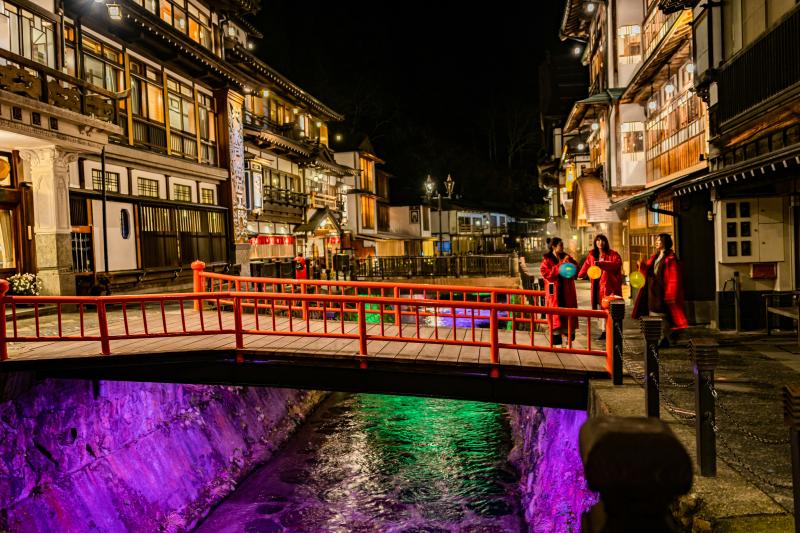
1) Ginzan Onsen Yamagata: A Representative of Yamagata Onsen
Japan Ginzan Onsen has a long history. The spring water was discovered 1500 years ago, and the area was famous for its silver mining, which led to the development of the surrounding area. After the decline of the silver mines, the population lost rapidly, but the discovery of the source of the hot springs once again started a second spring of development. The wooden hot spring houses of the Taisho period, with the white snow on the eaves, the dim lights, and the mist, are our most typical perceptions of hot spring streets in Japanese dramas or movies. The most widely known of the Oka drama "Shin", was set here, and you can enjoy Spirited Away Onsen Japan. But if you visit Ginzan Onsen in Yamagata by car, you have to pay attention to the location of the parking lot first.
Address: Ginzan Shinbazunai, Obanazawa City, Yamagata Prefecture
2) Arima Onsen Hyogo: One of the Best Onsen Resorts in Japan
Located in Hyogo Prefecture, Arima Onsen Kobe is one of the "Top Three Hot Springs in Japan" and the "Three Ancient Hot Springs in Japan" and is the most famous Kobe Onsen. During the Warring States period, Toyotomi Hideyoshi was a great fan of Arima Onsen and visited the hot springs many times, leaving a trail of footsteps.
There are five source baths and two public baths in Arima Onsen, where you can find 11 of the 13 types of hot springs in Japan. The public baths include Kinyu, a reddish-brown hot spring called Kanazumi, and Ginyu, a colorless, transparent carbonate spring, which are Onsen origins (hot springs) that have been handed down from ancient times to the present day.
Access: Kobe to Arima Onsen: Just take the Kobe Electric Railway and get off at Arima Onsen Station.
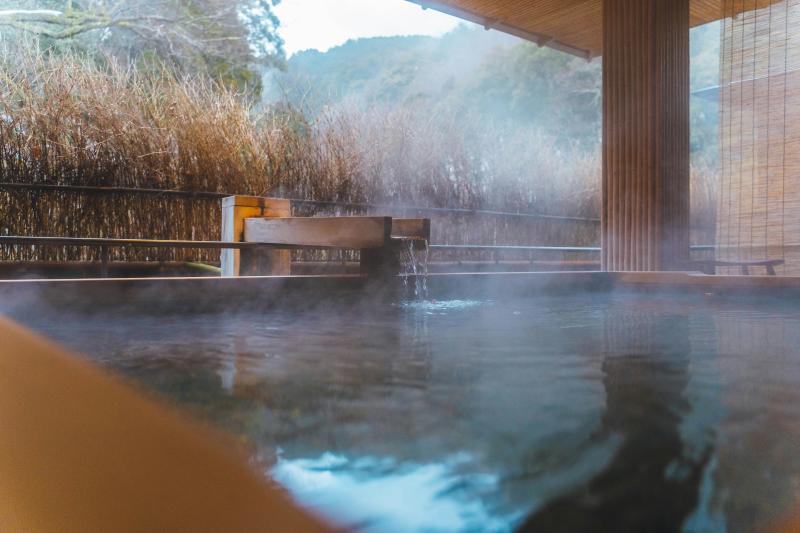
3) Kinosaki Onsen Japan: A Traditional Japanese Hot Spring Town
If there are too many tourists visiting Arima Onsen, then you can go to Japan Kinosaki, which is a little further away, located in Toyooka City, Hyogo Prefecture. Kinosaki Onsen Toyooka is the birthplace of Japanese hot spring tours and is famous for its "Seven Great Hot Spring Tours". If you stay at any local hot spring Ryokan, you can enjoy the seven outdoor baths for free, which is a rare and precious experience for any Japan Onsen trip.
There is Genbudo Park near Kinosaki Onsen Hyogo, where you can see huge rock caves formed by volcanic activity 1.6 million years ago. You can take the cable car to the top of the mountain to overlook the panoramic view of Kinosaki Hot Spring and the majestic mountains in the distance.
Access: Tokyo to Kinosaki Onsen: take the limited express Kinozaki from Kyoto Station, and you can get off at JR Josaki Onsen Station.
Kinosaki onsen from Osaka: take the limited express Kotoori from Osaka Station, and you can get off at JR Josaki Onsen Station.
Kobe to Kinosaki onsen: take the limited express Hamakazu from Kobe Sannomiya Station, and you can get off at JR Josaki Onsen Station.
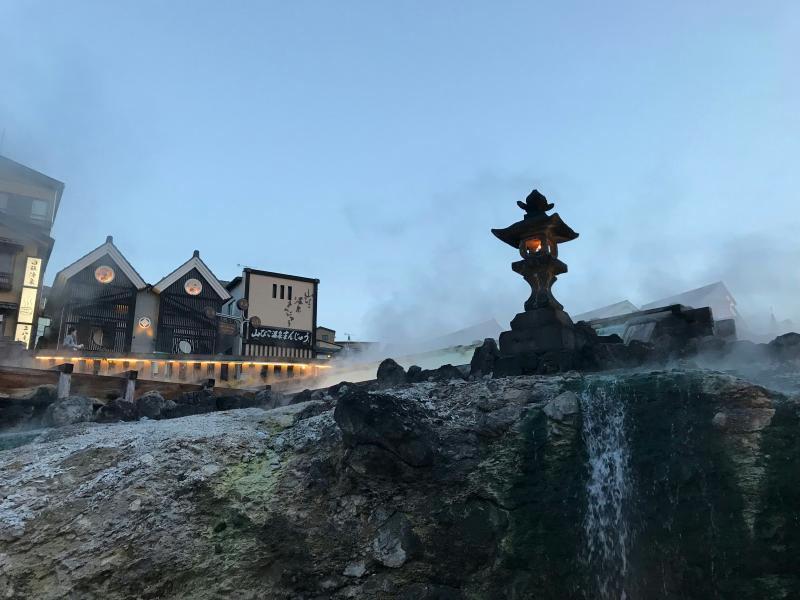
4) Kusatsu Onsen Gunma: One of the Three Most Famous Hot Springs in Japan
Kusatsu Onsen is so famous that no one in Japan is unaware of it. It is a hot spring town that boasts the highest amount of hot springs in Japan. Yubatake in the middle of the Kusatsu onsen town has become a symbol of the area and a famous tourist attraction, and there are many Kusatsu Onsen Ryokan, where you can experience the traditional culture of "yumomi". The center of Yubatake is densely populated with stores, and in addition to the Gunma Kusatsu Onsen, the area combines all the elements of sightseeing such as meals, restaurants, and souvenirs. Don't miss this place if you want to experience the essence of Japan Onsen.
Access: Kusatsu Onsen from Tokyo, you can take the high-speed bus "JR Bus Kanto Kaminushu Meiyu Yumaguri" directly to "Kusatsu Onsen Bus Terminal".
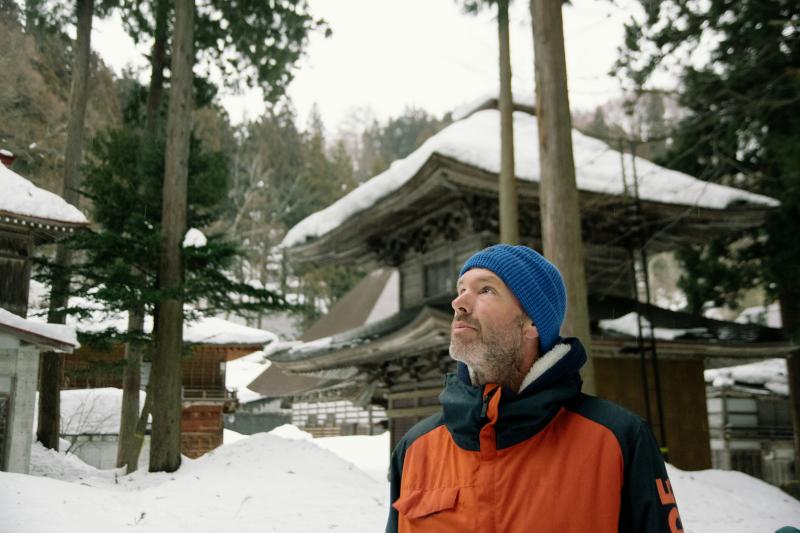
5) Nozawa Onsen Nagano: One of the Best Onsen Villages in Japan and a Ski Town in Northern Nagano Prefecture
As a hot Japan Onsen village, the first thing to do in Nozawa Onsen Japan is of course to take a bath in the hot springs. The 13 natural hot springs in Nozawa Onsen Village are maintained and cleaned by nearby communities and are open to the public free of charge. You need to bring your own towels and toiletries. The location of each hot spring in Nozawa Onsen town can be seen on the map. The ones with more distinctive environments are Onyu, Makiyu, and Nakao-no-yu. However, for short-term travelers, the baths closer to the Nozawa Onsen Ryokan where you live are fine, and they are all very nice and clean.
The flocculent float in the Nozawa hot spring is the crystallization of minerals, which is called "soup flowers" by the Japanese, not garbage, on the contrary, the more floating floats, the better the quality of the spring.
Access: You can get to Nozawa Onsen from Tokyo or Nagano, check how to get to Nozawa Onsen for more details on how to get from Tokyo to Nozawa Onsen and how to get to Nozawa Onsen from Nagano .
6) Dogo Onsen Matsuyama: One of the Three Oldest Hot Springs in Japan
Dogo Onsen Shikoku , located in Ehime Prefecture, is one of the three oldest hot springs in Japan (including Shirahama Onsen in Kagayama Prefecture and Arima Onsen in Gunma Prefecture), and is well known for having been featured in Natsume Soseki's novels, and in modern times as the setting for Ghibli's animation "The Hidden Maiden". The area around Dogo Onsen Ehime is very lively, with sightseeing spots such as Dogo Shopping Street and Togo Station. After enjoying the Dogo Onsen Shikoku, you can take a romantic stroll through the old streets.
Address of Dogo Hot Spring: 6-8, Dogo Yunomachi, Matsuyama-shi, Ehime
7) Noboribetsu Onsen Hokkaido: Natural Sulfur Hot Spring Born from Mount Hiyori
When you visit Mount Hiyori and Noboribetsu Onsen in winter, you can take advantage of the scenery to see the continuous white snow on the mountaintops, accompanied by the white smoke erupting from the active volcano, as if the earth is breathing. This magnificent natural scenery is unique to Hokkaido. Don't miss the natural Noboribetsu spring water that does not freeze at low temperatures and gurgles through the valley. And highly recommend you pay a visit to the famous Jigokudani Hell Valley, which is about a 12-minute walk from Noboribetsu Onsen.
By the way, I would like to mention Oyunuma, which is a natural and free foot bath with grayish spring water that is characteristic of the area. In the freezing cold weather in Hokkaido Noboribetsu, you can sit down and relax in the foot bath, and with the pristine woods in front of you, all your tiredness will be swept away, but don't forget to bring your own towel.
Access: Take the Michinami Bus from the bus terminal in front of Sapporo Station and get off at Noboribetsu Onsen. Or check Noboribetsu Onsen Transportation Guide for more details about Noboribetsu Onsen Bus and Sapporo to Noboribetsu Onsen.
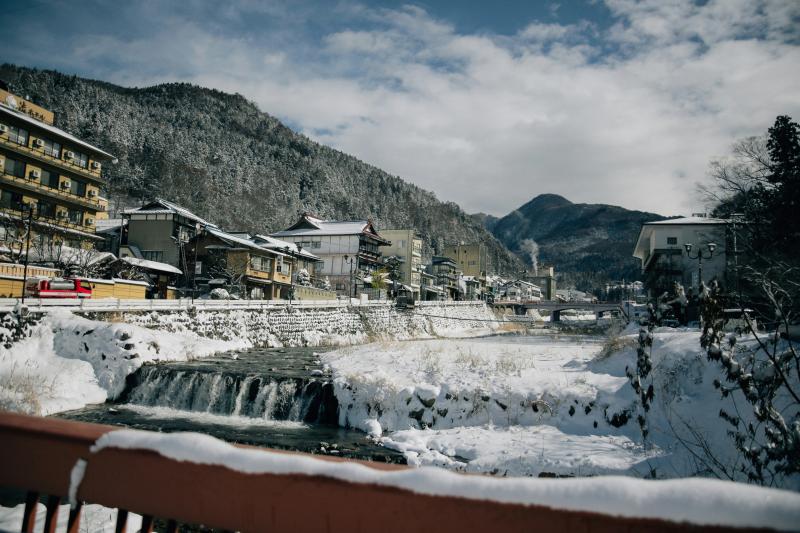
8) Shibu Onsen Japan: Experience the Shibu Onsen 9 Baths for Free
Located in Nagano, Japan, Shibu Onsen is a famous hot spring tourist attraction with a long history in Japan. The natural environment is very beautiful, surrounded by mountains and water, and there are many hot spring resources. As soon as you get off the train there, you will see the vintage-looking Yudanaka Station, which was completed in 1955, and the shape of the building gives you a meaningful feeling of anticipation for the rest of the trip. Come out of the quaint station, there is Onsen Street of Shibu Onsen Nagano, where you will find a lot of tourists and you can clearly feel the atmosphere of the people living in the area. Don't forget to experience the Shibu Onsen 9 Baths which is free of charge if you stay overnight at a shibu onsen ryokan.
Access : Transferring to the Nagano Line of the Nagano Dentetsu, a local line, at Nagano Station on the Shinkansen Line, you will arrive at the final destination, Yudanaka Station, in about 50 minutes while enjoying the idyllic scenery known as Kitashinano.
Warm Tip: Check How to Get to Shibu Onsen if you want to know about more transportation guides to Shibu Onsen from Tokyo , Shibu Onsen From Kyoto/Osaka , and Local Transportation in Shibu Onsen .
9) Hakone Onsen: A Popular Hot Spring Resort in the Kanto Region
Hakone is a popular hot spring destination in the Kanto region due to its convenient public transportation and proximity to Tokyo.
Hakone Japan Onsen has a wide variety, ranging from hot springs with a view of Mt. Fuji, to onsen Ryokan with individual private baths, to entertaining hot spring parks, to hot spring inns close to bustling shopping districts, and to one-day hot spring resorts that offer Onsen bathing services only.
Hakone Onsen Kanagawa is known as the "Hakone Seventeen Hot Springs", which refers to the hot springs located in 17 districts in Hakone, and the quality of the springs and their effects vary from district to district. For example, Tanosawa Onsen, Miyanoshita Onsen, Dogashima Onsen, and Sokokura Onsen in the northeast part of Hakone have "sodium-chloride spring water" that is effective in relieving neuralgia and skin problems. Sengokuhara Onsen has calcium-sulfate spring water, which is known as "the spring of beautiful skin". There are also Hakone Yumoto Onsen and Kowakudani Onsen , both of which are "alkaline springs," and are known for their ability to relieve neuralgia and chills. Don't miss the Hakone Yuryo Onsen and Hakone Kowakien Yunessun Japan if you want to experience more Hakone Japan hot springs.
Access: From Shinjuku Station, you can get to Hakone-Yumoto Station in as little as 73 minutes on the Odakyu Dentetsu "Romance Express" train. Alternatively, you can take a bus to Hakone Momoyendai Station in about 125 minutes.
Warm Tip: Check the Ultimate Transportation Guide to Onsen Hakone for more details on departing from Tokyo Station, from Shinjuku Station, from Kyoto Station, or from Osaka Station to Hakone Onsen Town.
10) Kyoto Onsen: More than 30 Hot Spring Villages Await You
For the best Onsen in Kyoto , you can choose Arashiyama Hanaikada Kyoto and Fufu no yu Kyoto , or Ogoto Onsen . Ogoto Hot Spring is more recommended because of its cost-effectiveness. Most of the bath services are provided by hot spring hotels, so even if you don't want to stay overnight, it's possible to choose just the bath. If your Kyoto hot springs itinerary is to stay in Kyoto for 1 night, but you want to experience the fun of a Japanese-style Kyoto Onsen Ryokan, Ogoto Onsen will be the best choice.
Although there are 3 other hot spring spots in Kyoto, including Kyoto Arashiyama Onsen , which are a bit expensive and inconvenient to get to. Ogoto Onsen Street is the closest hot spring village to Kyoto, and it's only a 20-minute drive from Kyoto Station. With a history of 1,200 years, Ogoto hot spring is located on the western side of Lake Biwa at the foot of the World Heritage Site Mount Hiei, and the view as the sun sets is breathtaking. The quality of the Ogoto Onsen is comparable to that of Japan's famous Gero Onsen, which is a great way to relax, relieve fatigue, and help improve your body in the fall and winter, as well as beautify your skin. There are only eight hot spring hotels in Ogoto, ranging from open-air baths facing Lake Biwa to cozy family-run inns run by kindly old couples.
For the Onsen Kyoto Japan beyond Kyoto city, Kurama Onsen Kyoto is very clean and not too crowded, so it's great for enjoyment, and the key is that it's also very inexpensive, and you can soak in the hot springs while enjoying the beauty of nature. Check the Top 3 Hot Springs near Kyoto for more related readings.
11) Tokyo Onsen: Enjoy the Japanese Hot Springs in the City
Hot springs are one of the symbols of Japan, and everyone wants to experience an authentic Japanese onsen when traveling to Japan. However, most Japanese hot springs are located far away from the city, in the mountains and forests, so it is not convenient to go there unless you have time to spare. In fact, there are also some hot springs in the city worth visiting. Tokyo, the capital of Japan with a population of more than 13 million, has excellent hot springs both in the city and on the outskirts of the city for you to enjoy Japanese hot spring, like LaQua, Somei Onsen Sakura, Toshimaen Niwa No Yu, Times Spa Resta, Thermae Yu , etc.
Odaiba Oedo Onsen Monogatari is very famous among Tokyo onsen , however, it was permanently closed, just please be cautious about it.
Tokyo odaiba oedo onsen monogatari is the Natural hot springs in Tokyo. It is about a 4-minute walk from the Telecom Center Station on the Yurikamome Line. The water of Odaiba Tokyo Oedo Onsen Monogatari is a natural hot spring that springs from 1,400 meters below the ground, and the quality of the spring is weakly alkaline with a hint of tawny color, which is effective in treating muscle aches and pains, sore shoulders, cold hands and feet, burns, etc.
Warm Tip: There are also some famous Onsens in Japan that are not so far from Tokyo, like Kusatsu Onsen, Hakone Onsen, Nozawa Onsen, Shibu Onsen, Takaragawa Onsen, etc. You can check the Transportation Guide to Onsen Town near Tokyo for more details.
12) Osaka Onsen: Visiting the Largest Hot Spring Theme Park in Kansai
As a hot spring area in Japan, Osaka in the Kansai region has numerous hot spring resources, and these hot springs are not only numerous in number, but also have their own characteristics, making people unforgettable when dipping in the Onsen Osaka . Therefore, if you are traveling to Osaka and hope to experience the Osaka hot spring, the Solaniwa Onsen Osaka Bay Tower is a very good choice. It is a theme park located in the center of Osaka City, and the entire spa is decorated in the distinctive style of the Japanese Azuchi Momoyama period. It offers a wide range of services, including onsen, entertainment, relaxation, and food and drink. After entering the Solaniwa Onsen Osaka Bay Tower, you can choose your favorite yukata (bathrobe) and then move around freely in the private onsen Osaka. In addition, World Spa Osaka is also a great Japan Onsen spa worthy of your visit if you hope to experience more onsen in Osaka.
13) Fuji Kawaguchiko Onsen: The Japan Hot Spring Town Closest to Mount Fuji
Kawaguchiko Onsen , with its close view of Mt. Fuji and convenient public transportation from Tokyo to Kawaguchiko, attracts many tourists. For the characteristics of the Kawaguchiko hot springs, the Onsen Fujikawaguchiko is composed of "Reiho Onsen", "Tensui Onsen", "Reimizu Onsen", "Furusu Onsen" and "Hidari Onsen" with abundant springs.
The water of Kawaguchiko Onsen is salted with calcium and carbonic acid, and is good for neuralgia, muscle pain, coldness, and fatigue.
After enjoying the Mt Fuji Lake Kawaguchiko Onsen, you can pay visits to the Sengen Shrine, Kawaguchiko Museum of Art, Yamanashi Gem Museum, Kawaguchiko Music Box No Mori Museum of Art, etc. and there are many Mt Fuji onsen hotels with great views of Mt. Fuji for you to stay overnight, such as Fujikawaguchiko Onsen Konanso, Fuji Kawaguchiko Onsen Hotel New Century, Fujisan onsen hotel Kaneyamaen and Shuhoukaku Kogetsu.
Access: You can take the "Fuji Circle" train in Shinjuku, which takes about 2 hours directly, or transfer to the "Fuji Kyuko Line" at "Otsuki" Station. You can also take direct buses at the bus stations in Tokyo, Shinagawa, and Shinjuku.
Warm Tip: Check Tokyo to Lake Kawaguchiko Transportation for more details on Tokyo to Kawaguchiko station via various transportation options, like by High-speed Bus, Private Car, Fuji Excursion JR-East, or Train + Bus.
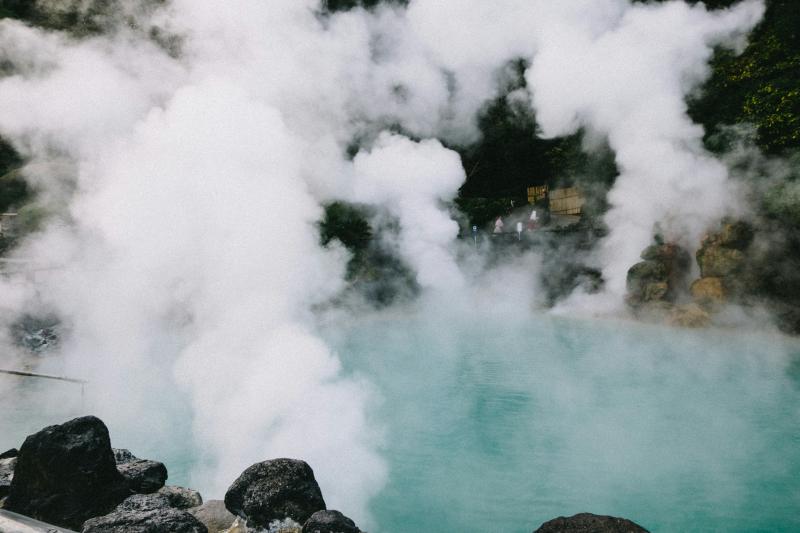
14) Beppu Onsen: A Renowned Hot Spring Resort Town in Oita, Prefecture
Beppu Onsen Japan is located in Beppu City, Oita Prefecture, northeastern Kyushu, Japan. Since the Nara Period, this area has been a famous "hot spring town" in Japan, with a wide variety of hot springs. The amount of hot springs is the second largest in the world, second only to Yellowstone National Park in the United States. The most famous Oita Beppu Onsen are the 7 hells hot springs (Umi Hell, Blood Pond Hell, Tornado Hell, White Pond Hell, Onishibozhu Hell, Kitchen Hell, and Onishan Hell), which attracts many tourists coming here to experience a Beppu Hell Tour.
Beppu Otia Onsen Address:559-1, Tekawa, Beppu-shi, Oita-ken
Warm Tip: Check the Transportation Guide to Beppu Onsen , which includes How to Get to Hells of Beppu and Beppu to Yufuin.
15) Gero Onsen: One of the Three most Famous Hot Springs in Japan
Gero Onsen Town is very well known and has a high popularity value. Gero Hot Springs is located in Gifu Prefecture in the central part of the country. If you go to Shirakawa-go or Takayama, you should stop by. Gero Onsen Japan has a history of more than a thousand years. It produces alkaline simple springs, which are helpful for rheumatic diseases and relieve fatigue.
Gero Onsen has a famous hot spring street here, which is located in the hinterland between the green mountains and green waters on both sides of Mount Hida. Almost all hot spring hotels are built on the mountains, making them very secluded. Therefore, local hotels usually have buses to and from JR stations.
Access: Take JR from Nagoya Station to Gero Station.
16) Yufuin Onsen: Kyushu's Leading Hot Spring Resort and Famous Summer Resort
Compared to the Japan hot springs introduced above, Yufuin hot spring has a medium popularity value. In addition to Beppu Hell Onsen, there is also Yufuin Onsen in Oita Prefecture. It is one of the leading hot spring resorts in Kyushu and a famous summer vacation spot, with the third largest amount of springs in Japan. The idyllic scenery complements Yufuin Onsen Oita and makes it look particularly gentle.
Access: By highway bus directly from Fukuoka Hakata Bus Stop.
2. 13 Hidden Hot Springs in Japan
Onsen bathing is deeply rooted in Japanese culture and traditions, to immerse yourself in this local cultural experience, a hidden or secret Japanese Onsen may be an ideal choice. You can avoid the crowds, and soak in the soothing hot water in the tranquil surroundings to relieve stress and promote overall well-being.
1) Atami Onsen: An Onsen Resort Town not far from Tokyo
Located in Atami City in the eastern part of Shizuoka Prefecture, Japan, Atami is also one of the famous hot spring towns in Japan.
For the characteristics of the Atami Japan Onsen: Atami hot springs feature the weakly alkaline spring that is mild to the skin, and the richness of the gushing water eases gynecological diseases, high blood pressure, and arteriosclerosis.
Facilities and Attractions: Atami Station Shopping Street, Atami Castle, Kurimiya Shrine, Jugoku Wall, Kiunkaku, etc.
Access: Atami Station is about 50 minutes from Tokyo Station on the Tokaido Shinkansen Echo. Alternatively, you can take a bus, which costs about 1,500 to 2,000 yen, but takes about 3 hours.
2) Jozankei Onsen: The Largest Hot Spring Town in Hokkaido
Jozankei hot springs are as famous as Noboribetsu Onsen and Lake Toya Onsen. It is one of the best onsens in Hokkaido . This is another leafy Japan hot springs resort, tucked away in the Shizurin Valley on the outskirts of Sapporo, and the best time to visit the Jozankei onsen Sapporo is from the end of September to the beginning of October. At this time of the year, Jyuzankei is a tranquil place where the forests are covered with colorful trees and the spring water flows in the depths of the maple leaves. The open-air Jozankei onsen Hokkaido here are extremely popular, and you can enjoy the ultimate experience of being in harmony with the beauty of the maple forest and valley.
You cannot miss the local footbath when you visit the Jozankei Hokkaido. It is said that the footbath craze that is booming in Hokkaido originated from here.
Access: About 27 kilometers southwest of Sapporo city center, accessible by bus from Sapporo Station to Jozankei Onsen (bus stop in front of Sapporo Station).
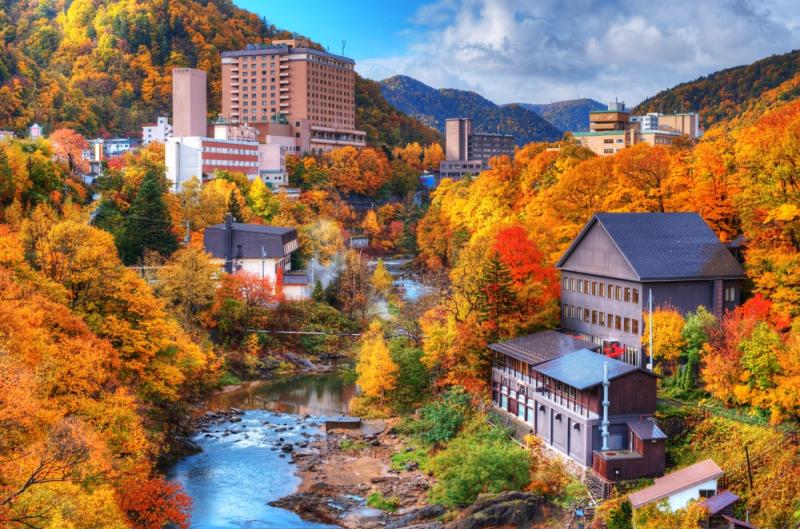
3) Zao Onsen Yamagata: One of the most Ancient Hot Springs in Japan
The opening of Zao Onsen Japan can be traced back to 1900 years ago in AD 110. It is one of the few ancient Onsen in Japan. In Zao Onsen, there are hot spring facilities that are exclusively used for soaking in the hot spring without accommodation, open-air hot springs that come with hotels, and private hot springs that are rented out. The hot spring water in Zao Hot Spring is strongly acidic with a transverse sulfur spring quality. Soaking in the hot spring water of the sulphurous transverse spring quality has the effect of rejuvenating the skin and blood vessels, as well as sterilizing and beautifying the skin. Because of the abundance of naturally occurring hot springs, the smell of sulphur floats through the Zao Onsen streets, making you fully immerse in the Japanese hot spring atmosphere. In addition to the hot springs in your hotel, you can also go to one of the professional hot spring facilities that are especially recommended for you to visit after skiing.
4) Takaragawa Onsen Gunma: Enjoy the Large Open-air Japan Mixed Hot Spring
Located in Minakami Town, Gunma Prefecture, Takaragawa Onsen is 1 hour from Tokyo by JR plus 45 minutes by Bus. For the environmental highlights of the Takaragawa Onsen Japan, there is a large open-air Japan mixed onsen. You can see snow in winter, so you can watch it while soaking in the Takaragawa Onsen Osenkaku. You can see fallen Japanese maple leaves in autumn and green leaves in summer.
Surrounding entertainment of the Takaragawa Onsen: It is very close to the ski resort and hiking routes. Many skiers come here to soak in the Takaragawa hot springs.
Takaragawa Onsen from Tokyo: Take the JR from Tokyo to Jomo Kogen Station. Or you can check How to Get to Takaragawa Onsen for more details on how to get to Takaragawa Onsen from Tokyo by train, by bus, or by car.
5) Takayama Onsen, Gifu Prefecture: Featuring 7 Hot Springs and 30 Ryokans
In addition to Gero Hot Spring, one of the three hot springs in Japan, Gifu Prefecture also has Takayama Gifu Onsen , which is also very famous among Japan hot water springs. The source of the Hida Takayama hot spring is the melting of snow in the Northern Alps, which seeps into the ground over a long period of time. In Hida Takayama Onsen, there are seven hot springs and 30 ryokans, ranging from open-air hot spring hotels with views of snow-covered mountains to Japanese-style Onsen Ryokan nestled in neighborhoods. The best onsen near Takayama include Hirayu Onsen, Fukuji Onsen, Shin-Hirayu Onsen, Tochio Onsen, and Shinhotaka Onsen in the Okuhida Onsen Area, where you can unwind in mineral waters amidst the natural scenery.
6) Yudanaka Onsen Nagano: One of the More Famous Hot Springs in the Area
Yudanaka Onsen, is located in Yamanouchi-cho, a mountainous area in the northeastern part of Nagano City. It has a long history of hot springs, and although many things have changed over the years, Yudanaka Onsen has remained true to its mountainous village roots. Upon arriving at the train station, you can immediately feel that you have entered a wonderful Japan hot spring resort, and there is a Kaede no Yu, a foot spa with flowing hot spring water, where visitors can take off their shoes and socks, roll up their pants, and place their feet in the hot spring water without having to pay for it to soothe their bodies after a long journey.
7) Shuzenji Onsen: Geothermal Spring in Japan
Shuzenji Onsen is located on the Izu Peninsula in the northern part of Izu City, Shizuoka Prefecture, and is one of the 100 hot springs in Japan. It is said that Master Kobo discovered this spring in the Heian period and built the Shuzenji Temple here. This is the beginning of the history of Shuzenji Hot Spring. In Yasunari Kawabata's "Izu Maiko", a dancer and a young man meet here, and so there is a bridge of love here, which is a romantic experience for those who go with their lovers. In the Shuzenji River flowing in the hot spring town, there is "Dokobo no Yu" which symbolizes the Shuzenji Onsen, and the bamboo path in the vicinity of Shuzenji is also a famous place for many people to take pictures.
8) Ito Onsen Shizuoka: One of Japan's Top Three Hot Spring Villages
Ito Onsen, located along the Matsukawa flowing through the center of Ito City in Shizuoka Prefecture, is one of the three largest hot spring villages in Japan (the other two being Atami Onsen and Beppu Onsen). With an output of 33,000 per minute, the area is bustling with more than 150 hotels, ranging from Japanese-style ryokan that have retained their early Showa period appearance to modern recreational hotels. There are also a number of Japanese public bath house and onsen facilities where you can go back and forth on the same day, making it easy to experience the Japan hot springs. Ito Onsen, like Atami Onsen Japan, is located on the east side of the Izu Peninsula. It is backed by a mountain and faces the sea. Every summer, it also holds a fireworks display over the sea, which is extremely romantic.
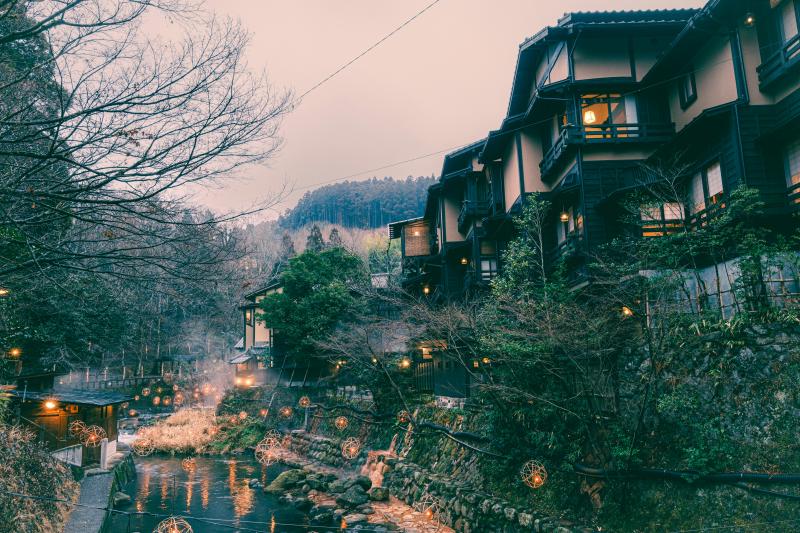
9) Kurokawa Onsen Kumamoto: The Top 1 Secret Onsen Voted for by Women in Japan
Kurokawa Onsen , located in the northern part of Mount Aso in Kumamoto Prefecture, is the premier hot spring town in Kyushu, with the highest density of hot springs in the country. Because transportation from Kumamoto to Kurokawa Onsen is not very convenient, it is a hidden hot spring holy land. If you are looking for a secret onsen place to relax in Japan, Kurokawa Hot Spring is highly recommended.
Kurokawa Onsen is a secret escape from the world. Without the hustle and bustle of tourists, it is as if you were transported back to the simple countryside of 30 or 40 years ago, with old wooden buildings and freely flowing springs that warmly greet all those who wish to purify their souls in the open-air Japanese bath. The town has 30 hot spring hotels with their own unique characteristics. You can also buy an Onsen Hopping Pass (Nyuyoku Tegata /入浴手形) to experience three other open-air Kurokawa Onsen Japan at random within 6 months, in addition to the onsen Ryokan you stay at. The Nyuyoku Tegata only costs 1,300 Yen.
How to get to Kurokawa Onsen Kyushu Japan: If you just want to go to Kurokawa Onsen, you can fly to Fukuoka and there is a direct bus to Kurokawa from Fukuoka Airport, or you can get on the bus at Hakata Station in downtown, where there is also a direct bus.
Warm Tip: You can check How to Get Kurokawa Onsen for more details on How to Get to Kurokawa Onsen from Fukuoka, Fukuoka Airport to Kurokawa Onsen, Bus from Fukuoka to Kurokawa Onsen, How Far is Kurokawa Onsen from Tokyo, and Aso Station to Kurokawa Onsen.
10) Ibusuki Onsen Kagoshima: Enjoy the Unique Ibusuki Sand Bath
Ibusuki Onsen is located in Kyushu, Kagoshima Prefecture, and is one of the most famous sightseeing spots among the Kyushu Onsen, along with Beppu and Yufuin.
The most famous hot spring in Ibusuki is the "sand hot spring", a hot spring buried in sand, which is completely different from the familiar hot spring by immersion.
The unique topography of the area has caused the flow of hot spring water underground, resulting in this special "Sand Onsen. The Kagoshima University School of Medicine has conducted research on the sand hot springs in Ibusuki. Ibusuki sand bath was found to be effective for neuralgia, rheumatism, lumbago, frozen shoulder, knee pain, post-stroke paralysis, bone fracture, chills, menopausal disorders and other symptoms.
Address: 5-25-18 Yunohama, Ibusuki City, Kagoshima Pref.

11) Nyuto Onsen Akita: A Mysterious Mixed Hot Spring in a Wonderland
Nyuto Onsen Village is located deep in the mountains of the Lake Tazawa Plateau on the border of Akita and Iwate Prefectures. You may have the impression that Japanese hot springs are "mixed bathing for men and women", right? In fact, now there are not many Japan mixed gender Onsen where men and women can bathe together. Akita Prefecture's Nyuto hot spring village is one of the few remaining traditional mixed Onsen Japan. If you go to Fukushima, Nishiyama Onsen is also a mixed-gender Onsen in Japan.
In Akita Prefecture, which has been popularized by Korean dramas, the area of Nyuto Onsen is called a hot spring village because it consists of seven onsen ryokans, each of which has different hot spring effects and facilities. After soaking in the hot springs, you can try some authentic Akita local cuisine there.
12) Hirauchi Kaichu Onsen: Outdoor Bath in Yakushima, Kagoshima, Japan
Located in the southern part of Yakushima Island, Hirauchi Kaichu Onsen has a direct view of the Pacific Ocean, and the precious spring water gushes out of the sea twice a day, so you can bathe in it about two hours after the tide goes out. The normal temperature of the Hirauchi Kaichu hot spring is only about 38 degrees Celsius. You can watch the sea during the day while bathing here, and you can listen to the sound of the tide and look at the starry sky at night. It is very enjoyable. This hot spring is more natural and interesting. It has two pools carved out of the sea. Waves will flow in from time to time when you soak there. However, this is a Japan mixed bath, and it is forbidden to wear swimsuits or underwear. Bathing in the natural sulfuric spring water with the reef and the sea in front of you, you will have the unique experience of bathing in the Pacific Ocean. You can experience both open-air foot baths and ocean hot springs in Hirauchi Kaichu Onsen.
Address: Hirauchi, Yakushima-cho, Kagoshima-ken 891-4406
13) Nasu Onsen Tochigi: A Vast Mountain Village Onsen and a Spread-out Hot Spring Resort
Nasu Hot Spring is located in the northern part of Tochigi Prefecture, on the upper reaches of the Nakagawa. The rolling plateau at the foot of Nasu volcano is dotted with seven hot springs including Yumoto Hot Spring, Takakuma Hot Spring, and Daimaru Hot Spring. Among them, "Shikanoyu" is said to be the first to be discovered. It is said that about 630 years ago, a deer shot by a hunter was cured by soaking in the hot spring, and the hot spring got its name from this beautiful story. In the past, this area was a hot spring resort that was centered around the public bathhouse "Shika no Yu". Nowadays, high-end hotels and large leisure resort have been built, and it is very popular as a hot spring area for tourists visiting Nasu.
3. 3 Onsen in Japan with Tattoos
Is there any Japan Onsen that allow tattoos ? Most of the Japanese Onsen may have rules on tattoos, and you may need to ask for the permission to Onsen. Fortunately, there are a few hot springs in Japan that allow tattoos, including the following 3 tattoo-friendly Onsen in Japan.
1) Fureai Onsen Yata: Public Bath in Osaka with Natural Hot Spring
Fureai Onsen Yata stands as a serene haven, a public bath where the local community converges in an atmosphere of relaxation, uniquely inclusive of individuals adorned with tattoos. Despite its public nature, the defining feature lies in its natural hot spring source, triumphantly unearthed for the first time in Osaka city in 1988. Offering a spectrum of bathing experiences, including open-air, electric, cold, and jet baths, the facility extends its appeal with a complimentary outdoor footbath. In essence, Fureai Onsen Yata seamlessly blends indoor and outdoor tubs, both enriched with the restorative essence of natural spring water. Modern amenities and an affable attitude towards tattoos characterize this onsen, complemented by dining options to enhance the overall experience.
2) Healthy Spa Tateba: Public Bath in Osaka with Great Experience of Japanese Culture
Situated conveniently in Osaka City, Healthy Spa Tateba is a tattoo-friendly onsen that stands out for its accessibility. It's an ideal choice for those exploring Osaka, offering various baths, including a cold plunge bath, and amenities such as a steam room—all covered in the standard entry fee, saving extra costs for the sauna.
Known for its popularity among locals, Healthy Spa Tateba provides an authentic onsen experience. The availability of an English support leaflet caters to international visitors, while rental towels and amenities add to the overall convenience.
For foreign visitors, Healthy Spa Tateba offers seamless English support and affordable, delicious food options after enjoying the baths. It provides a glimpse into Japanese culture, ensuring a secure and enjoyable experience, especially for solo female travelers. With a focus on catering to the needs of foreigners, Healthy Spa Tateba promises a well-rounded and culturally enriching visit.
Also check onsen in Osaka that allow tattoos for more tattoo onsens options in Osaka.
3) Hōheikyō Hot Spring: A Great Outdoor Hot Spring in the Snow
Hōheikyō Hot Spring in Sapporo, Hokkaido, is a tattoo-friendly onsen with a beautiful mountain view, especially enchanting in winter with a snowy landscape. The mix of cold weather, mountain breezes, and warm water offers a unique and memorable experience. The outdoor pool maintains a pleasant temperature of 39 to 41 degrees Celsius, adding to the charm. Indoors, there's another inviting pool with convenient shower stations. Visitors use lockers and can rent towels on-site or bring their own. After a soak, a cozy sitting area with heated flooring awaits, and a vending machine provides beverage options.
Hōheikyō Hot Spring is not just a soak but an essential part of any Sapporo trip. The natural beauty of its outdoor pools is unparalleled, offering tranquility and stunning views.
While a bit far from central Sapporo, it's easily accessible by bus, particularly the Kappa liner from the Sapporo bus terminal. However, be mindful of the bus schedule, especially for the return trip, as the last bus departs in the early evening.
If you look for Onsens in Tokyo that allow tattoos, we will try our best to find more Japan hot springs tattoos.
4. 2 Monkey Hot Springs in Japan
Where are the hot spring monkeys in Japan for visitors to see monkeys bathing in the Onsen? Have you ever imagined soaking with Japanese snow monkeys in Japan monkey hot springs? Let's make it realized for you.
1) Jigokudani Hot Spring: An Outdoor Monkey Onsen Can Look Straight to the Snow Monkey Park
Nagano Jigokudani Onsen is one of the famous hot springs located in the Yudanaka Onsen area and is known for the monkeys that bathe in the hot springs in winter. This is the only natural attraction in the world where you can see wild monkeys soaking in the hot springs.
The Japanese monkeys initially only bathed in hot springs out of imitation, but after experiencing the comfort of soaking in hot springs when the weather was freezing, they gradually developed the activity of bathing in hot springs into a habit. Currently, there are about 160 monkeys living around the Japan monkey hot springs. On snowy days, the monkeys go into the bath together in the Nagano monkey hot spring, with their heads covered in snow, their faces flushed red, their eyes half-closed, and their faces cozy and very cute.
This group of monkeys is considered to be the most enjoyable monkeys in the Hokkaido Monkey Hot Spring, and in the 1970s they were featured on the cover of the American magazine Life. Nowadays, more than 100,000 people come to Jigokudani Hot Spring every year to watch the Japan monkey bath.
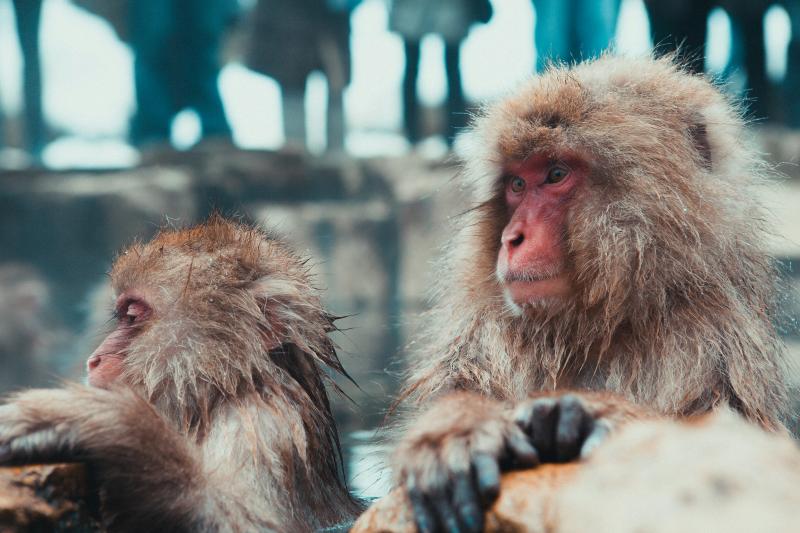
2) Yunokawa Onsen Hakodate: Seeing the Monkey Jumping into the Hot Spring
Yunokawa Onsen, located just five minutes by car from Hokkaido Hakodate Airport, is the closest hot spring resort to the airport in Japan, and it is very close to downtown Hakodate, so it is a good place to plan a one-day Japan Onsen trip. Not only is it conveniently located, but it is also one of the famous hot springs in the "Top 100 famous hot springs" and one of the three famous hot springs in Hokkaido, along with Noboribetsu Hot Spring and Jozankei Hot Spring. Hakodate Yunokawa Onsen is highly recommended for those who want to visit Hakodate and enjoy the Hokkaido hot spring at the same time.
Yunokawa Hot Spring has a history of over 350 years. It is a chlorinated spring, which is good for beauty, as well as cold limbs, nerve pain, and sore shoulders, so it's a good place to visit if you want to get rid of fatigue during your trip to Japan.
Yukura Shrine is a famous sightseeing spot around Yunokawa Onsen, as well as a great place to take photos. The historical shrine houses about 90 Japanese macaques in the tropical botanical garden "Saruyama Onsen", which is highly regarded as a place where you can see monkeys comfortably bathing in the hot springs. And you can see the monkeys jumping into this Hakodate Monkey Onsen, which is definitely an image you will want to take a picture of.
Now do you have a burning desire to visit Japan hot water springs? Find an Onsen spa of your choice for a comfortable soak and encounter one of these hot springs monkey Japan.
As we have shared the best place for hot springs in Japan, if you are yearning to experience the thrilling Japanese Onsen, why not embark on our Japan hot spring trip? Contact us for a private tour with a private guide , private car transfer , and tailored itinerary .
5.1 Kyushu Onsen Culture Tour 7 Days
Quick Access>>> 7 Days Fukuoka-Nagasaki-Itoshima-Kumamoto-Mt. Aso-Kurokawa-Yufuin-Beppu Tour
This 7-day hot spring tour in Kyushu features a diverse and immersive onsen (hot spring) experience, offering a blend of traditional and modern settings across various locations in Japan.
Summary of 7-Day Kyushu Hot Springs Tour
● Days 1-3: Fukuoka (Dazaifu Tenmangu Shrine, Kyushu National Museum, Ichiran no mori, Oyster hut, Wedded Rocks)
● Day 4: Nagasaki (Nagasaki Peace Park, Nagasaki Atomic Bomb Museum, Shinchi Chinatow, Inasayama Observation Deck)
● Days 5-6: Mt. Aso and Onsen (Yanagawa River Descending, Mount Aso, Yunotsubo Kaido, Hells Beppu)
● Day 7: Fukuoka Exit
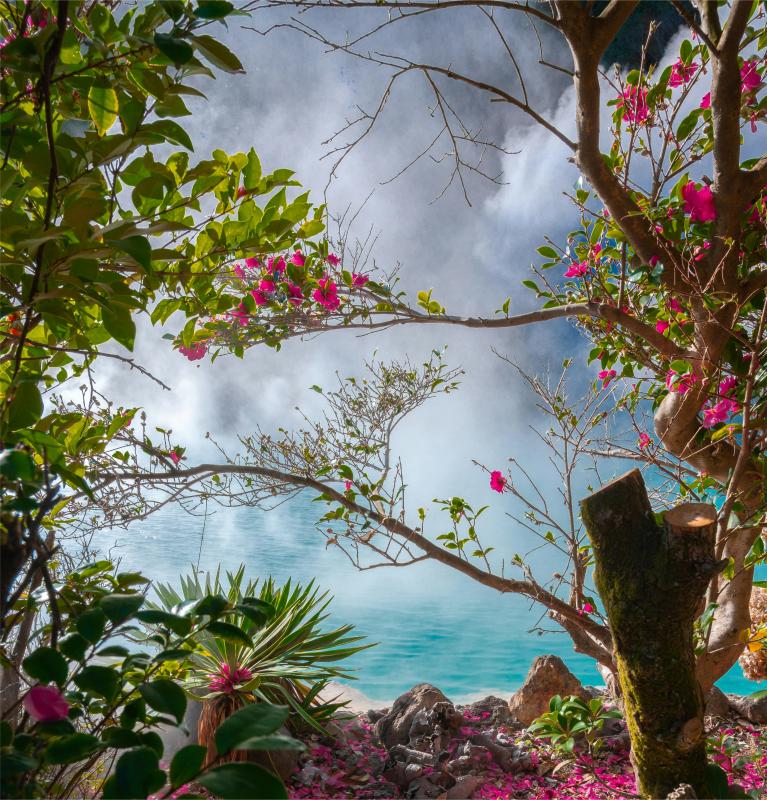
Detailed Itinerary of the 7-Day Japan Hot Spring Trip
● Day 1: Arrival at Fukuoka
-Transfer to Hotel: Enjoy hassle-free transportation between the airport and your hotel in Fukuoka.
● Day 2: Fukuoka Highlights
-Dazaifu Tenmangu Shrine: Visit one of Japan's most significant Tenmangu Shrines, dedicated to Sugawara Michizane.
-Kyushu National Museum: Explore Japan's fourth national museum, known for its unique architecture and cultural exhibits.
-Nanzoin Temple: Witness the world's largest bronze statue of a reclining Buddha.
-Canal City Hakata: Shop and dine in this vibrant entertainment complex with over 250 shops, restaurants, and attractions.
● Day 3: Itoshima Exploration
-Ichiran-no-mori: Indulge in freshly made noodles at Japan's unique noodle workshop/store.
-Meoto Iwa: Experience the sacred rocks connected by a shimenawa rope representing husband and wife.
-Oyster Hut: Enjoy fresh seafood in a relaxed atmosphere at Silk Island.
-Shiraito Waterfall: Discover the picturesque Shiraito Falls on the Itoshima Peninsula.
-Fukuoka Tower: Ascend Japan's tallest seaside spire for breathtaking views of Fukuoka.
● Day 4: Nagasaki's Culture
-Nagasaki Peace Park: Pay tribute to the victims of the atomic bombing at this tranquil memorial.
-Nagasaki Atomic Bomb Museum: Gain insight into the impact of the atomic bomb on Nagasaki.
-Glover Garden: Explore historic Western-style residences in this open-air museum.
-Shinchi Chinatown: Delight in Nagasaki's oldest Chinatown and savor its renowned cuisine.
-Inasayama Observation Deck: Marvel at panoramic views of Nagasaki from atop Mount Inasa.
● Day 5: Kumamoto and Mount Aso Adventure
-Yanagawa River Descending: Cruise through Yanagawa's waterways, known as "the city of water."
-Kumamoto Castle: Explore one of Japan's most impressive castles with extensive grounds.
-Mount Aso: Experience the active volcano's vast caldera and breathtaking scenery.
-Kusasenri: Enjoy the iconic view of the emerald green grassland plateau atop Mount Aso.
● Day 6: Yufuin and Beppu Discovery
-Kokonoe Yume Otsurihashi Bridge: Walk Japan's longest pedestrian bridge for stunning views.
-Yunotsubo Kaido Street: Stroll through Yufuin's charming hot spring town with traditional shops.
-Lake Kinrin: Witness steam rising from the lake's surface and enjoy its tranquil surroundings.
-Hells Beppu: Explore Beppu's famous hot springs and natural wonders known as the "Seven Hells."
● Day 7: Departure
-Conclude your trip with convenient transportation from your hotel to Fukuoka airport.
While the itinerary primarily focuses on cultural, historical, and scenic attractions, it includes opportunities to experience onsen culture in Yufuin Onsen Oita and Beppu Hot Springs , Kurokawa Hot Spring , Fukuoka Onsen as well as potential relaxation options in other locations such as Nagasaki Hyogo .
▲Warm Tip: For more itinerary ideas on the Japan Onsen trip, or if you would like to spend 2 weeks in Japan to experience the Japanese hot springs, feel free to check out the 2-Week Onsen Tour Japan Itinerary Inspiration .
5.2 Trip to Japan Cost
How much would it cost to travel to Japan? How much is Onsen in Japan? The cost of visiting an onsen in Japan can vary depending on various factors such as location, facilities, and time of visit. Generally, the Japan onsen price for entry typically ranges from a few hundred yen to a few thousand yen per person . Some high-end resorts or Ryokans (traditional Japanese inns) may charge more for access to their exclusive Onsen facilities. Additionally, there might be extra charges for amenities such as towels or rental yukatas (Japanese robes), and the hot spring tax of around JPY 150 per guest per night is requested to be paid at the hotel front desk. And here is our cost of a trip to Japan for your reference.
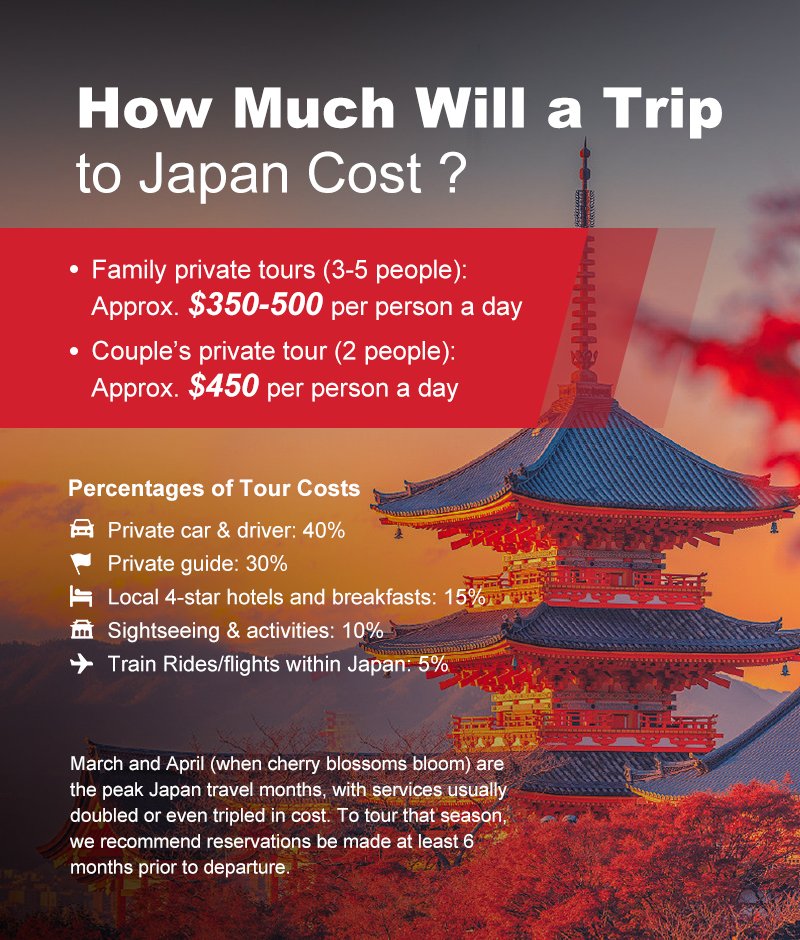
Japan Onsen bath during cherry blossom season is an amazing experience, but services usually are doubled or even tripled in cost. If you plan a Japan hot spring tour during the Sakura season , you are suggested to make the reservations at least 6 months before departure.
6. Best Ryokan in Japan: Japan Ryokan with Private Onsen
Almost all hotels in Japan offer hot spring baths, both Japanese and Western style. However, only hot spring hotels offer Japan natural hot springs. Ordinary hotels offer Japanese public bath house called “big Fero”, which can satisfy the hot feeling of "soaking in a hot spring", but they are not the same as "Japan natural Onsen" and do not contain the minerals found in Japan natural springs.
Since the development of hot spring hotels, there have been three room styles emerged: Ryokan, Western, and Modern. The Ryokan is the most traditional Japanese-style room, the Western style is a room with facilities similar to those of a business hotel, and the Modern style is mainly Japanese-style, but with beds instead of tatami mats. Visitors can choose their own according to their needs.
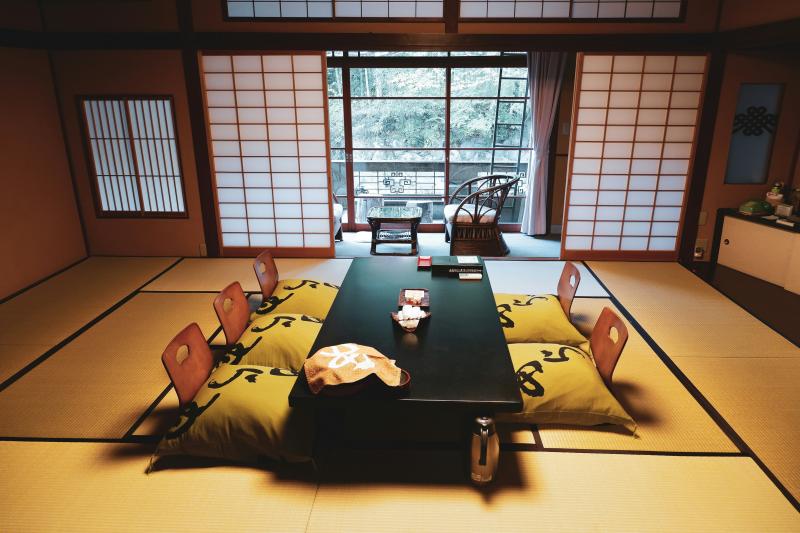
Here are the best Onsen Ryokan Japan, where you can experience the Hakone Ryokan Onsen, private Onsen Kyoto, Takayama Ryokan private Onsen and Kawaguchiko Onsen Ryokan, from which you will experience the ultimate integrated 360° Japanese service , comfortable hot springs , and a full sense of dining ritual .
7. Japanese Onsen Culture
Experiencing the Onsen is one of the top things to do in Japan . To fully enjoy the Japanese hot springs, it is better for you to learn about the things about Japanese Onsen, including the Onsen history and culture, the Onsen etiquette, and tips and reasons why Japanese people love Onsen bath.
7.1 What Makes Japan Onsen So Popular
Soaking in Japanese hot springs is a unique and tranquil experience that goes beyond just physical relaxation. The sensation is often described as incredibly soothing and rejuvenating. Here are the reasons why Onsen in Japan is so special and popular.
Natural Healing Properties: Many hot springs in Japan are located in geothermally active areas, resulting in mineral-rich hot spring waters. The minerals, such as sulfur, radium, and carbon dioxide, are believed to have various health benefits, including improved circulation, relief from muscle and joint pain, and skin rejuvenation.
Cultural Tradition: Onsen bathing is deeply ingrained in Japanese culture and has been a traditional practice for centuries. It is not just about physical health but is also seen as a way to relax, socialize, and connect with nature. Onsen experiences often involve a specific bathing etiquette, including thoroughly cleaning oneself before entering the communal baths.
Scenic Locations: Many onsens are situated in picturesque natural settings, surrounded by mountains, forests, or near the coastline. This creates a tranquil and serene atmosphere that enhances the overall experience of relaxation and rejuvenation.
Seasonal Appeal: Onsens can be enjoyed throughout the year, and each season brings its own charm and provides a unique experience. Soaking in a hot spring during the winter while surrounded by snow, or in the fall with colorful foliage, or under cherry blossom in spring adds an extra layer of beauty and enjoyment to the experience.
Variety of Bathing Facilities: There are various types of onsens in Japan, including outdoor baths (rotenburo), indoor baths, and mixed-gender or gender-separated facilities. Each type offers a unique experience, and visitors can choose based on their preferences.
Ryokan Experience: Many hot springs are connected to traditional Japanese inns called "ryokan." Staying at a ryokan provides a complete cultural immersion, combining onsen bathing with traditional Japanese hospitality, tatami rooms, and kaiseki cuisine, and yukata (traditional Japanese robes) to wear to the baths.
Overall, the feeling of soaking in Japan's Onsen combines physical relaxation, stress relief, cultural appreciation, and a connection with nature, providing a holistic and rejuvenating experience for both body and mind. And it is a calming experience when you soak in Japanese hot springs.
7.2 Why Japanese People Love About Onsen
How much do the Japanese love hot springs? Japanese people really love and enjoy soaking in the Onsen. In almost every Japanese television drama, there are such sequences: family vacations, girlfriends' talks, colleagues' gatherings, and even business talks are chosen at hot spring spas! They regard soaking in hot springs as a ritual. This love on hot spring is inseparable from the country's innate advantages. Japanese people are very bold when it comes to bathing in hot springs and like to soak naked. They believe that by taking off clothes, class relations are taken off. Without restraints, even people who do not know each other can communicate, and people who are familiar with each other become closer.
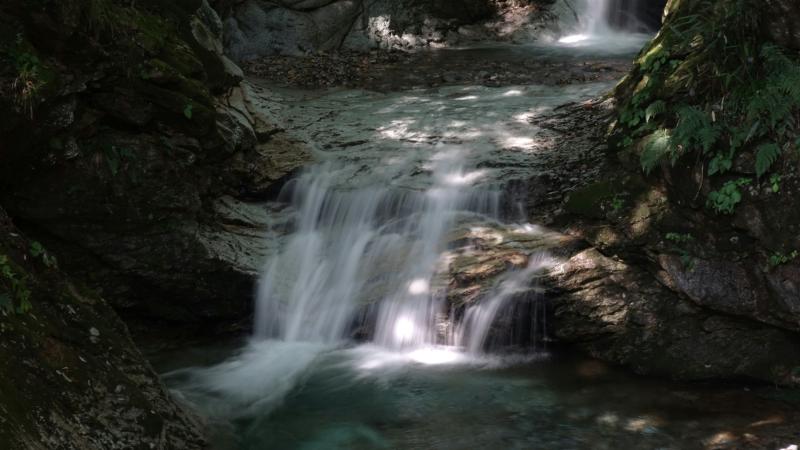
7.3 History and Culture of Bath House in Japan
"Sento" (or public baths) can be found all over Japan, and their history dates back to the Heian Period. The earliest Japanese public bath house in Edo (now Tokyo) is said to have been built in 1591 and grew in popularity. After World War II, when many households did not have bathing facilities, the bathhouse culture began to flourish and by 1968 there were over 18,000 bathhouses throughout Japan. Unlike Japan natural hot springs, traditional Japanese bath house does not usually use natural spring water. People go to bathhouses to communicate with local residents, or they go to bathhouses to enjoy bathing time because their homes have simple bathing facilities.
Although the number of bath house in Japans is not as high as it was in the heyday of the hot springs, in recent years, Japanese bathhouses have come up with a variety of creative ideas, such as paintings of Mt. Fuji or famous Japanese sightseeing spots on the walls, as well as electric baths, Kuroyuki-onsen hot spring baths, and herbal baths, to provide a more enjoyable bathing experience than ever before.
7.4 Japanese Onsen Etiquette and Tips
How to use Japanese hot springs? Japanese bathhouses use the kanji characters for "male" and "female" to differentiate between male and female areas, please follow the hot spring etiquette of not splashing or making a lot of noise when entering the bath.
1) When bathing in a hot spring in Japan, please follow the correct order of bathing. Wash your body in the public shower area before entering the hot spring pool, and do not scrub in the pool to avoid soiling the water. Before entering the bath, please use the restroom, which is usually located in or in front of the locker room.
2) Most bathhouses in Japan do not have toiletries, so please remember to bring towels, soap, etc.; even if you forget to bring them, you can buy them at a low price at the Japanese bathhouse.
3) Japanese hot springs are for the comprehensive purpose of bathing, recuperation, and relaxation, and their entertainment value is relatively weak. Most Japanese hot springs are nude baths, so you can't wear a bathing suit when soaking in the Japan hot spring.
4) Photographs are not allowed in the public baths of hot spring hotels, so please do not bring your camera into the onsen.
5) Avoid taking a Japanese onsen bath on an empty stomach or after a meal, as this can cause anemia or indigestion.
6) Please replenish water to prevent dehydration when you experience the Japan onsen hot springs. Do not soak for more than 10 minutes at a time, come out to take a shower and take a rest, drink some water, and then continue to soak; the elderly or people with heart disease should not soak in the Japan onsen spa for a long time.
7) In Japan, it is customary to drink a bottle of cold milk after bathing in the hot spring to refresh your body after relaxing. If you need a hot drink, you can boil water in your Japan Ryokan with a private onsen or buy it from a vending machine, convenience store, or hotel supermarket.
8. Frequently Asked Questions about Japan Hot Springs
Q1: Can You Go to Hot Springs in Japan with Tattoos
Are tattoos allowed in Japanese onsen? In Japan, there is a cultural association between tattoos and the yakuza (organized crime syndicates), which has led to some onsen (hot springs) establishments implementing rules against allowing people with tattoos to enter. However, attitudes towards tattoos are gradually evolving, and some onsen now accept guests with tattoos, particularly if they are small and can be covered with a bandage or adhesive patch. You can inquire directly with the onsen staff about their tattoo policy when making a reservation or upon arrival. If you have a small tattoo, you may still be able to visit certain onsen in Japan. And we have listed 3 Tattoo-Friendly Onsen in Japan that explicitly welcome guests with tattoos.
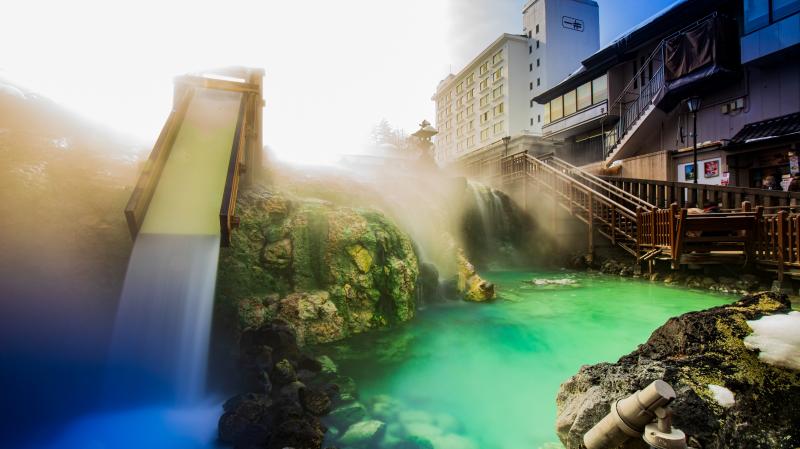
Q2: How Hot are Japanese Hot Springs?
The temperature of Japanese hot springs (onsens) can vary widely, and it depends on the specific onsen and its location. Japanese Onsen temperatures typically range from around 37°C (98.6°F) to 42°C (107.6°F). Some Onsens in Japan may have temperatures outside of this range, Some onsen resorts offer multiple baths with different temperatures, allowing visitors to choose the one that suits their preference. And it's essential for bathers to be aware of the water temperature of the Onsen Japan before entering.
Q3: Can Foreigners Visit Ginzan Onsen in Japan?
Yes, foreigners can visit Ginzan Onsen in Japan. Japan is generally welcoming to tourists from around the world to experience its unique hot springs, and Ginzan Onsen is a tourist destination that attracts visitors from various countries. Ginzan Onsen is a popular hot spring resort located in the mountains of Yamagata Prefecture. It's a picturesque village with historic buildings lining the riverbanks, creating a beautiful atmosphere, particularly in the winter when snowfall adds to its charm.
Q4: How Do Hot Springs Work in Japan?
In Japan, hot springs, or onsens, are an essential part of the culture, and using them involves a specific process. Upon arriving at an onsen facility or traditional inn (ryokan), visitors check in and find separate bathing areas for men and women. Before entering the communal hot spring, guests must thoroughly wash and rinse their bodies at the provided showers to maintain cleanliness. After showering, individuals can enter the onsen, choosing a pool with a comfortable temperature. It's customary to keep hair out of the water and to refrain from bringing large towels into the onsen. While in the onsen, visitors can relax in the soothing warm water, keeping noise to a minimum. After enjoying the onsen, a final rinse is required before returning to the changing area. Some onsen facilities provide small towels for modesty, and it's important to be aware of specific rules or instructions at each location. Overall, onsen bathing in Japan is a tranquil and rejuvenating experience deeply rooted in cultural traditions.
Q5: What Is the Difference between Ryokan and Onsen?
These two words are often conflated together because most people enjoy hot springs in a traditional Japanese inn setting. A Ryokan is a traditional Japanese inn where you can experience Japanese culture and hospitality, while an onsen is a hot spring where you can soak in the natural mineral water and relax.
Q6: Are Onsens Mixed Gender?
In Japan, most onsens have separate areas for men and women. This separation ensures privacy and comfort while bathing. However, there are some places where mixed-gender bathing is allowed, such as Takaragawa Onsen in Gunma, Nyuto Onsen in Akita, and Nishiyama Onsen in Fukushima.
In Japan, hot springs are suitable for all seasons of the year. Soaking in Japanese hot springs in spring, you can get rid of the winter coldness in the body; in summer get rid of the moisture in the body, while in autumn and winter build up your body's resistance and prepare for the coming dry weather. Tell us your travel date to plan a private guided Japan onsen trip now.

- Why trailor-made travel?
- our promise
- responsible tourism
- best & reasonable price
- Philippines


Onsens: The Ultimate Guide to Japan’s Natural Hot Springs
Onsens, or Japanese hot springs, are a beloved part of Japanese culture and a must-visit destination for locals and tourists alike. These natural hot springs are known for their relaxing waters and are steeped in tradition, making them a unique and fascinating experience for visitors to Japan.

Onsens are typically located outdoors, although many inns now have indoor facilities as well, and can be found throughout the country in various resort towns.
While visiting an onsen can be a wonderful and rejuvenating experience, it’s important to be aware of the dos and don’ts of onsen etiquette. For example, swimming, jumping, and other similar activities are not allowed in the onsen, and bathers are expected to be considerate of other patrons. When entering the bath, it’s customary to begin by slowly dipping your toes in the water to avoid rapid changes in body temperature and blood pressure.
What are Onsens?
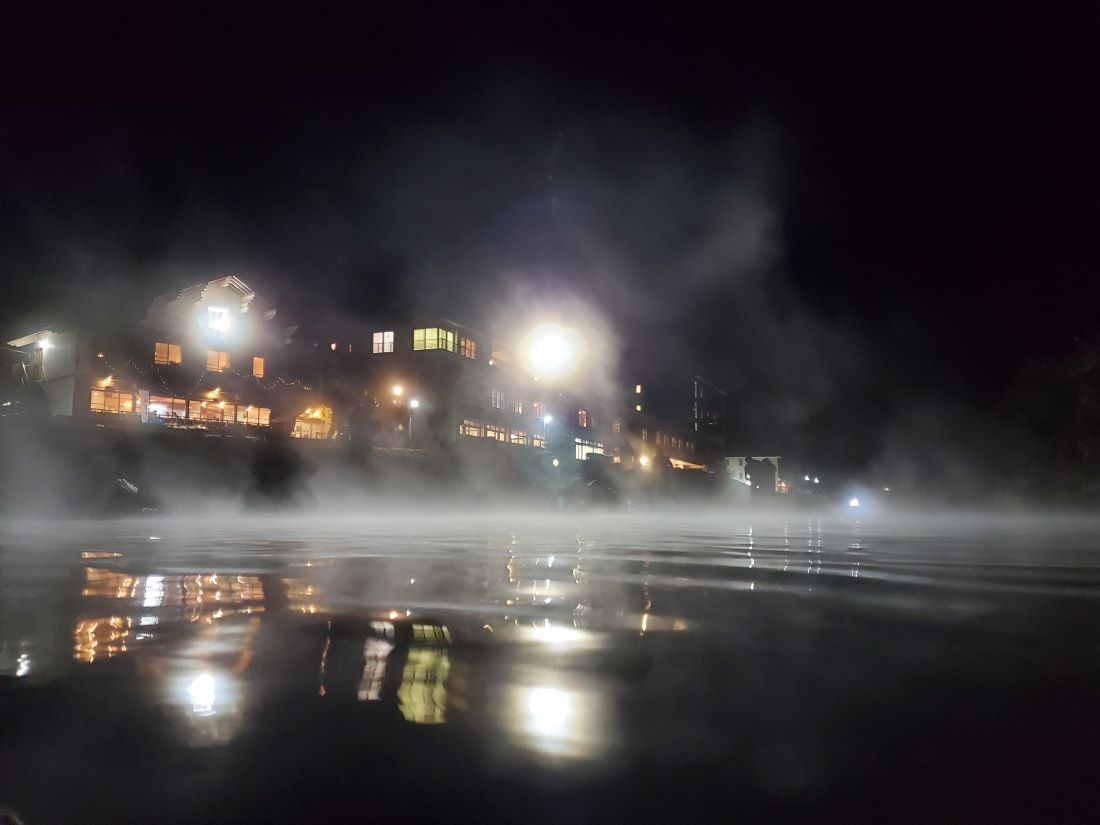
Onsens are traditional Japanese hot spring baths that are believed to have healing properties. These baths are an important part of Japanese culture and are known for their therapeutic benefits. Onsens are often located in picturesque natural settings, such as mountains, forests, or near the sea.
The water in onsens comes from geothermal springs and is rich in minerals such as sulfur, calcium, and magnesium. The temperature of the water can range from warm to hot, and it is said that soaking in the water can help relieve stress, improve circulation, and alleviate muscle and joint pain.
Onsens can be found throughout Japan, and there are many different types of onsen baths, including outdoor baths, indoor baths, and mixed-gender baths. Some onsens are attached to ryokans, which are traditional Japanese inns, and offer a complete cultural experience for visitors.
It is important to note that there are certain etiquette rules that visitors must follow when visiting an onsen. For example, visitors must thoroughly wash their bodies before entering the bath, and tattoos are generally not allowed due to their association with the Yakuza, a Japanese organized crime syndicate.
History of Onsens
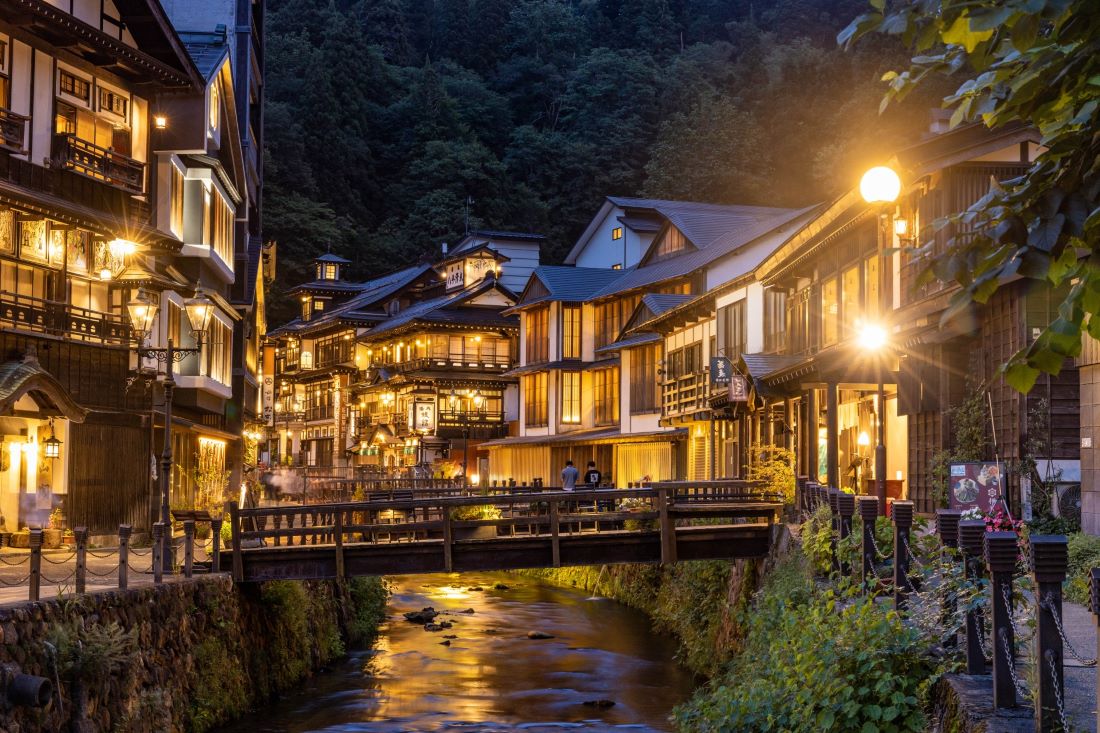
Onsen, or hot springs, have been an integral part of Japanese culture for centuries. The earliest records of onsen use date back to the 6th century, where they were used for purifying rituals in the Shinto religion and enjoyed by emperors.
The onsen culture continued to evolve over the centuries, with mixed-sex baths known as konyoku onsen being commonplace across the country. However, this changed in the 20th century as Westerners arrived in Japan and perceived mixed-baths as crude. The Meiji government began segregating public baths, leading to the decline of konyoku onsen.
Despite this shift, the popularity of onsen continued to grow. The naturally heated spring water is said to have healing powers due to its mineral content, and onsen were built throughout Japan to take advantage of this natural resource. Traditionally, onsen were built outdoors, but in recent years, more indoor onsen have been built at newer establishments.
Types of Onsens

Onsens come in many types and shapes, including outdoor and indoor baths. Baths may be either publicly run by a municipality or privately, often as part of a hotel, ryokan, or bed and breakfast. Here are some of the most common types of onsens:
- Sulphur onsen: These onsens are rich in sulfur and have a distinct smell. They are believed to have healing properties for skin conditions such as psoriasis and eczema.
- Sodium chloride onsen: Also known as saltwater onsens, these are believed to have a relaxing effect on the muscles and help improve circulation.
- Hydrogen carbonate onsen: These onsens have a high concentration of hydrogen carbonate and are believed to have a cleansing effect on the skin.
- Iron onsen: These onsens are rich in iron and have a reddish-brown color. They are believed to have a healing effect on anemia and other blood-related conditions.
- Acidic onsen: These onsens have a low pH and are believed to have a moisturizing effect on the skin.
- Alkaline onsen: These onsens have a high pH and are believed to have a cleansing effect on the skin.
It’s worth noting that some onsens may have multiple types of water, depending on the source. Additionally, some onsens may have a combination of indoor and outdoor baths, or may offer private baths that can be reserved for a fee.
Etiquette in Onsens
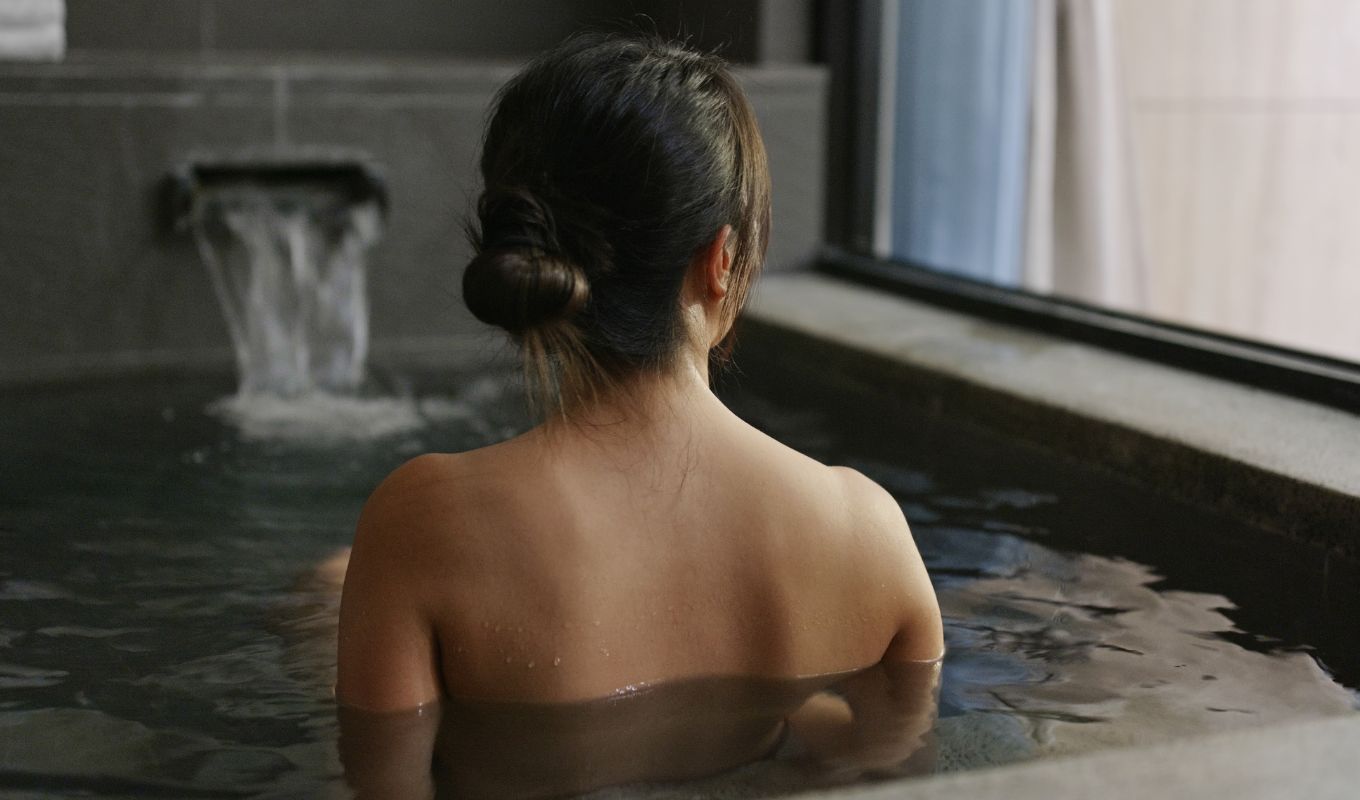
Onsens are a traditional Japanese experience that many visitors to Japan look forward to. However, it is important to be aware of the etiquette and rules surrounding these public baths to ensure a respectful and enjoyable experience for all. Here are some key points to keep in mind:
- Nudity is required: Onsens are usually gender-segregated and require complete nudity. No swimwear, underwear, or towels should touch the water.
- Shower before entering: It is customary to shower and clean yourself thoroughly before entering the bath. Soap and shampoo are usually provided.
- Don’t dip your head underwater: It is considered impolite to dip your head underwater, as it can contaminate the water for others.
- Keep the noise down: Onsens are meant to be a peaceful and relaxing experience, so it is important to keep noise levels to a minimum.
- Don’t stare: It is considered impolite to stare at others in the bath. Instead, keep your eyes down or focused on the scenery.
It is also important to note that onsen etiquette may vary slightly depending on the specific establishment or region. Some onsens may prohibit tattoos or have additional rules regarding hair ties or jewelry. Be sure to check for any posted signs or ask the staff if you are unsure of any rules.
By following these simple etiquette guidelines, you can ensure a respectful and enjoyable experience for yourself and others at the onsen.
Benefits of Onsens
Onsens are not only a relaxing and rejuvenating experience, but they also offer numerous benefits for both physical and mental health. Here are some of the benefits of onsens:
- Stress Relief: One of the most well-known benefits of onsens is that they help reduce stress levels. The warm water, quiet atmosphere, and beautiful surroundings all contribute to a sense of calm and relaxation.
- Pain Relief: Onsen water contains minerals such as sodium bicarbonate and calcium that can help alleviate muscle and joint pain. The heat of the water also helps to increase blood flow, which can help promote healing.
- Improved Skin Health: The minerals in onsen water can also help improve the overall health of your skin. For example, the sodium spring supposedly softens your skin, while the sulfur spring can help treat skin conditions such as eczema and psoriasis.
- Better Sleep: Many people find that soaking in an onsen before bed helps them fall asleep faster and sleep more soundly. This is likely due to the relaxing and stress-reducing effects of the onsen.
- Boosted Immune System: The minerals in onsen water can also help boost your immune system by increasing the amount of oxygen in your blood and improving your overall circulation.
It’s important to note that while onsens offer many benefits, they may not be suitable for everyone. If you have any medical conditions or concerns, it’s always best to consult with your doctor before trying an onsen.
Famous Onsens in Japan
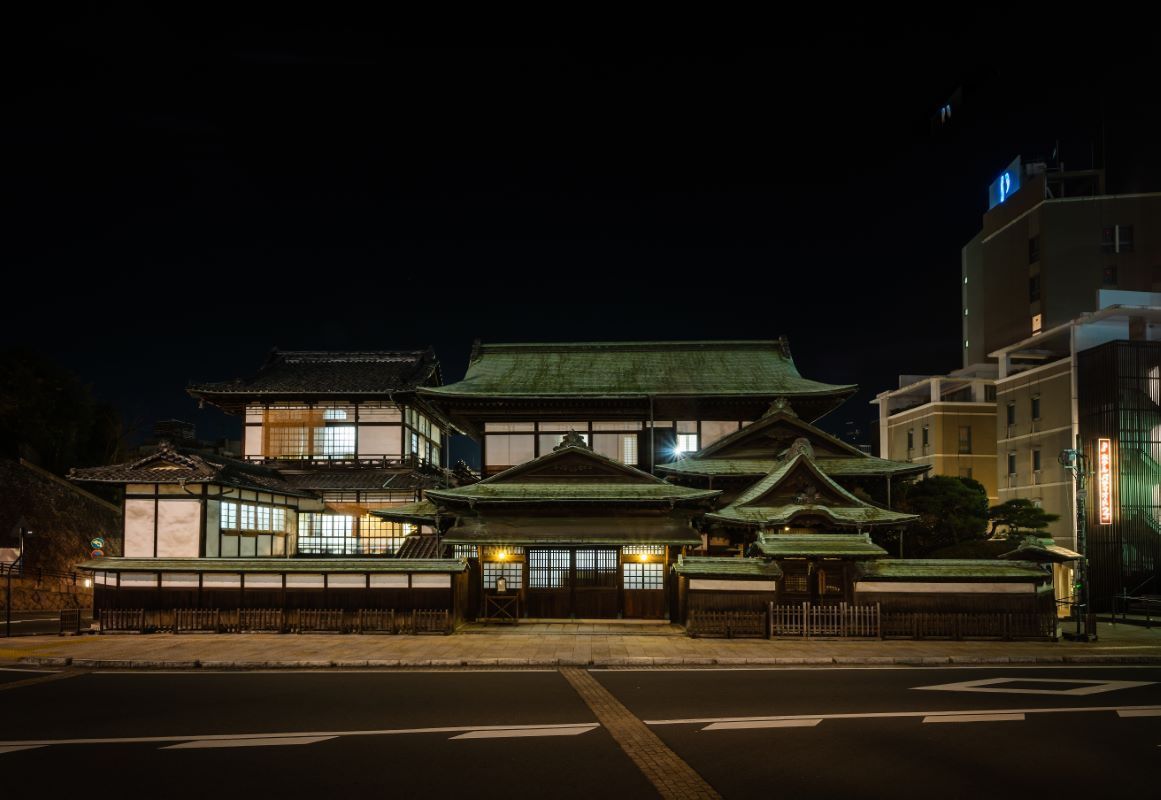
Japan is renowned for its hot springs, or onsens, which are widely believed to have therapeutic properties. Here are some of the most famous onsens in the country:
- Kusatsu Onsen: Located in Gunma Prefecture, Kusatsu Onsen is one of the most well-known hot spring resorts in Japan. Its waters are said to be effective in healing a variety of ailments, including skin diseases and digestive disorders. The town also boasts a charming atmosphere and a variety of traditional Japanese inns.
- Hakone Onsen: Situated in the Fuji-Hakone-Izu National Park, Hakone Onsen is a popular destination for Tokyoites seeking a weekend getaway. The town offers a stunning view of Mount Fuji and a variety of hot springs of varying temperatures.
- Beppu Onsen: Located on the southern island of Kyushu, Beppu Onsen is known for its unique “Hells of Beppu,” a series of hot springs with different colors and properties. The town also offers a variety of traditional Japanese inns and modern resorts.
- Kurokawa Onsen: Nestled in the mountains of Kumamoto Prefecture, Kurokawa Onsen is a picturesque hot spring town with a variety of outdoor baths surrounded by nature. The town also offers a number of traditional Japanese inns and modern hotels.
- Noboribetsu Onsen: Located in Hokkaido, Noboribetsu Onsen is known for its sulfuric hot springs, which are said to be effective in treating skin diseases and rheumatism. The town also boasts a variety of traditional Japanese inns and modern hotels.
These are just a few of the many famous onsens in Japan. Each one offers a unique experience and a chance to relax and rejuvenate in the healing waters of the hot springs.
Onsens Outside of Japan
Although Japan is known for its onsens, there are also other countries that offer similar hot spring experiences. Here are a few places outside of Japan where you can enjoy hot springs:
- Taiwan: Taiwan has a long history of hot springs and is home to over 100 hot spring resorts. Beitou Hot Springs, located in Taipei, is one of the most popular hot spring destinations in Taiwan.
- South Korea: South Korea has a variety of hot spring experiences, including traditional jjimjilbangs (bathhouses) and luxurious hot spring resorts. One of the most famous hot spring destinations in South Korea is the city of Busan.
- Iceland: Iceland is known for its geothermal activity, and as a result, has a number of hot springs. The Blue Lagoon is one of the most famous hot springs in Iceland, and is known for its milky blue waters.
- New Zealand: New Zealand is home to a number of hot springs, including the famous Polynesian Spa in Rotorua. The hot springs in New Zealand are often surrounded by stunning natural scenery.
While these countries offer their own unique hot spring experiences, Japan remains the top destination for onsens. However, if you’re looking to explore other hot spring destinations, these countries are definitely worth considering.
Onsens are a unique and important part of Japanese culture. These hot springs not only offer relaxation and rejuvenation but also serve as a social hub for locals and visitors alike. Onsens come in various types, including indoor and outdoor baths, and offer a range of health benefits.
When visiting an onsen, it’s important to follow proper etiquette, such as washing before entering the bath and not bringing any towels or clothing into the water. Onsen water is heated from geothermal springs and contains minerals that can be beneficial for the skin and body.
Overall, onsens are a must-visit experience for anyone traveling to Japan. They offer a unique opportunity to immerse oneself in Japanese culture and relax in natural hot springs. So, don’t forget to add a visit to an onsen to your travel itinerary when planning your trip to Japan.
Related Posts

Solaniwa Onsen Ticket In Osaka
- July 15, 2023

Hot Springs
- December 19, 2022
- Japan Shore Excursions, Day Trips & Activities from Cruise Ports

- Search for:
- Kochi Shore Excursions
- Kyoto Shore Excursions
- Kobe Shore Excursions
- Naha – Okinawa Shore Excursions
- Shimizu Shore Excursions
- Osaka Shore Excursions
- Yokohama Shore Excursions
- Hiroshima Shore Excursions
- Nagasaki Shore Excursions
- Kagoshima Shore Excursions
- Fukuoka Shore Excursions
- Tokyo Shore Excursions
- Hakodate Shore Excursions
- Ishigaki Shore Excursions
- Kanazawa Shore Excursions
- Kushiro Shore Excursions
- Aomori Shore Excursions
- Sakata Shore Excursions
- Maizuru Shore Excursions
- Matsuyama Shore Excursions
- Miyazaki Shore Excursions
- Aburatsu Shore Excursions
- Kitakyushu Shore Excursions
- Otaru Shore Excursions
- Sasebo Shore Excursions
- Nagoya Shore Excursions
- Beppu Shore Excursions
- Akita Shore Excursions
- Kumamoto Shore Excursions
- Ishinomaki Shore Excursions
- Iwate – Miyako Shore Excursions
- Karatsu Shore Excursions
- Miyakojima Shore Excursions
- Muroran Shore Excursions
- Niigata Shore Excursions
- Sakaiminato Shore Excursions
- Shimonoseki Shore Excursions
- Shingu Shore Excursions
- Takamatsu Shore Excursions
- Toba Shore Excursions
- Tokushima Shore Excursions
- Toyama Shore Excursions
- Tsuruga Shore Excursions
- Tailor Made Tours
- Japan Attractions
- Japan Travel Guide
Japan Travel Guide - Introduction & Information
Top onsen experiences in japan | 10 hot springs destinations to visit.
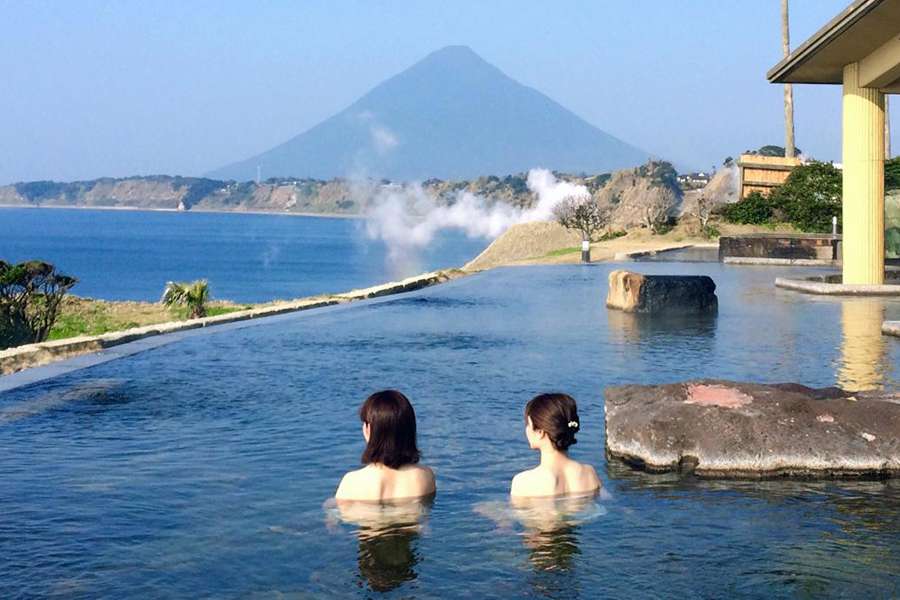
In a country that’s become a premier destination for global travelers, visitors to Japan are now searching for unique experiences that go beyond social media appeal or typical tourist attractions. Why not explore an Onsen or Japanese bathhouse nestled in a natural hot spring setting?
Japanese hot spring baths, known as “Onsen” (温泉 meaning “hot spring”), are rich in tradition and set against stunning natural landscapes. These baths offer travelers a chance for deep relaxation and renewal.
In this edition of the Japanese Taste blog, we present the Top 10 Onsen Experiences in Japan. From the northern reaches of Hokkaido to the southern regions of Kyushu, and through the main island of Honshu, we’ll guide you to the finest Japanese hot spring baths for your next visit to Japan.
What Is an Onsen? Why Experience a Japanese Hot Spring Bath?
Before diving into our Top 10 list of Japanese onsens, let’s explore what makes a Japanese hot spring bath so special and why it holds significance for both locals and visitors.
An Onsen is more than just a bathhouse; it is a retreat where natural hot spring waters, enriched with minerals from deep within the earth, offer both physical and spiritual renewal. The tradition of bathing in Japan is deeply ingrained in daily life, from home baths to communal bathhouses, and has been a cherished practice for centuries.
Onsen experiences elevate this tradition by incorporating natural hot springs. In Japan’s mountainous and geologically active landscape, hot springs are a natural gift. Bathing in an Onsen is not just about relaxation; it’s a way to connect with Japan’s geological essence and honor the long-standing appreciation for the therapeutic benefits of these waters.
Most Japanese people will enthusiastically affirm their love for onsens and share their experiences of the healing and soothing effects these hot springs provide.
Best Time to Visit Onsen in Japan
When planning your trip, consider Japan’s high and low seasons and potential weather challenges. First, outline your travel itinerary, then find the nearest onsens to your destinations.
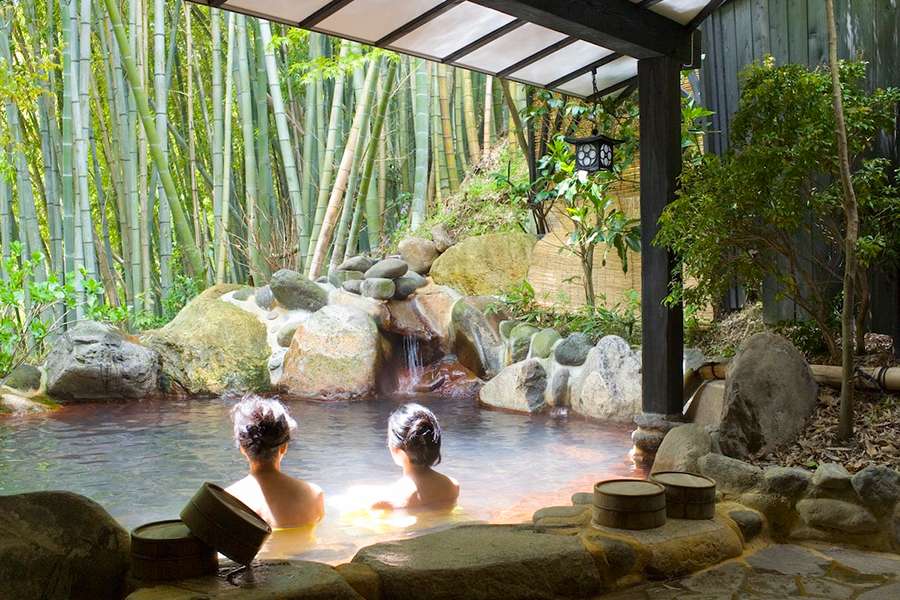
Spring and Autumn – Ideal Onsen Seasons
The mild temperatures of spring and autumn make these seasons perfect for onsen visits. Picture yourself relaxing in outdoor baths amid cherry blossoms or colorful fall leaves.
Winter Onsen – A Cozy Escape
Winter turns onsens into warm retreats amidst snow-covered scenery. The contrast between the hot water and chilly air creates a magical experience, making winter a popular time for onsen visits.
Summer Onsen – A Refreshing Escape
Japan’s summers are typically hot and humid. While it might seem unusual to visit an onsen during this season, it’s actually a great way to cool off and rejuvenate during your travels in Japan.
Japanese Onsen Etiquette
Before stepping into the serene onsen in Japan, it’s crucial to understand and follow onsen etiquette to ensure a respectful and enjoyable experience. The onsen ritual begins with a thorough washing and rinsing before entering the communal bath. Once you’re in the onsen, avoid bringing towels into the water and refrain from swimming or splashing. The tranquil atmosphere of an onsen requires a quiet and respectful demeanor to maintain a serene environment for everyone.
Tattoos, which were once a barrier to accessing onsen due to their association with organized crime, are becoming less of an issue at many establishments. If you or someone you’re traveling with has tattoos, it’s advisable to check for onsen that are tattoo-friendly or have specific times when tattoos are permitted.
Why You Should Experience an Onsen in Japan
While most visitors to Japan focus on cities like Tokyo and Kyoto, adding an onsen visit to your itinerary can offer a deeper connection to Japanese culture and history. Thanks to Japan’s excellent transportation system, you can easily integrate a visit to an onsen without significantly altering your travel plans. Experiencing an onsen not only provides relaxation and rejuvenation but also enriches your travel adventure by immersing you in a traditional aspect of Japanese life.
Physical and Spiritual Renewal at an Onsen
Onsen waters, rich in minerals, offer therapeutic benefits for both the body and mind. They are known to ease aches, enhance circulation, and cleanse the skin. Soaking in an onsen is more than a physical experience; it’s a chance to meditate, reflect, and find peace in a serene setting. Visitors often leave feeling not just physically refreshed but also spiritually uplifted, carrying a renewed energy that enhances the rest of their journey in Japan.
Top 10 Japanese Onsen to Enjoy During Your Trip to Japan
Exploring Japan’s top onsens offers a variety of exceptional hot spring bath experiences, each earning its spot among the finest. If your schedule and budget permit, consider visiting one or more of these premier onsen destinations. These standout spots in Japan are well worth an overnight stay or even a weekend visit, especially with nearby attractions and activities to enhance your trip.
1. Kusatsu Onsen – Premium Hot Springs
Located in the mountains of Gunma Prefecture, Kusatsu Onsen is renowned for its Yubatake, a central hot water field that defines the town. The sulfur-rich waters are celebrated for their healing qualities, making Kusatsu a top destination among Japan’s onsens. Japanese locals will often respond enthusiastically if you mention you’re visiting Kusatsu, reflecting its esteemed status in the onsen world.
The town’s traditional allure is showcased through the Yumomi performance, where women rhythmically stir the hot spring water to cool it down. For an authentic experience of Japanese hot spring culture, Kusatsu Onsen is a must-visit during your trip to Japan.
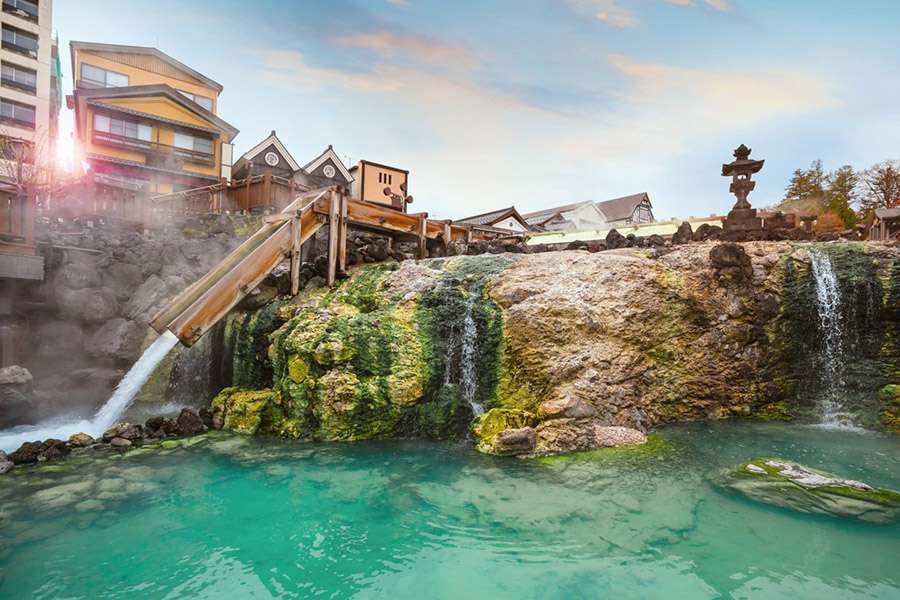
How to Get to Kusatsu Onsen
Despite its picturesque setting, Kusatsu Onsen is easily accessible. From Tokyo, take the Hokuriku Shinkansen (bullet train) to Karuizawa, then transfer to a bus bound for Kusatsu. If you’re touring the Hokuriku region, this onsen is a must-see!
2. Noboribetsu Onsen – Hokkaido’s “Hell Valley”
Nestled in the volcanic terrain of Hokkaido, Noboribetsu Onsen stands out with its Hell Valley (Jigokudani) and mineral-rich waters, offering a distinct onsen experience. The geothermal features around the area enhance the appeal of this remarkable destination. The hot springs from Hell Valley reveal the earth’s raw energy, and the annual Hell Festival adds a mystical touch to the experience, creating a unique atmosphere.
A visit to Noboribetsu will leave a lasting impression, not only for the onsen experience but also for the stunning landscapes. While the scenery is indeed social media-worthy, it’s the memorable experience that truly stands out for those who visit.
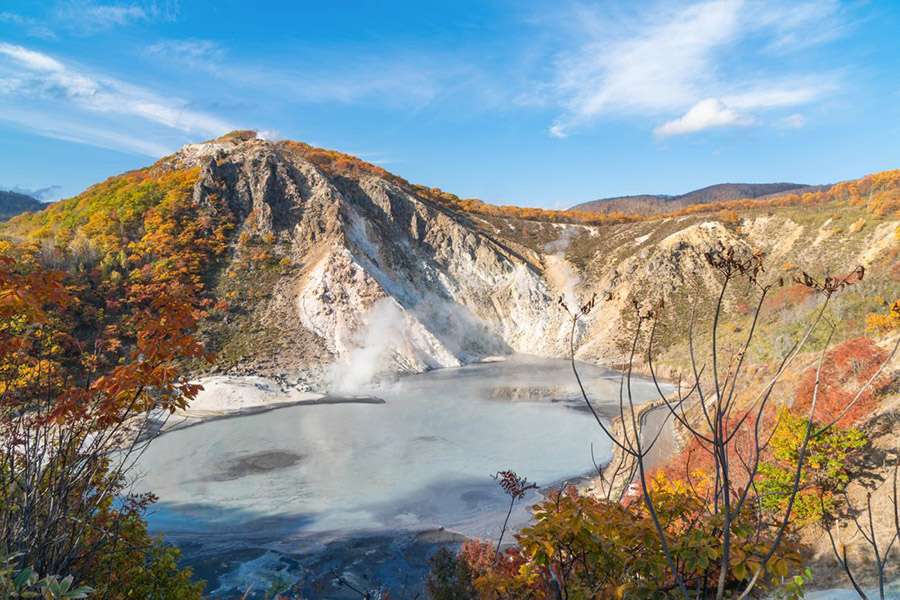
How to Get to Noboribetsu Onsen
Noboribetsu is easily accessible for a day trip by bus or rental car from Sapporo or nearby ski resorts. An overnight stay is also recommended, with plenty of dining and accommodation options available. As part of a trip to Hokkaido, Noboribetsu is a highlight worth including in your Japanese itinerary.
3. Ginzan Onsen – A Taisho Era Retreat in Yamagata Prefecture
Situated in a picturesque valley in Yamagata, part of northern Japan’s Tohoku region, Ginzan Onsen offers a step back to the Taisho era. The historic ryokans along the charming river create a nostalgic atmosphere, making Ginzan a hidden gem among Japanese onsens. The area’s timeless allure comes from its preservation of Taisho-era charm, with visitors enjoying serene strolls by the river, accompanied by the sound of flowing water and the glow of lanterns, evoking a bygone era. Ginzan’s ability to retain its historical character amidst modernity adds to its enchanting appeal.
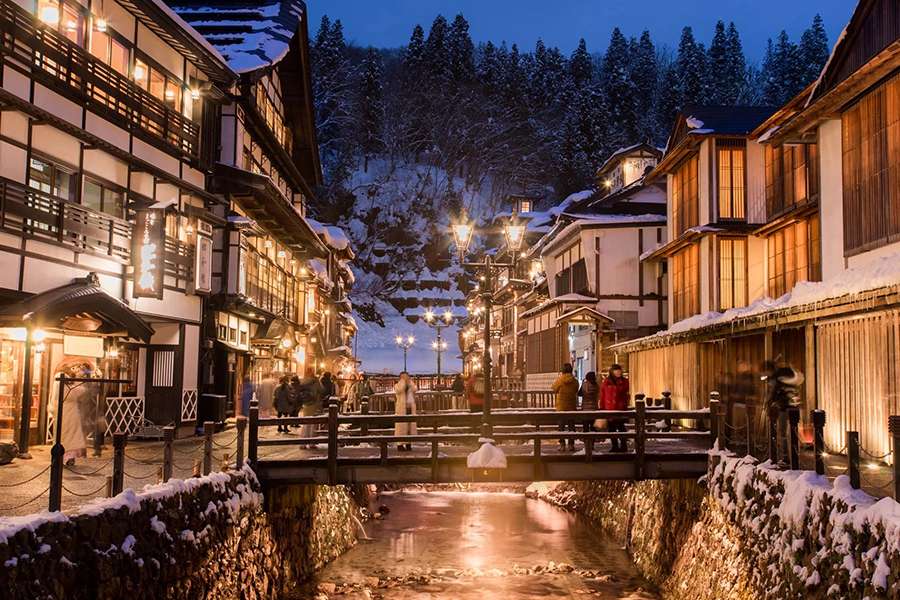
How to Get to Ginzan Onsen
Ginzan Onsen is best enjoyed as an overnight stay, especially for those exploring the Tohoku region of northern Honshu. From Tokyo, take the Shinkansen to Sendai, then drive to Ginzan Onsen, about two hours away. Be mindful that the Tohoku region is known for its winter snowfall, which enhances its natural beauty but requires checking weather conditions depending on the season.
4. Kinosaki Onsen – Soothing Hot Springs by the Japan Sea
If you’re visiting the Kansai area, such as Kyoto or Osaka, consider adding Kinosaki Onsen to your itinerary. With its seven public baths and charming canals, Kinosaki Onsen offers a serene escape. The town’s unique atmosphere and variety of bathing options make it a standout destination among Japanese onsens. Kinosaki Onsen provides relaxation throughout the year. In winter, enjoy the snowy landscapes, while summer visitors can refresh themselves in some of Japan’s finest hot spring baths.
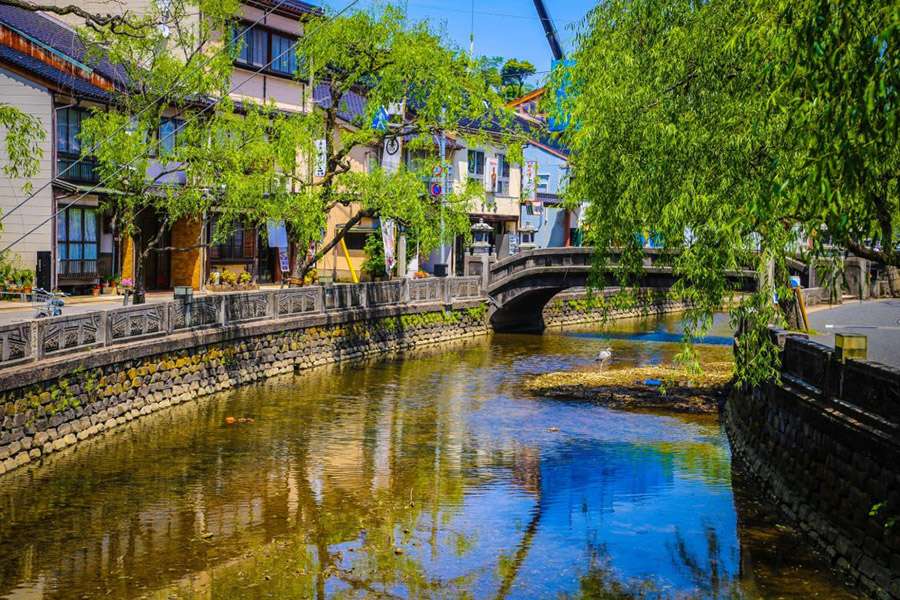
How to Get to Kinosaki Onsen
Although it may be slightly off the beaten path, Kinosaki Onsen is well worth an overnight or weekend stay. It’s best to book a ryokan and travel by train (great for JR Pass holders) from Kyoto, Osaka, or Kobe.
5. Gero Onsen – Gifu’s Charming Hot Springs
Gero Onsen stands out with its three distinct public baths and delightful ryokan inns. Set by the Hida River in Gifu Prefecture, its tranquil riverside location and therapeutic waters create a perfect retreat for onsen lovers. The scenic beauty of Gero Onsen, combined with its three unique hot spring baths, offers a variety of experiences. Traditional Gassho-zukuri style ryokans further enrich the visit, highlighting Japan’s architectural and cultural heritage.
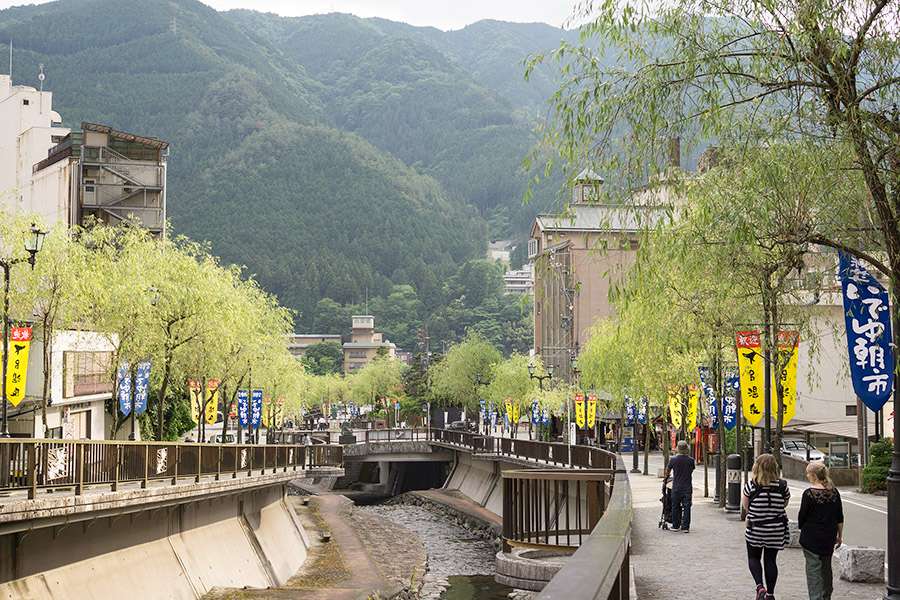
How to Get to Gero Onsen
Gero Onsen is conveniently reached by train from Nagoya, making it accessible with a JR Pass. It’s a manageable trip from both the Kanto (Tokyo) and Kansai (Osaka/Kyoto) regions.
6. Hakone Onsen – A Relaxing Retreat Near Tokyo
Just a short trip from Tokyo, Hakone Onsen offers a refreshing escape from the city’s hustle with its natural hot spring baths. Set amidst lush forests and with views of Lake Ashi, Hakone provides a peaceful getaway with stunning scenery. On clear days, you might even catch a glimpse of Mount Fuji, adding a touch of grandeur to your onsen experience. However, it’s best to keep expectations in check and be pleasantly surprised if the mountain appears.
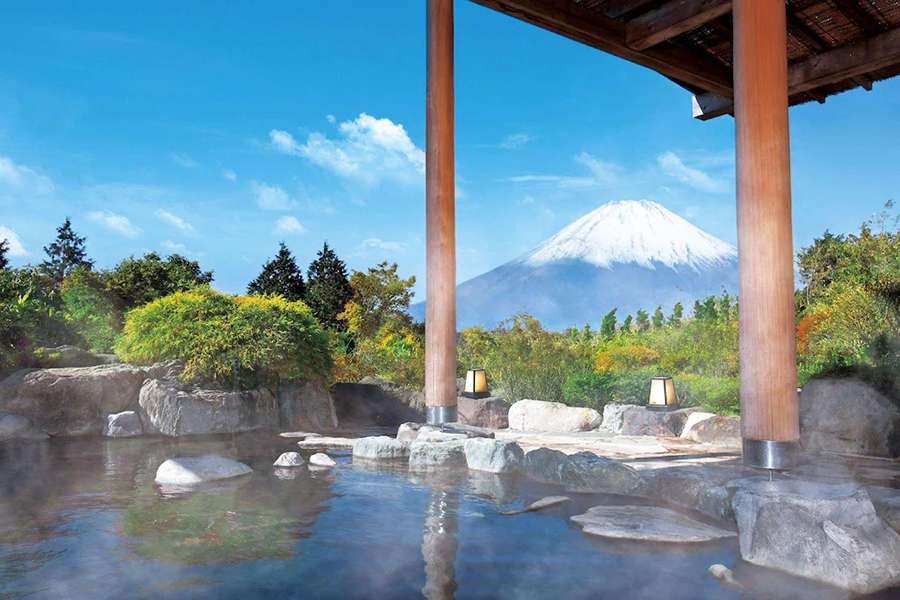
How to Get to Hakone
You can reach Hakone quickly by taking the Shinkansen from Tokyo to Odawara in under an hour, and then a 15-minute ride to Hakone Yumoto station. It’s ideal for a day trip from Tokyo, but even better as an overnight stay in one of the many ryokan inns in the Hakone area.
7. Dogo Onsen – Shikoku’s Historic Hot Springs
Dogo Onsen, with its historic three-story wooden bathhouse, offers a glimpse into Japan’s rich onsen tradition. The setting is perfect for those looking to experience authentic Japanese culture. As dusk falls over Matsuyama, Dogo Onsen takes on an enchanting atmosphere. The Dogo Onsen Honkan, illuminated against the night sky, stands as a symbol of timeless elegance. The blend of architectural beauty and historical significance makes Dogo Onsen a quintessential onsen experience.
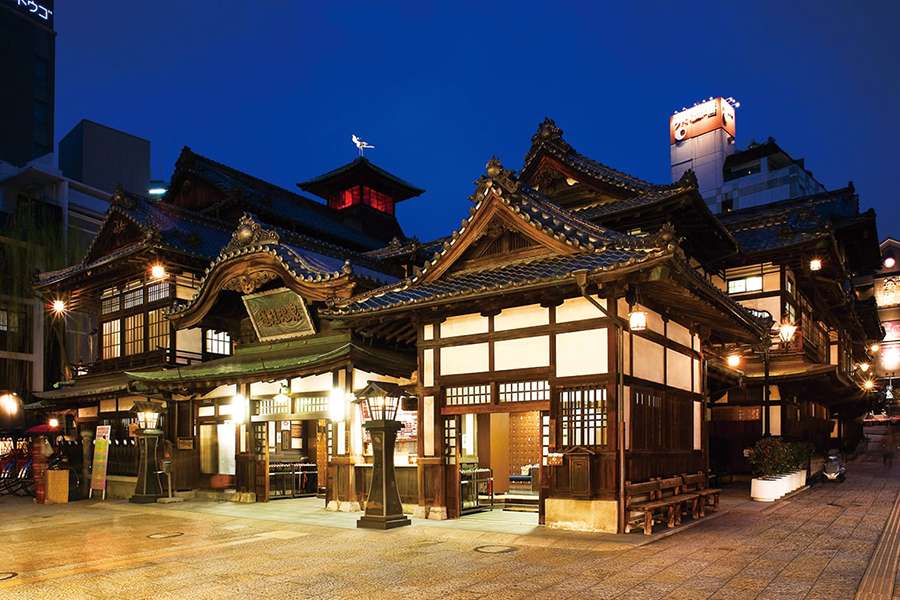
How to Get to Dogo Onsen
Located on Shikoku Island, Dogo Onsen is somewhat off the beaten path but offers unique experiences not found in Tokyo or Kyoto. The nearest city, Matsuyama, is about 30 minutes away and provides train and flight connections from Tokyo, Osaka, and other destinations on your Japan travel itinerary.
8. Beppu Hatto Onsen – Explore Kyushu’s Hot Springs
Located on Kyushu’s southern island in Oita Prefecture, Beppu is renowned for its wide variety of onsen experiences, including mud baths and sand baths. The Hatto Onsen, a collection of eight distinct hot spring baths in the Beppu area, adds to the city’s allure. Beppu’s diverse onsen offerings make it a fascinating destination for enthusiasts. Additionally, Oita Prefecture is known for its exceptional food, ensuring a rewarding visit.
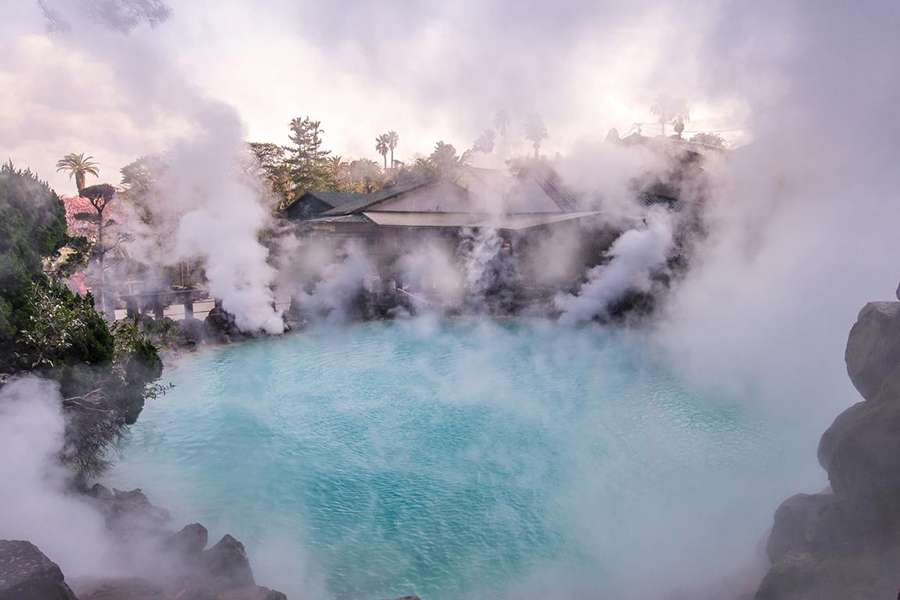
How to Get to Beppu
Beppu is easily accessible as a day trip from Fukuoka (great news for JR Pass holders) or can be explored as an overnight destination. Consider visiting nearby onsen towns like Yufuin or the Mount Aso region for a more comprehensive hot spring experience.
9. Kurokawa Onsen – A Hidden Gem in Kyushu
Discover Kurokawa Onsen, a serene retreat nestled in the mountains of Kyushu. Enjoy a variety of over 20 unique hot springs, with each ryokan providing a perfect escape into relaxation. Wander through the picturesque streets, lined with traditional yukata-wearing visitors, ryokan inns, bathhouses, and charming shops. The town’s compact size enhances its peaceful atmosphere, inviting you to relax and rejuvenate. Here, you won’t find high-rise hotels or neon lights—just natural beauty and traditional wooden buildings along a gentle river. Kurokawa Onsen maintains its authentic character, offering a quintessential Japanese hot spring experience.
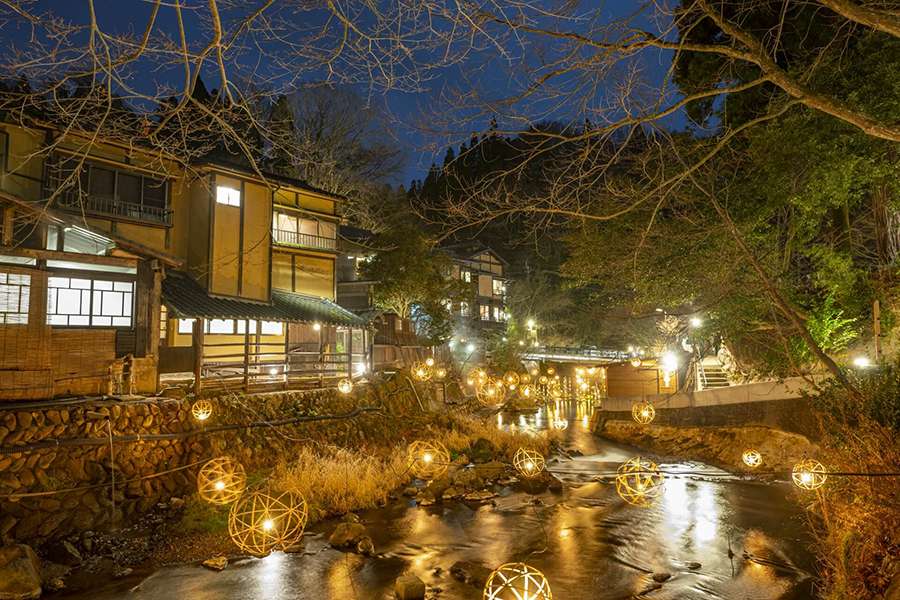
How to Get to Kurokawa Onsen
Travel by Shinkansen to Kumamoto, then continue by rental car or bus to Kurokawa Onsen. Consider a regional pass that also covers other onsen destinations.
10. Ibusuki Onsen – Southern Kyushu’s Unique Hot Springs
Located at the southern tip of Kyushu in Kagoshima Prefecture, Ibusuki Onsen offers a distinctive hot spring experience. Here, visitors are treated to “sunamushi,” a unique therapy where they are buried in naturally heated volcanic sand. This unusual practice, combined with the seaside location, provides a sensory experience that transcends traditional onsen bathing. The coastal setting enhances the tranquility of this unconventional yet therapeutic onsen.
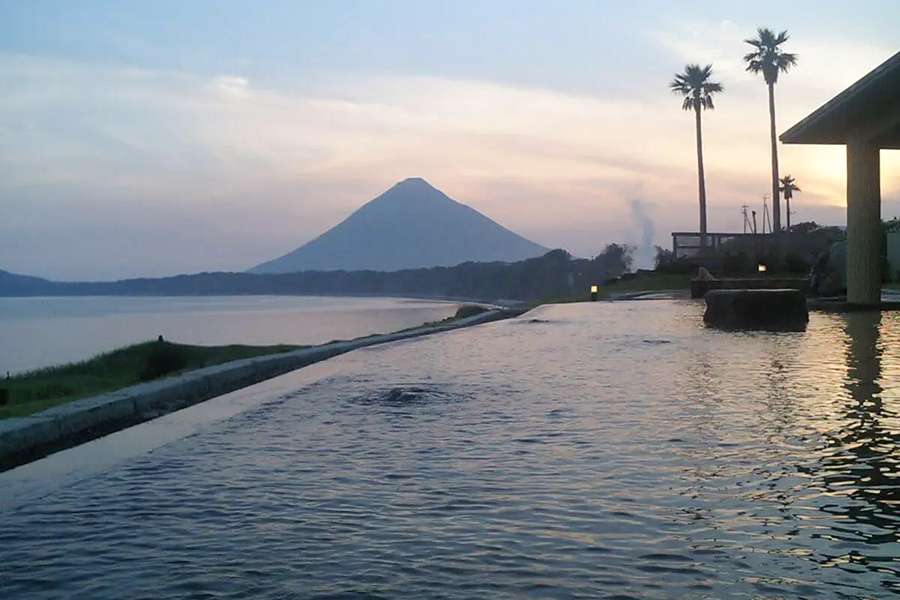
How to Get to Ibusuki Onsen
To reach Ibusuki, take a train from the end of the Kyushu Shinkansen line. It’s advisable to stay overnight to fully enjoy the area. Alternatively, you can fly domestically into Kagoshima from Tokyo or Osaka and start your Kyushu exploration from there.
From the timeless allure of Dogo Onsen to the stunning scenery of Kusatsu, and from the scenic beauty of Hakone to the dramatic landscapes of Noboribetsu, Japanese Onsen offer a unique blend of historical charm, natural splendor, and cultural immersion. Experience the mineral-rich waters and tranquil settings of Japan’s hot springs with Japan Shore Excursions , and let these serene landscapes transport you to a place of profound peace and cultural richness.
Username or email address *
Password *
Remember me Log in
Lost your password?

- Itineraries
- Tours and Activities
- Travel Guides
- Best of Japan
JRailPass.com » Japan Travel Blog » The 10 best onsen and onsen towns in Japan
The 10 best onsen and onsen towns in Japan
October 1, 2018

No trip to Japan is complete without a relaxing dip in an onsen. What is an onsen? Onsen are natural hot springs, fueled by volcanic activity, as well as the resort atmosphere that has emerged around many such springs.
Japan offers around 2,300 onsen to choose from, many of them included in ryokan (traditional inns). We’ve compiled a list of ten of the best onsen in Japan. No matter what region you’re traveling to, you’ll be able to unwind. Reaching the onsen is simple and affordable when you use Japan Railways and the Japan Rail Pass .
Kusatsu Onsen
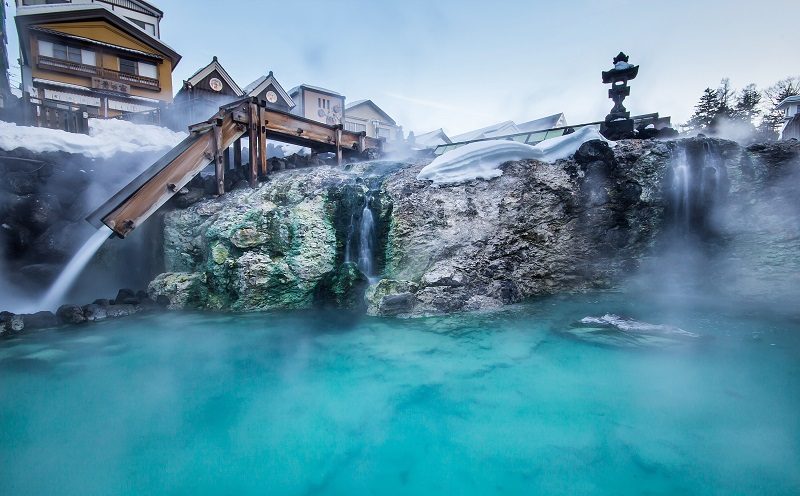
Kusatsu is considered the foremost onsen in Japan. It is supplied with large volumes of hot water, “said to cure every illness but lovesickness”. There, you can visit multiple hot springs free of admission fees. A number of resorts and inns are available, as well as shops and cafes. The area also offers skiing in the winter and hiking during warmer months.
Address : Kusatsumachi, Agatsuma District, Gunma Prefecture 377-1711.
How to get to Kusatsu Onsen : From Tokyo, use your JR Pass to take the Joetsu Shinkansen northbound to Takasaki Station. Then, change to the JR Agatsuma line to Naganohara-Kusatsuguchi Station. From the station, you may take a JR bus to the onsen.
Alternatively, the Limited Express Kusatsu connects Ueno Station (Tokyo) and Naganohara-Kusatsuguchi directly and is also covered by the Japan Rail Pass. The bus runs only twice in the weekdays and once on weekends, so please check the timetables via Hyperdia or in a JR Office.
Hakone Onsen
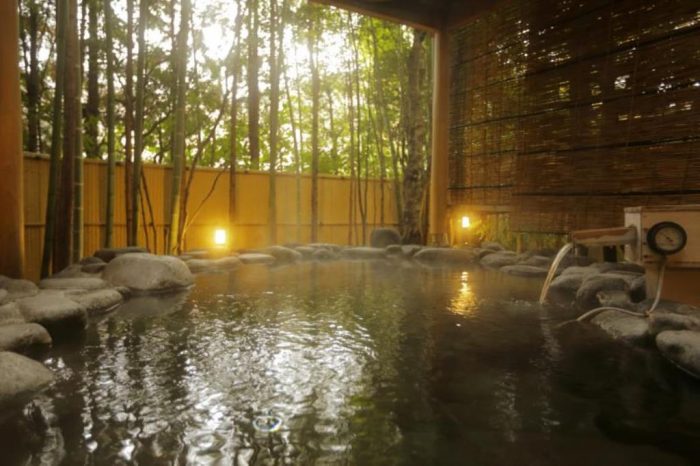
Located less than two hours from Tokyo, Hakone is a must-visit destination for anyone traveling through the neon city. During your stay, you can visit numerous souvenir shops. You can also stay in one of several ryokan or in a nearby resort hotel, as many of them include their own private onsen.
Some of the best-reviewed luxury ryokan include Gora Hanaougi, Gora Kadan, Hakone Suishoen, Hakone Kowakudani Onsen (in the picture) and Yamanochaya.
How to get to Hakone : From Tokyo, take the JR Odakyu Line to Odawara Station. The city center is a 20-minute bus ride from the station.
Beppu Onsen

Imagine a city skyline caped in steam, white wisps rising between buildings. That is Beppu city in Oita prefecture, home to eight distinct onsen, each with public baths and ryokan. In addition to traditional onsen, bathers can enjoy sand baths, in which they are covered in naturally heated sands; steam baths; and mud baths.
Tours of the “hells”, or hot springs with unique colors and features are also available. Some tours even serve eggs boiled in one of the springs!
How to get to Beppu : From Tokyo, take the Tokaido/Sanyo Shinkansen to Kokura Station. There, transfer to the Sonic Limited Express bound for Beppu Station.
Yufuin Onsen

Surrounded by the mountains of Kyushu (southern Japan), this onsen’s most prominent vista is that of the twin peaks of Mount Yufu. During your stay, you may delight in Yufuin’s many boutique stores, art museums, and cafes. Ryokan are scattered throughout the town, many of which open their onsen to walk-in guests during the day.
Address : Kawakami, Yufuincho, Yufu-shi, Oita.
How to get to Yufuin Onsen : From Beppu Station, take the JR Yufu line travel to Oita Station. There, you will transfer trains before continuing to Yufuin Station. The whole trip is covered by your JR Pass.
Kurokawa Onsen

Lush and verdant, Kurokawa is another town in Kyushu that has purposefully maintained a traditional atmosphere. Ryokan, bathhouses, and shops line the main streets. The springs in this area are said to be beneficial for nerve pain.
Address : Minami Ogunimachi, Aso-gun, Kumamoto.
How to get to Kurokawa : The nearest train station is Aso Station, which is located about one hour away from the onsen by bus. Japan Rail Pass holders can board the Fukuoka-Kurokawa highway bus from Hita Station, which is connected to Hakata Station in Fukuoka by a limited express train.
Book your Japan Rail Pass now
Noboribetsu Onsen

Noboribetsu is regarded as the best onsen resort on the northern island of Hokkaido. The waters in its hot spring baths contain sulfur and hydrogen sulfide, which are said to soften and lighten skin, as well as iron, which lessens fatigue. The minerals in the water paint the surrounding landscape, giving it the nickname “Hell Valley”.
How to get to Noboribetsu : From Tokyo, take the JR Tohoku/ Hokkaido Shinkansen to Shin-Hakodate-Hokuto. There, transfer to the Hokuto Limited Express train to Noboribetsu Station.
Kinosaki Onsen

A river lined with willow trees, old fashioned ryokan, and nostalgic arcades defines Kinosaki , voted “best hot spring town” by Lonely Planet. A sanctuary for the endangered oriental stork is also located nearby.
Address : 357-1 Kinosakicho Yushima, Toyooka 669-6101, Hyogo Prefecture.
How to get to Kinosaki Onsen : From Kyoto Station, take the Kinosaki Limited Express train to Kinosaki Onsen Station. Travel time is roughly 2’5 hours. From Osaka Station, you can take the Konotori Limited Express train to Kinosaki Onsen Station. Travel time is 2 hours and 40 minutes.
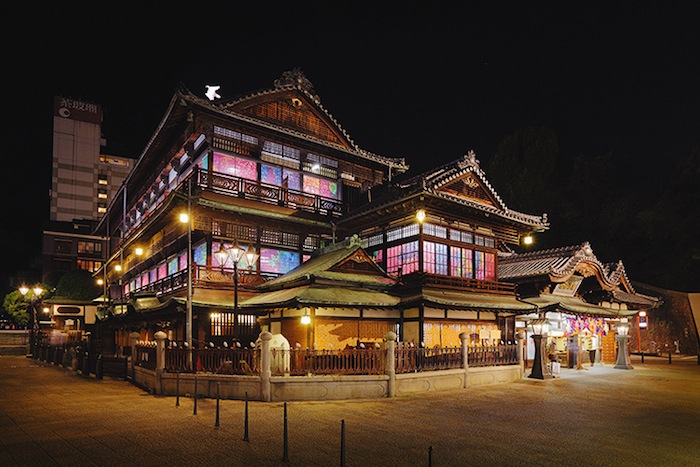
Dogo, in Shikoku island , is the oldest onsen in Japan, boasting 3,000 years of history. It features a large, castle-like bathhouse and numerous ryokan. This bathhouse, the Honkan, inspired elements of the Studio Ghibli film Spirited Away.
Address : 5-6 Dogoyunomachi, Matsuyama 790-0842, Ehime Prefecture.
How to get to Dogo Onsen : From Tokyo, take the JR Tokaido/Sanyo Shinkansen to Okayama. There, transfer to the JR Shiokaze limited express to Matsuyama. The Dogo Onsen Honkan is a four-minute walk from the station.
Fuji Kawaguchiko Onsen

Lake Kawaguchiko is located at the base of the iconic Mount Fuji. A number of bath houses and ryokan offer indoor and outdoor bathing, but the view of Mount Fuji from the baths may be obscured by structures or clouds. The area is most scenic during the spring cherry blossom season and autumn koyo , or leaf viewing, season.
Address : Fuji Five Lakes, Yamanashi, Chubu.
How to get to Fuji Kawaguchiko : From Shinjuku Station (Tokyo) the JR Chuo Line to Otsuki Station. From Otsuki, take the Fujikyu Railway to Kawaguchiko Station. The area can also be reached from Tokyo by bus.
Ibusuki Onsen
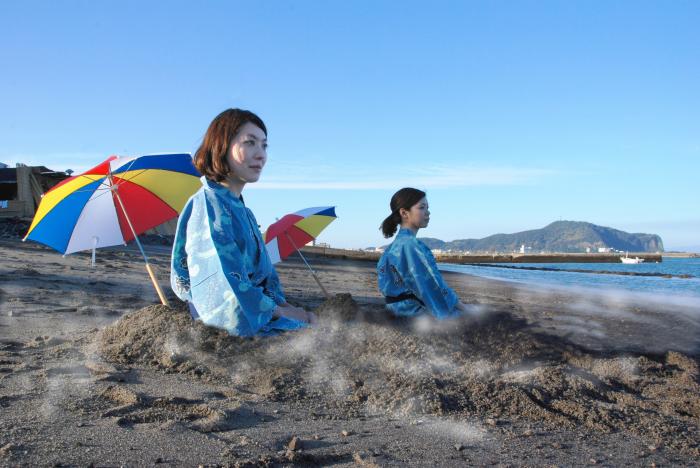
Located in the southern extreme of Kyushu, Ibusuki is famous for its sand baths, called Sunamushi . The most popular location for being buried in naturally steam-heated sand is the outdoor Saraku Sand Bath Hall, but the experience is also available at a number of ryokan.
Address : Ibusuki-shi, Kagoshima Prefecture.
How to get to Ibusuki : Ibusuki Station is connected from Kagoshima-Chuo Station by a limited express train. Travel time is 50 minutes. From Ibusuki Station you can take a direct bus to the onsen.
So, which onsen will you choose to visit? The possibilities are endless with your JR Pass in hand!
Cover picture: Takaragawa Onsen (Gunma prefecture)
Related posts
Related tours & activities.
- Media & Industry
- Meetings & Events
- Select Language 简体中文 繁體中文(香港) 繁體中文(臺灣) India (English) Bahasa Indonesia 한국어 ภาษาไทย Tiếng Việt Singapore (English) Philippines (English) Malaysia (English) Australia/New Zealand (English) Français Deutsch Italiano Español United Kingdom (English) Nordic countries(English) Canada (English) Canada (Français) United States (English) Mexico (español) Português العربية Japan(日本語) Global (English)
- India (English)
- Bahasa Indonesia
- Singapore (English)
- Philippines (English)
- Malaysia (English)
- Australia/New Zealand (English)
- United Kingdom (English)
- Nordic countries(English)
- Canada (English)
- Canada (Français)
- United States (English)
- Mexico (español)
- Global (English)
- Fujiyoshida
- Shimonoseki
- Ishigaki Island
- Miyako Island
- Kerama Island
- Tokyo Island
- Koka & Shigaraki
- Hida Takayama
- Ginza, Nihonbashi
- Beppu & Yufuin (Onsen)
- Ginzan Onsen
- Nagasaki Islands

- Kumano Kodo
- Shikoku Karst
- Amami Oshima
- Hachimantai
- Omihachiman
- Aizuwakamatsu

- Diving in Japan
- Skiing in Japan
- Seasonal Flowers in Japan
- Sustainable Outdoors
- Off the Beaten Track in Japan
- Scenic Spots
- World Heritage
- Home Stays & Farm Stays

- Japanese Gardens
- Japanese Crafts
- Temple Stays
- Heritage Stays
- Festivals and Events
- Theater in Japan
- Japanese Tea Ceremony
- Cultural Experiences in Japan
- Culture in Japan

- Local Cuisine Eastern Japan
- Local Cuisine Western Japan
- Local Street Food
- Japan's Local Ekiben
- Japanese Whisky
- Vegetarian and Vegan Guide
- Sushi in Japan Guide
- Japanese Sake Breweries

- Art Museums
- Architecture
- Performing Arts
- Art Festivals
- Japanese Anime and Comics
- Japanese Ceramics
- Local Crafts

- Scenic Night Views
- Natural Wonders
- Theme Parks
- Samurai & Ninja
- Iconic Architecture

- Wellness Travel in Japan
- Japanese Ryokan Guide
- A Guide to Stargazing in Japan
- Relaxation in Japan
- Forest Bathing (Shinrin-yoku)

- Experiences in Japan
- Enjoy my Japan
- National Parks
- Japan's Local Treasures
- Japan Heritage
- Snow Like No Other
- Wonder Around Japan

- Visa Information
- Getting to Japan
- Airport Access
- COVID-19: Practical Information for Traveling to Japan
- Anime Tourism
- Countryside Stays
- Accessible Tourism
- Hokkaido Great Outdoors
- Scenic World Heritage in Tohoku
- Shikoku’s Nature and Traditions
- Southern Kyushu by Rail

- Traveling by Rail
- How to Travel by Train and Bus
- JR Rail Passes
- Scenic Railways
- Renting a Car
- Sustainable Travel in Japan
- Travel Brochures
- Useful Apps
- Online Reservation Sites
- Eco-friendly Accommodation
- Luxury Accommodations
- Traveling With a Disability
- Hands-free Travel
- How to Book a Certified Tour Guide
- Volunteer Guides
- Tourist Information Center

- Japanese Manners
- Spring in Japan
- Summer in Japan
- Autumn in Japan
- Winter in Japan
- Cherry Blossom Forecast
- Autumn Leaves Forecast

- Japan Visitor Hotline
- Travel Insurance in Japan
- Japan Safe Travel Information
- Accessibility in Japan
- Vegetarian Guide
- Muslim Travelers
- Safety Tips

- JAPAN Monthly Web Magazine
- Arts & Cultures
- Nature & Outdoor
- Festivals & Events
- Insider Blog
- Things to do
- Local Guides
- Food & drink
- Traditional
- Hokuriku Shinetsu

My Favorites
${v.desc | trunc(25)}
Planning a Trip to Japan?
Share your travel photos with us by hashtagging your images with #visitjapanjp
- Yamagata City & Around
Ginzan Onsen 銀山温泉
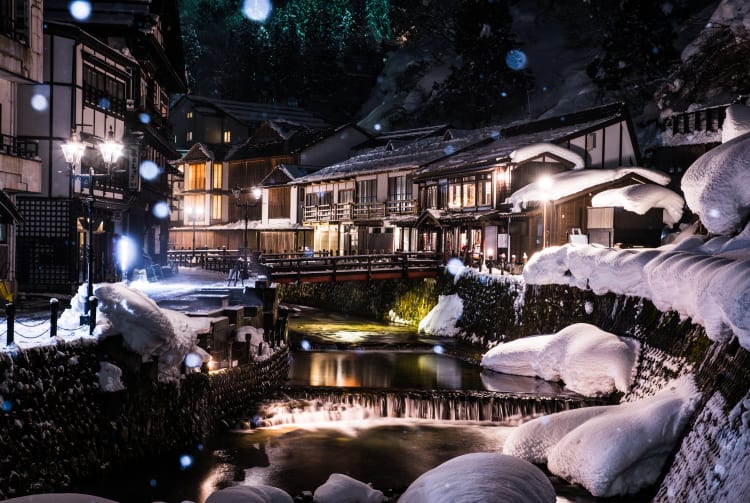
Ginzan shinhata, Obanazawa-shi, Yamagata-ken
- View on Google Maps
- Get Transit Info
Unwind, relax and step back in time
Founded on the site of a former silver mine in rural Yamagata, Ginzan Onsen Hot Spring caters to discerning guests with a taste for old-world atmosphere.
Traditional inns line the river to create picturesque scenes more evocative of a Taisho period (1912-26) novel than a modern resort. It's a long way from big city life and well worth the trip.
- Stroll along Ginzan River and the town's pedestrianized streets in your yukata
- Visit Shirogane Park and cool yourself by its waterfalls
- Stay overnight and dine at one of Ginzan Onsen's many hot spring inns
- Take an outdoor rotenburo bath or enjoy a private kashikiri soak
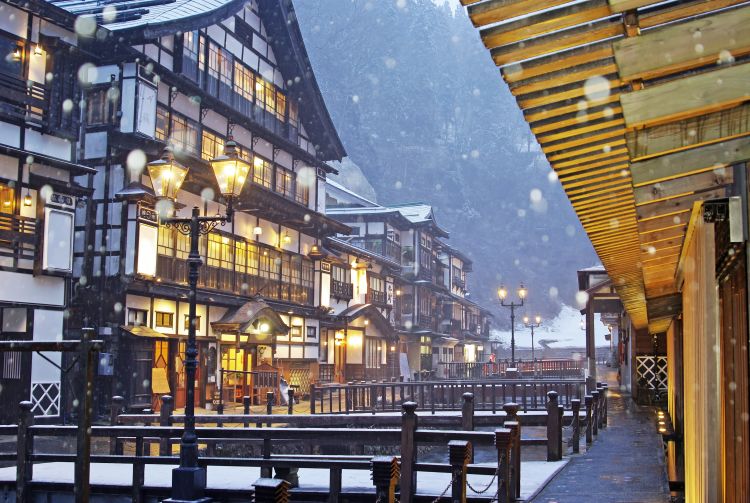
How to Get There
Ginzan Onsen can be accessed by a combination of JR trains and buses.
Visitors traveling by car are required to park at a designated parking area outside the town center. Many inns offer a shuttle service into town from the lot.
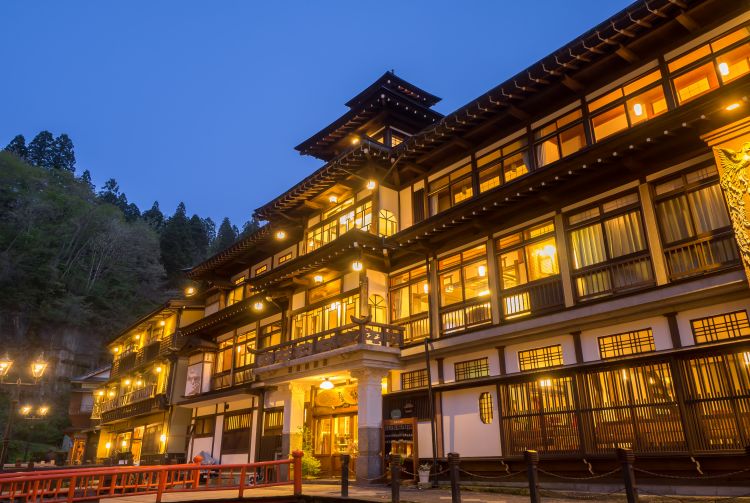
Get to know the onsen-kyo
Popular among Japanese travelers, the term onsen-kyo is associated with small, quaint towns and cozy inns that offer accommodation, food and hot spring bathing. As weekend retreats, they are popular with all age groups, from young families to retirees. This cherished aspect of travel in Japan often goes unnoticed by foreign visitors, so live like a local and dive into onsen-kyo culture.
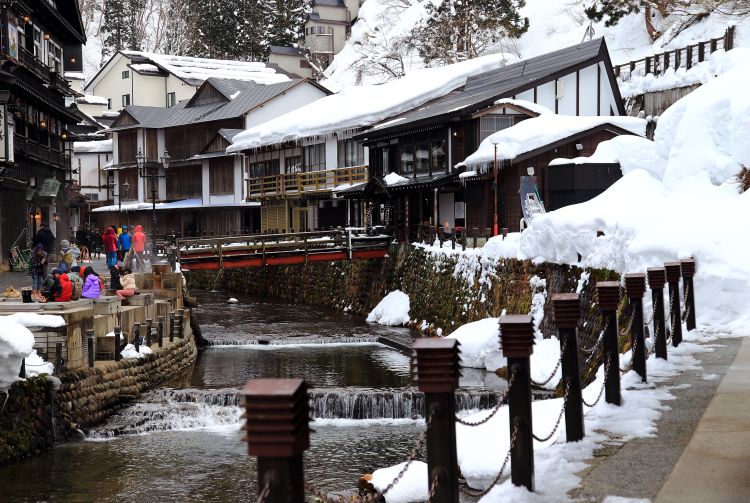
The area is a car-free town center with no modern buildings in sight.
Having checked into one of the town's many inns, visitors walk the streets without the usual concern of cars zipping past to beat the traffic light.
In the proud tradition of Japanese inns, Ginzan Onsen's ryokan offer up sumptuous local dishes to meet the standards of their mostly Japanese clientele.
Such stuff as dreams are made of
Beautiful buildings surrounded by an unspoiled rural setting ensure that Ginzan Onsen is pleasant all year round. Long summer days are perfect for lazy strolls down idyllic streets in a yukata. In winter, the town really works its magic. The sight of the buildings blanketed in snow and illuminated by the soft glow of gaslights leaves a lasting impression.
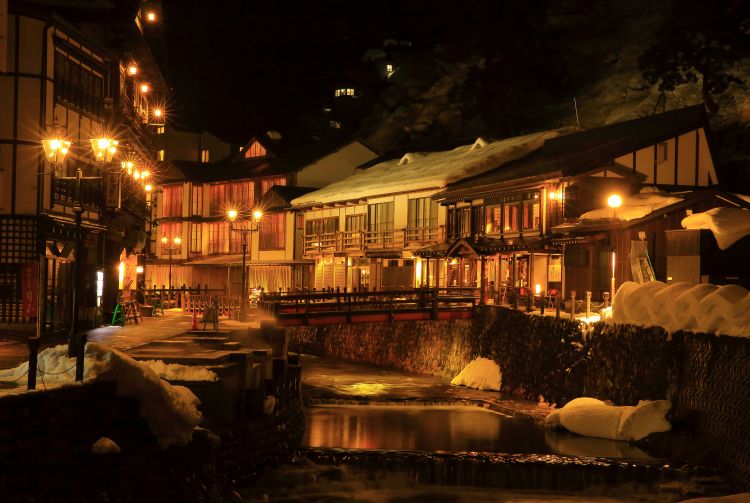
The finer points of hot spring bathing
Rotenburo are outdoor baths-usually hidden from outside view-which allow you to take in the surrounding scenery from the comfort of a hot spring. Another attractive option is arranging a kashikiri session in a private bath, whereby you and traveling companions can have a tub all to yourselves for a short time.
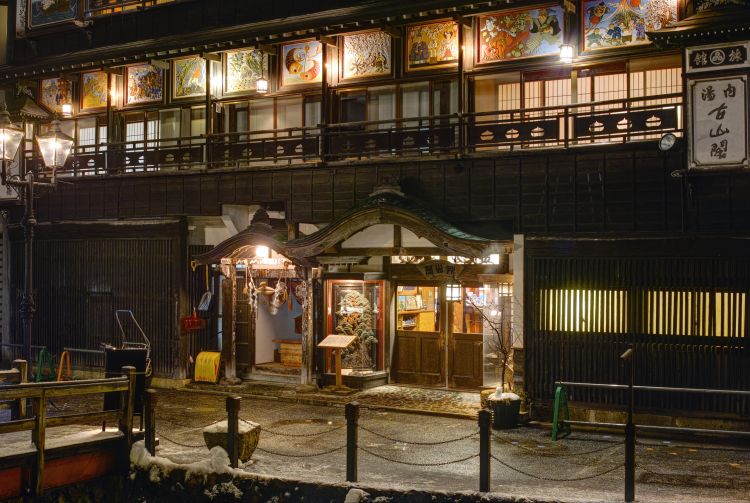
Silver everything
Unsurprisingly for a town founded on a silver mine, Ginzan Onsen takes both its name (literally, Silver Mountain) and iconography from the element. The popular Shirogane Park boasts an impressive 22 meter tall waterfall, and you'll also find an illuminated cave which is well-lit and ideal for taking pictures.
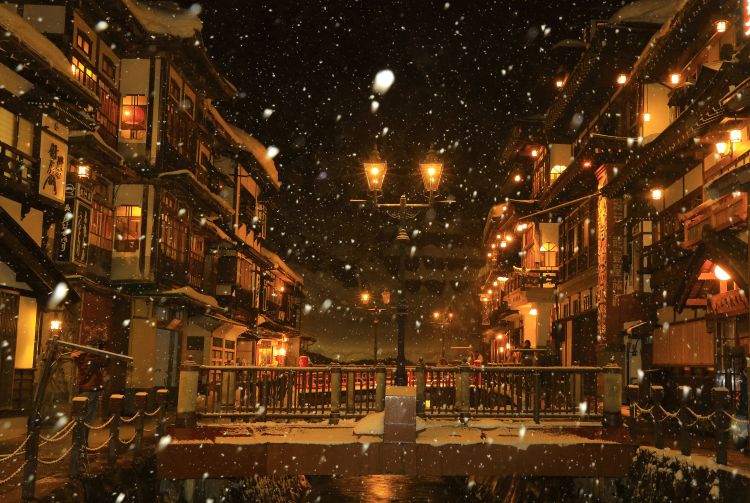
Old meets new meets old
Ginzan Onsen's one notable concession to modernity is the Fujiya ryokan, a striking building designed by famed architect Kuma Kengo. With a blend of modern and traditional elements, including the incorporation of bare timber and white plaster, it stands out from its surroundings while also keeping one foot firmly in the past.
* The information on this page may be subject to change due to COVID-19.
- Hot Springs (Onsen)
Recommended for You
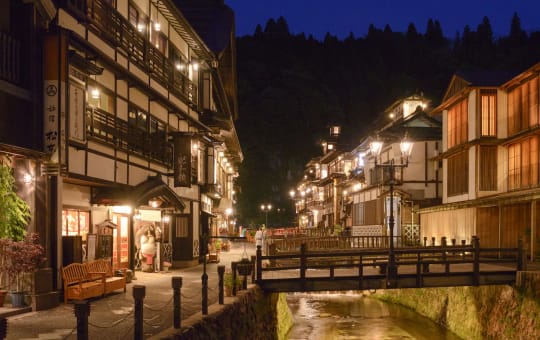
Please Choose Your Language
Browse the JNTO site in one of multiple languages

The Ultimate Guide to Onsen Hot Spring Etiquette and Where to Enjoy a Japanese Bath
- Written by: Lucio Maurizi
The serene beauty of Japan is a perfect setting for a rejuvenating hot spring experience. Onsen , as the hot springs are called, are an integral part of Japanese culture and have been enjoyed for centuries for their therapeutic and relaxing properties. With over 2,900 onsen hot springs resorts scattered throughout the country according to the Nippon Onsen Research Institute , there's no shortage of places to unwind and soak in the soothing mineral-rich waters. But for first-time visitors, navigating the world of onsen can be a bit intimidating. How do you bathe in an onsen ? What are some of the most picturesque onsen in Japan? And what are the dos and don'ts of onsen etiquette? In this article, we'll explore everything you need to know about enjoying an unforgettable onsen experience in Japan.
What is an onsen? What is the difference between 'onsen' and 'sento'?
How to spot an onsen, how do you bathe in an onsen, before entering the onsen bath itself, onsen how to and etiquette – after the bath, onsen etiquette – faq, what areas of japan are most famous for onsen, recommended onsen tours.
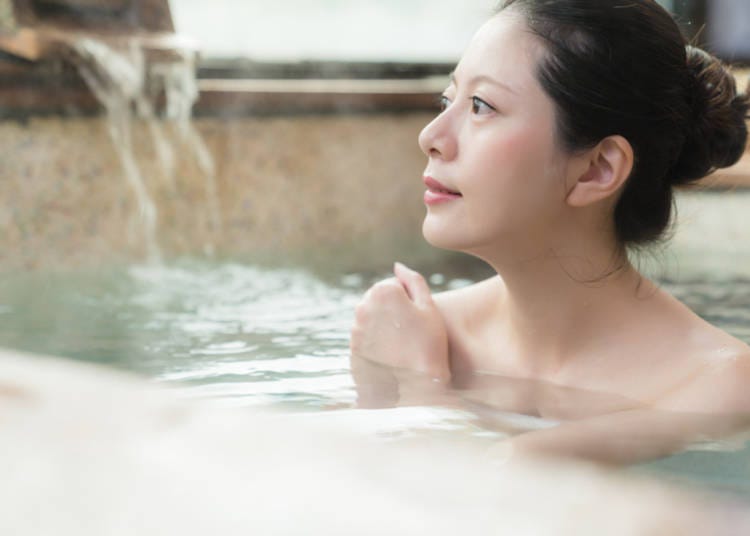
Onsen , a word that literally means " hot spring ," are natural hot water baths rich in beneficial minerals. There are various types of onsen available, including popular ones like outdoor baths ( roten-buro ) and indoor baths ( noten-buro ). A sento is a public hot bath that typically does not use naturally sourced hot water as with an onsen . In addition, there are "super sento " establishments that offer a more luxurious experience with a variety of saunas, baths, and additional services.

Onsen can be easily identified once you know what to look for. They typically have drapes ( noren ) at the entrance and are often marked with a symbol that resembles a steam rising from a hot spring (♨) or the character 湯/ゆ. Sento , on the other hand, may appear similar to onsen at first glance, but they are usually found in urban areas rather than rural ones, since they are not sourced from natural hot springs . While it is possible to find onsen in large cities, the "hot bath" symbol in an urban setting usually denotes a sento rather than an onsen .
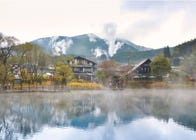
Before entering the facility
The term " onsen " can refer to both the hot spring itself and the accompanying facilities, which are often part of a hotel , resort, or traditional Japanese inn called a " ryokan ." If you plan to visit for a day and have not made a reservation, you can typically purchase a ticket from a vending machine or from a person stationed near the entrance. It's worth noting that some facilities require visitors to remove their street shoes at the entrance, providing lockers or shelves for storage. In other cases, you may remove your shoes just before entering the bathing area. When in doubt, observe others and ask the staff for guidance. If you are carrying luggage, you may want to ask the staff whether they offer temporary storage at the reception desk. However, it is generally advisable to avoid bringing large bags unless you plan to stay overnight.
Prepare for your onsen: The changing room
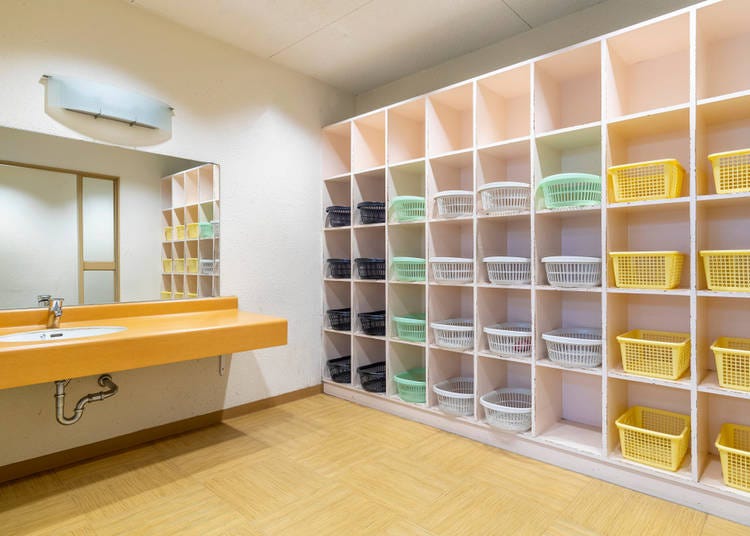
- Watch your feet - Upon entering most onsen, you’ll need to take off your shoes. Occasionally that is not the case, but you’ll always need to do so before entering the changing rooms.
- Don’t linger by the entrance – Especially if it’s the first time for you to see an onsen, the scene can be quite cool. Make sure, though, that you don’t linger by the entrance. Other people might be needing to get in or out. In Japan, physical contact is usually avoided among strangers, and when people stand by the entrance of the bath area, it feels almost like a violation of other patrons’ personal space (all of this while everybody is wearing only their “birth clothes”).
- Prepare to get naked – Clothes, swimming suits, or large towels of any kind are not allowed in the bath area. Don’t fret! No one will notice, and you’ll blend right in! You can leave all your belongings in the lockers in the changing room.
Make sure you bring a small towel with you but don’t worry if you can’t. Onsen usually allow you to use their clean towels - but it may be a paid service. Check at the entrance to the facility. Finally, note that while you can take a small towel with you into the bath area, you can't enter the water with it.
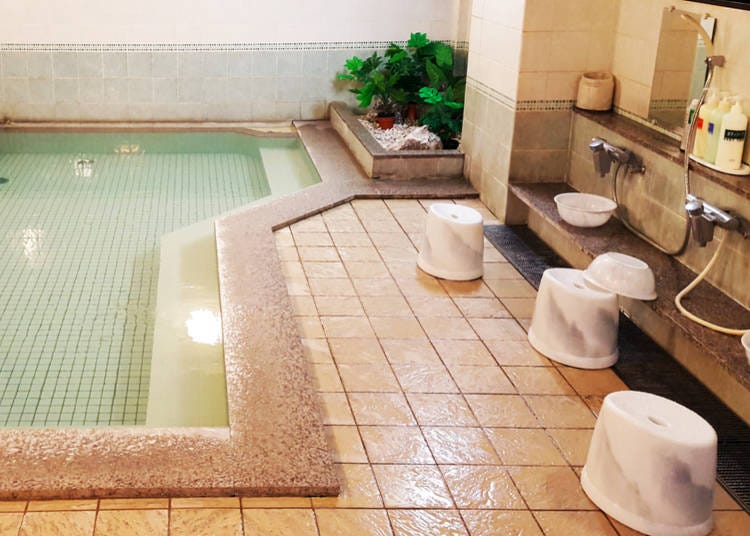
It's common practice (and courteous) to wash yourself off before entering the bath, even though you may observe some people just rinsing themselves off. If you brought your own soap, be sure to leave it neatly placed by the shower to avoid inconveniencing other visitors.
Onsen etiquette & tips: Before and after your Japanese-style bath
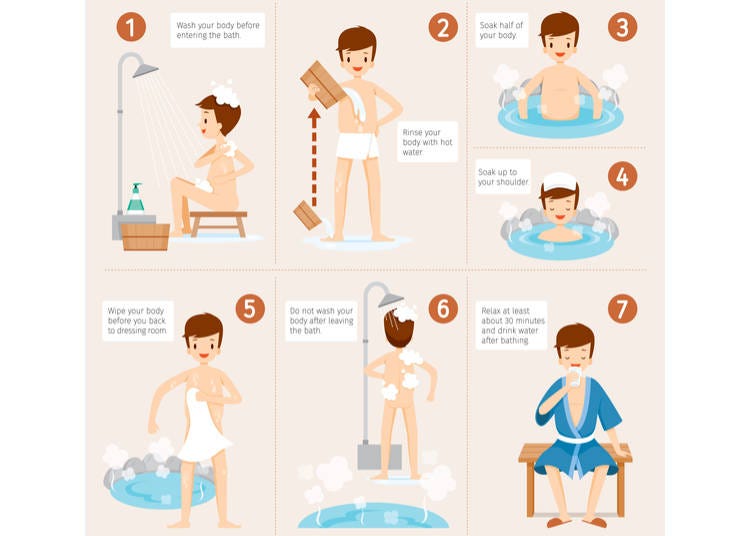
Along with all the above, some unwritten rules can often evade those who don’t go to an onsen (or sento ) frequently.
- No splashing - Once you enter the bath, it's important not to jump, dive, or splash in the water. Simply relax and enjoy the experience, which is sure to be delightful.
- Keep your phone out of the changing room - It is common sense not to take pictures or videos, but using your phone in the changing room or the bath area is generally prohibited or, at best, not appreciated. If you must use your mobile device, extend your arms fully within your locker and use it in that position.
- Tie your hair neatly - If you have long hair, make sure to tie it up securely after you shower.
- Be mindful of your surroundings - Showers in onsen are typically situated close to one another. As a result, it's important to be mindful of not splashing other individuals with water or soap. You'll be grateful when others adhere to the same rule.
- More rinsing – Some onsen have a large tub of hot water near the entrance that you can use to rinse yourself before or after entering a bath (and acclimate your skin to the temperature), or anytime you wish. To do so, simply scoop up water with a bucket.
- Keep that water flowing – Whenever you move from one bath to another in the onsen, make sure to rinse yourself. Some places also have saunas, and if you use the sauna, be sure to rinse yourself before entering a bath.
- Avoid grooming – Although some locals may trim their beards in the bath area while showering, it is generally considered impolite to engage in any grooming activities while in the onsen.
- Hey, I’m up here – In order to maintain an atmosphere that is comfortable and enjoyable for everyone, patrons tend to avoid looking (however briefly) at other patrons. It’s hard sometimes to maintain a mile-long stare in front of you when you are in a particularly beautiful place, but make sure you avoid looking (or worse yet staring) at anyone.
- Keep the chatting low – Onsen are social environments, but they are also places of relaxation and tranquility. While it's acceptable to chat with friends and family while in the bath, make sure to do so quietly.
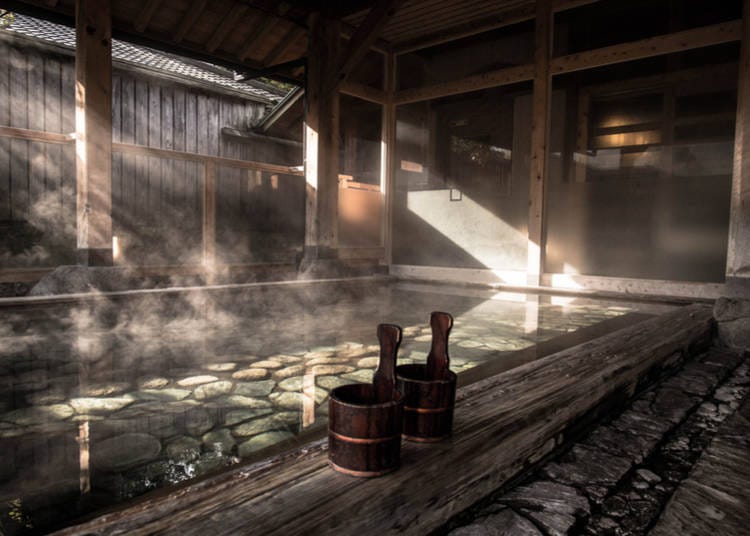
- Dry yourself - When you’re done with the bath area, you should not enter the changing room dripping wet. It can sound tricky (and it is), since the only towel you’re allowed in the bath is a very small one, but try to dry yourself best you can with it.
- Clean up – If you used buckets to wash yourself, and stools to sit on, make sure you also rinse those before leaving.
- Can I sit here? – If there are chairs or benches in the changing area, you can use them only after you’ve put some clothes on.
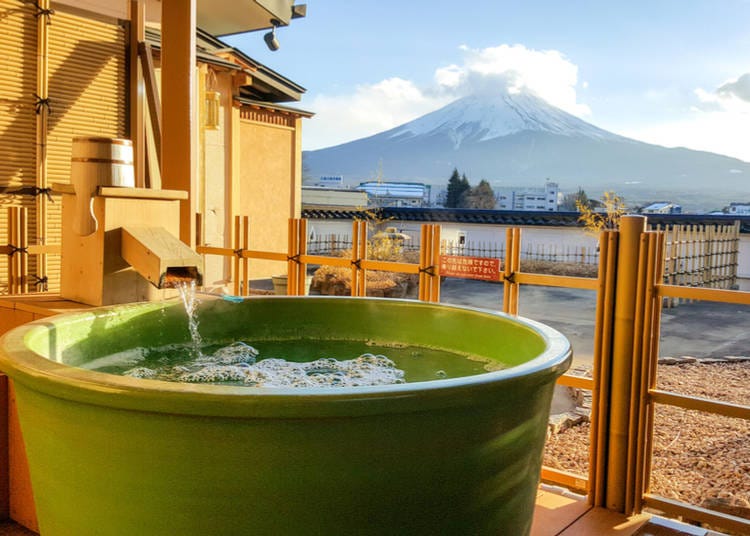
- Can I drink alcohol in the bath area? - Drinking alcohol in the bath area is not allowed due to several reasons, including health risks. However, you can drink in the lobby. After you're done, make sure to hydrate with some of the traditional Japanese beverages like coffee and milk or fruits au lait.
- What if I have tattoos? - Tattoos are often prohibited in onsen and other public places such as gyms, swimming pools, and saunas. However, if you inform the staff beforehand, they may allow you to use the facilities. They may also request you to cover them with a removable sticker. Although attitudes in Japan are changing, some onsen are already accepting tattooed patrons.
- Can you use onsen when on period? - If you happen to be on your period, women are advised not to go into an onsen bathing area.
- Are there different kinds of onsen? - Yes! Different onsen have different water sources, with different minerals and properties, each with different beneficial effects. Some have very hot water, which most people prefer, but only for a very short time. On average, onsen water is between 38 and 43 degrees Celsius, but some onsen have baths with temperatures well over 48-50 degrees Celsius.
- What kinds of areas can be found at an onsen? - An onsen typically has an indoor bath tub, a big open-air bath tub (known as a "rotenburo"), and a place for washing, with complimentary soap and shampoo products for guests to use. Some onsen may also have additional facilities like a cool-water bath or a sauna.
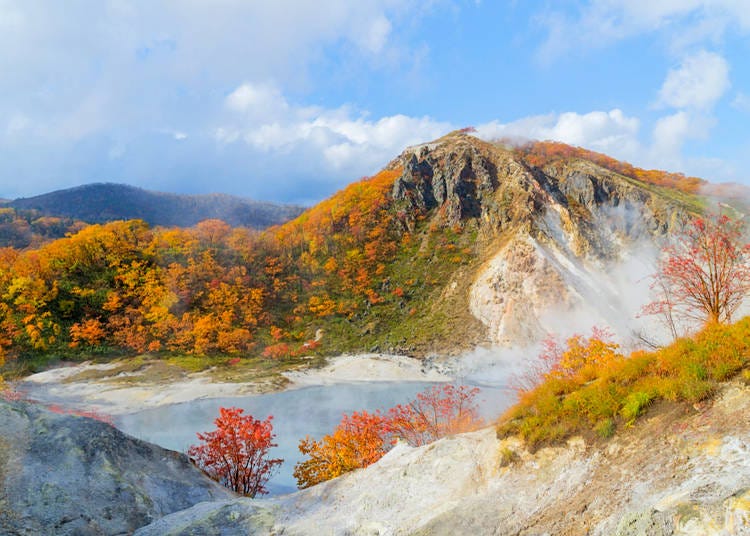
Kusatsu ( Gunma Prefecture ): This is arguably one of the most famous “ onsen towns” in Japan. Not too far from Tokyo, this area is an onsen resort with tens of baths, some of which are even free (and managed by the city or the community). Hakone ( Kanagawa Prefecture ): Hakone is the most famous onsen resort among those around Tokyo. You will be able to enjoy soothing baths and the boiling sulphur springs of Owakudani Valley. And don’t miss the beautiful Fuji- Hakone -Izu National Park , and one of the most iconic views of Mount Fuji as well as many shrines and a boat tour on Lake Ashi. Kurokawa ( Oita Prefecture): Kurokawa is a beautiful small town to journey on foot. With nature all around, and with beautiful wooden buildings, it transpires culture and history. Many of its baths are open-air, making it a very sought-after location for onsen . Some of its smaller ones are also the most historically important, located by the Kumamoto Castle , and dating back to the feudal era when many lords used to enjoy them. Noboribetsu (Hokkaido Prefecture): Noboribetsu is known for its “Hell Valley” (Jigokudani), a characteristic volcano crater that gives onsen waters unique characteristics. Sitting in a setting straight from a fantasy book, demon statues decorate the city center, and rural paths take you through the Noboribetsu Primeval Forest and to amazing views of Lake Kuttara.
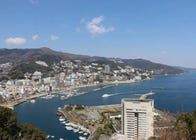
Experience the ultimate relaxation and rejuvenation at the best onsen resorts in Japan. Discover the unique properties of different mineral-rich waters and unwind in a variety of indoor and outdoor baths on an onsen tour!

Visitors to Japan should not miss the opportunity to visit an onsen and experience the unique and therapeutic properties of its waters. With a variety of onsen destinations throughout the country, there's something for everyone, from bustling onsen towns to tranquil, secluded locations surrounded by natural beauty . Be sure to check out the following articles for more information on onsen in Japan!
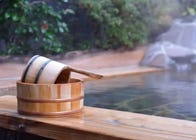
Lucio Maurizi is an automotive expert specializing in Japan's car scene and auto-tourism. With an MA in East Asian History from La Sapienza Università di Roma, he's a multi-talented contributor to travel platforms like LIVE JAPAN, Japan Travel, and GPlus Media. His Instagram account (50k+ followers) offers insider views on Japan's automotive culture. Lucio also actively collaborates with professional drivers and influencers and organizes can't-miss car events in Tokyo.
- Category Hot Springs (Onsen) & Bath Houses (Sento)
- How To: Etiquette
Share this article.

Recommended places for you

KYOTO TAKENOSATO ONSEN MANYO NO YU
Hot Springs (Onsen) & Bath Houses (Sento)
Kyoto Station, To-ji Temple

Yoshida Gennojo-Roho Kyoto Buddhist Altars
Nijo Castle, Kyoto Imperial Palace

ISHIDAYA Hanare
Kobe, Sannomiya, Kitano

Rukku and Uohei
Sapporo / Chitose

Kamesushi Sohonten
Umeda, Osaka Station, Kitashinchi

Jukuseiniku-to Namamottsuarera Nikubaru Italian Nikutaria Sannomiya

Explore Japan for Free? Japan Airlines Offering Free Domestic Flights for International Travelers

Visiting Japan in September - The Best Things to Do and Reasons to Visit
by: James Davies

Japanese Insect Repellent for Adults and Kids – Drugstore Staff Recommend Gentle and Effective Products
by: Cassandra Lord

Taste the Season: 6 Cozy Fall Afternoon Teas to Enjoy at Tokyo Hotels (2024)

Savor the Season: Muscat Grape Afternoon Teas to Try in Tokyo This Fall

13 Must-Try Restaurants in Harajuku (Tokyo): Sushi Flagship, Ichiran Ramen, Must-Try Crepes, and More Where Fashion and Food Meet!
by: Tiffany YU

3 Gorgeous Onsen in Niseko: Soaking Spots in Japan's Wild North

Japanese Foods List: 16 Crazy Tasty Japanese Tohoku Region Dishes You've Never Heard of

Enjoy Winter at Hoshino Resorts Aomoriya and Oirase Keiryu Hotel: Gorgeous Ice-falls and Lanterns Decorate Open-air Onsen Baths!

Osaka Spa World: Inside The Insane Onsen Complex!

JR Edition: Visit all of Tokyo in one Day with the Tokyo Metropolitan District Pass!

Plan Your Visit to Zao Onsen (Yamagata) - A Comprehensive Guide
- #best sushi japan
- #what to do in odaiba
- #what to bring to japan
- #new years in tokyo
- #best ramen japan
- #what to buy in ameyoko
- #japanese nail trends
- #things to do japan
- #onsen tattoo friendly tokyo
- #best coffee japan
- #best japanese soft drinks
- #best yakiniku japan
- #japanese fashion culture
- #japanese convenience store snacks
How to Take a Japanese Onsen: Do’s and Don’ts
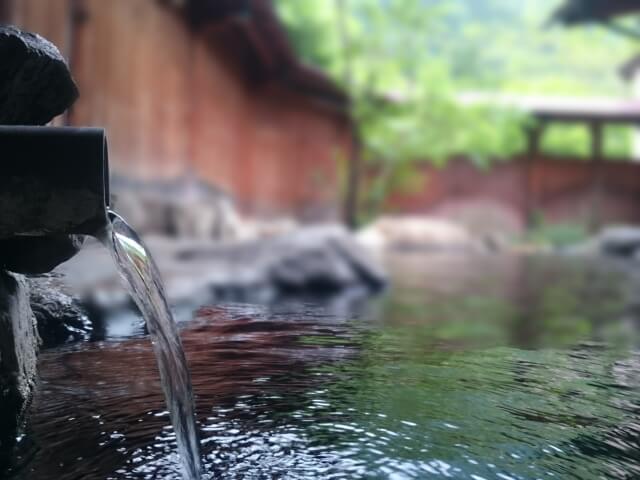
When asked about their favorite thing in Japan, many people will probably answer the friendliness of the Japanese, the food and also onsen. Indeed, taking an onsen, a geothermally heated spring filled with water that contains several minerals beneficial to the body, is a must-try activity for tourists as it is completely different from taking a bath in other countries around the world. It is the ultimate activity to relax after a day filled with discovering the nature and culture of Japan.
Japanese have been enjoying onsen since before records were kept. Japan is blessed with over 30,000 natural onsen and there are over 3,000 onsen resorts in Japan. Onsen can be either attached to a hotel or ryokan or public accessible. Generally speaking, onsen are separated by gender (through partitions or bathing times) and often they have multiple bathing areas (indoor and outdoor).
Onsen are not water parks or bathhouses, where people can play freely. There are several written and unwritten rules and everyone should follow these rules when they take an onsen. As a tourist, you probably have little or no experience in taking an onsen in the Japanese way and don’t know the do’s and don’ts when taking an onsen. Let us teach you the proper and respectful way of taking an onsen.

1. Check the gender section by the curtain
2. take off your shoes before entering the dressing room, 3. take off all of your clothes in the dressing room, 4. wash your body first, 5. enter the bath slowly , do not run or swim, do not soak your towel or hair in the onsen, do not soak for too long, wipe your body off before entering the dressing room, stay and relax after your dip, let’s take an onsen, other articles that you might like:, how to take an onsen .
Onsen is usually separated into male and female sections. You can distinguish the sections by the curtains at the entrance. Often there is no English translation written on the curtains, but only Japanese 男/男性 (male) and 女/女性 (female). If you are lucky you can also recognize the section by the color of the curtains; red for women and blue for men.

Onsen facilities are usually structured as follows: entrance, reception, dressing room, bathing area and resting area. When you are at the front entrance, you need to take off your shoes and slippers here. When you find slippers placed at the entrance, you can wear them when you walk from the reception and dressing room and back. Sometimes there is a designated area to put your shoes, for example lockers in the dressing room or you may give your shoes to the staff. If you don’t know what to do with your shoes, just copy what the locals are doing.
Although swimsuits are allowed in a select few onsen, this is very rare. In most onsen, you take off all your clothes in the dressing room. Clothing and garments that are worn outside are considered sullied and should never be brought into an onsen. Nudity is a must for taking an onsen. You may feel embarrassed being naked at first, but you’ll find everyone is naked and everyone minds their own business. Nudity in an onsen is not embarrassing at all, in fact you will probably feel more embarrassed being the only one wearing a bathing suit. If you feel uncomfortable being naked, you can use your small towel to hide your private parts when you are moving from dressing room to bathing area and back again.
The bathing area consists of two areas; the washing area and the onsen area. You need to wash and rinse your body in the washing area first before getting in the bathtub. Facilities usually provide free shampoo, rinse and body soap. But you can also bring your own if you’d like.
Finally when you are ready to soak in the onsen, enter the bath slowly. Some onsen are really hot, and it takes time to get used to the temperature of the water. Avoid hopping in the onsen all at once. It is better to gradually sink into it. Also it’s beneficial to pour warm water over your body first (starting with your wrists and ankles, then arms, legs, lower back and shoulders) using a wooden pail to prevent the sudden rise of blood pressure. This is called kakeyu (掛湯), and there’s a water basin where you can pour the warm water especially for this.
Things not to do at an onsen

You should not run, only walk slowly inside the bathing area because the floor may be very slippery. Moreover, you are not allowed to swim even if the onsen is big like a swimming pool. The main purpose of taking an onsen is not only to warm up your body but also to rest and relax so please enjoy the onsen quietly.
When you are taking an onsen, you should not dip your towel in the water because it is considered dirty. You can put your towel on your head so that you won’t lose it easily and it also won’t dirty the water. If you have long hair, you should tie your hair back to prevent it from dipping in the water.
As relaxing as it may be, don’t stay in the onsen for too long. You should get out of the onsen when your forehead gets sweaty or if you start to feel a little dizzy. Also, unless you have sensitive skin, you had better not wash your body after taking onsen in order to let the onsen minerals take effect.
You might have the heart of this but tattoos are still a taboo in Japan. Tattoos are associated with crime; back in the day, people who committed a crime were marked with a tattoo. Later, during the Edo period, many gang members marked themselves with tattoos to show their courage and pain endurance.
If you have a large tattoo, you will probably be rejected at most onsen. If you have got smaller tattoos, some onsen will allow you to cover them and enter the bath. But if you have a lot or big tattoos from head to toe, your best option is to book a private onsen through a ryokan. Some onsen such as Uramigataki Onsen in Tokyo and Funaoka Onsen in Kyoto are specifically geared for foreigners and more lenient when it comes to tattoos.

After the onsen
Before entering the dressing room, you should wipe yourself off lightly with your small towel. After wiping your body completely with your bath towel, you can put your own clothes or the yukata on again that you will find at most ryokan. A yukata is bathing clothing, and looks similar to a kimono.
After putting on your clothes or yukata, you can relax in the lounge area. From comfortable massage chairs and glasses of sake to small bars, these facilities are the cherries on top of the onsen cake. While relaxing in the lounge area, you should rehydrate because you might have sweat a lot in the onsen. The best way to hydrate is to drink a bottle of cold milk or yogurt!
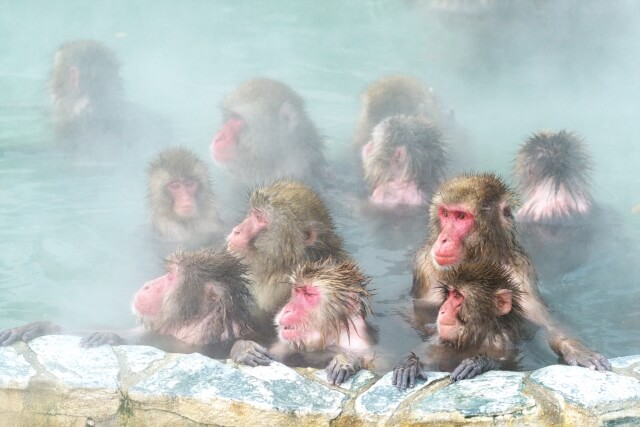
By taking an onsen, not only can you wash your body, but you can also relax and relieve your stress from study or work. If you want to have some local experience during your trip in Japan, you definitely need to try to take an onsen. It is the perfect relaxing ending to your busy sightseeing day. Even the snow monkeys in Nagano know it ;)
As we mentioned before, there are many onsen in Japan, both natural or man-made. You can choose the one you like. But if you don’t have any idea which onsen to go to, why don’t you join our Niigata 1-Day Customised Private Walking Tour ?
In our Niigata 1-day tour, not only can you take the famous Senami Onsen, but you can also enjoy tasting high-grade Japanese sake and fresh seafood and learn about the Japanese history and culture at the old port-city Niigata. Since it is a customized tour, you can discuss with our professional tour guide and plan your own tour.
About the tour Duration: 7 hrs ( 9am – 4pm ) Price: ¥35,000 per group Capacity: 4 persons (If you would like more people, please let us know.)
Follow us on Instagram or Facebook for more travel inspiration. Or tag us to get featured!
Happy travelling!

- Popular destinations
- Hidden places in Japan
- Tours and workshop
- Food and drink in Japan
- Itinerary in Japan
- Places to visit in Tokyo
- Food and drink in Tokyo
- Seasonal events
- Tours & workshops
- Tokyo This Week
- Day trip from Tokyo
- Itinerary in Tokyo
- Places to visit in Kyoto
- Food and drink in Kyoto
- Itinerary in Kyoto
- Day trip from Kyoto
- Travel tips
- Accommodation
- Cultural tips
- Transportation
- Tokyo Tours
- Kyoto Tours
- Kimono Rental
- Fukushima Tours
- Mount Fuji Tours
- Tour Package
- Travel Concierge Service
- Media Kit(English/日本語)
- Tokyo Cheapo (繁體中文)
Japan's Best Destination Onsen
Visiting an onsen is a highlight of any trip to Japan. Fortunately they can be found just about anywhere and everywhere, meaning you should have no trouble fitting a soak into your itinerary.
Here are five top destinations, with bonus advice on which itineraries they work best for — though there’s nothing wrong with doing it the other way, and basing your whole trip around particular springs. With a JR Pass you can travel with little to no additional cost. Learn about the different rail pass options before choosing the right one for your trip.
Not sure if onsen are ready to take the plunge? Check out our guide on bathing tips . Prefer to stay closer to Tokyo? We’ve got a guide for that , too.
Kinosaki: A picturesque stop between Kyoto and Hiroshima

A Kansai-based onsen town in Hyogo Prefecture, Kinosaki is up there when it comes to picturesque spots in which to soak. The town surrounds a central canal lined with willow trees and is a traditional spot with guests wandering the streets in yukata (cotton kimono-like robes) each evening.
With a reputation for healing waters, many baths have been built where legend suggests the injured would bathe wounds in marshes. There are plenty of public bathhouses to choose from, as well as free public foot baths ( ashi-yu ) to enjoy as you explore. The public baths range from small and traditional to large and modern, so you can see which you like best. There are outdoor cave baths at Ichino-yu, waterfall views at Goshono-yu, and private family baths available at Jizo-yu.
If you’re staying for a while, you can go kayaking in a geopark, try snorkeling, make soba noodles, and even go on a lava-flow hiking course, so you certainly won’t be bored.
Getting there : From Tokyo the journey takes about 5 hours (a little longer if you’re on the JR Pass and can’t take the faster Nozomi trains) and requires two changes at Kyoto and Fukuchiyama, so it works better if you’re visiting Kyoto or Osaka already.
Kinosaki is two and a half hours from Kyoto and a great stop if you’re heading down to see the sand dunes of Tottori (two hours), the castle in Himeji (three hours), or going straight through to Hiroshima (4–5 hours). These routes can all be done on the JR Pass and require minimal changes, as Kinosaki Onsen Station is well connected.
Gero: A great pitstop for the gassho houses of Shirakawago

Definitely not one of the most scenic onsen towns, but Gero ‘s reputation carries it through as it was mentioned as one of Japan’s top three onsen by the Confucian poet Hayashi Razan . The town name may also be slang for vomit, but don’t let you put that off (although we’re glad to have found that out after our visit, since it definitely doesn’t help).
Locals are less temperamental, however, and it is still really popular, with plenty of ryokan and public baths available. Once there, you can purchase a wooden Yumeguri Tegata spa pass which grants access to three different onsen (from around 30). Purchase the pass at the tourist office and see brochures of which you would like to visit. A perk of Gero is its proximity to Shirakawago and Takayama , so it is an easy one to fit into your schedule as an overnight stop.
Getting there: Gero is in Gifu Prefecture. From Tokyo it takes roughly 3.5 hours by train via Nagoya and Gifu, costing between ¥ 12,950 to ¥ 14,140 . If you’re leaving from Nagoya, it’s only an hour and a half by the Hida Wide View (extra wide windows to enjoy the view!) train. Both journeys are fully covered by the JR Pass and you can travel to Takayama in under an hour if you are on your way to see Shirakawago’s gassho houses.
Beppu: A relaxing break near Nagasaki

A destination in itself, the onsen here are nicknamed the Eight Hells of Beppu and are genuinely filled with varying horrors like crocodiles and a blood pond. But don’t let that put you off — there are some normal ones, too. There are eight different hot spring sources here, each with their own public baths and ryokan.
Beppu, which is in Oita Prefecture, in Kyushu, produces more hot spring water than anywhere in the country, so your biggest problem might be choosing where to start. Once you’re bored of the water, why not relax in hot sand baths at Beppu beach or soak in some mud?
We recommend starting at Hyotan Onsen, a public bath with an impressive range of massaging waterfalls, as well as both indoor and outdoor pools, for only ¥ 780 . The best-known onsen in town is the picturesque Takegawara, which was built in 1879 and offers an old-fashioned interior for a traditional soak. To visit the eight hells, you can catch a bus and choose a couple or visit them all — check out our guide for tips. If you would like a prettier onsen experience, try nearby Yufuin ; it’s small, tree-lined, and traditional.
Getting there: If you’re traveling direct from Tokyo, it will take just over 6 hours by train with a transfer at Kokura. Beppu is 2 hours from Hiroshima (covered by the JR Pass) and from there it’s a 4-hour journey to Nagasaki (also covered). Admittedly you could just go straight to Nagasaki in 2.5 hours, but Beppu is well worth the extra time!
Noboribetsu Onsen: An emerald green onsen in Hokkaido

If you find yourself up north, perhaps for the famous snow festival , this is an onsen town too good to miss. The hot springs here release up to 10,000 tons of water each day, and it’s the perfect place to warm up on the coldest of Japan’s major islands.
You can visit the source of the water, nicknamed Hell Valley. The area has 11 different types of water, with most onsen offering a choice. Daiichi Takimotokan has the biggest range, with seven different kinds, and is a very modern space to relax in. There is only one public bath, the Sagiriyu, which has two types of water and is by far the cheapest option in town.
Getting there: On the JR Pass you can travel by train all the way from Tokyo to Noboribetsu Station via Shin-Hakodate-Hokuto, which takes seven hours, before catching a bus for 15 minutes to the onsen area. If you’re in Hokkaido already, it’s a mere one hour and 20 minutes from Sapporo by limited express to the station. See our guide on getting from Tokyo to Hokkaido .
Dogo Onsen: A detour to Shikoku from Hiroshima

Officially Japan’s oldest spa, Dogo Onsen dates back 3,000 years and is thought to be the inspiration for the bathhouse in Hayao Miyazaki’s animated classic Spirited Away . Designated as an important cultural asset, the bathhouse is located in Matsuyama, the capital of Ehime Prefecture on the island of Shikoku.
The impressive wooden structure is a sight in itself, with a castle-like presence and a watchtower which rings three times a day. It is open to the public as well as the Imperial Family, who have their own private yushinden (bath room) — one of a kind in Japan. You can’t use this, of course, but there are sightseeing tours available if you want a taste of imperial standards. The surrounding area is great for a stroll, with an old-fashioned shopping arcade and a traditional clocktower with puppets emerging on the hour.
Getting there: You can hop across the waters from Hiroshima by ferry if you are sans-JR Pass and prefer boats — choosing between a 2.5 hour journey on the cruise ferry ( ¥ 4,500 one way) OR just over an hour on the Super Jet ( ¥ 7,800 one way).
Japan Rail Pass holders can catch the bullet train to Okayama and from there catch a limited express to Matsuyama, which takes just over three hours. Making time in your itinerary to explore Shikoku is definitely recommended, with stunning mountains, the Shikoku pilgrimage, and the vine bridges of the Iya Valley all making for incredible adventures.
Note: Starting in 2019, and estimated to take about seven years, Dogo Onsen Honkan is undergoing renovation works. At no point will the entire facilities be closed; however, access will be limited. Currently only the Tama no Yu bath on the first floor is open. The official website has progress reports on the work and reopenings.
- Hot springs
Get the best Japan Cheapo hacks direct to your inbox

All-Gender Hot Spring Guide
Where to find non-binary and trans-inclusive onsen in Japan.

Kyoto One-Day Itinerary: Fushimi Inari and Beyond
Spend the day exploring the famous Shinto shrine, doing sake tasting, and more.

How To Spend a Week in Beautiful Hokuriku
Explore Japan’s “rainbow route” with us.

New Video! Kanazawa Guide: 2-Day Trip
For Japanese history, beautiful gardens, and delicious local food all in one peaceful location.

10 Very Best Things To Do in Kobe
Eat, drink, be merry — and maybe climb a famous mountain.

Best Places To Stay in Nara
Because this beautiful city deserves to be more than just a day-trip destination.

Complete Guide to the Hokkaidō Shinkansen
Where to go and what to do along Japan's northernmost bullet-train route.

9 Things To Do in Fukui
Explore the shiny new stop on the Hokuriku Shinkansen — an easy trip from Tokyo.

11 Best Places to See Cherry Blossoms in Japan
Riverside paths, real castle moats, pagodas and more.

Osaka to Tokyo: The Fastest and Cheapest Ways to Get There
Handy information on your travel options between the two cities.

The Survival Guide to Kyoto Station
Bookmark this for easier travels.

5 Reasons To Visit Ishikawa
The prefecture extends a warm welcome, as part of its efforts to rebuild in the wake of the Noto earthquake.

Close without accepting
- Today's deals
- Search travel guides

The Ultimate Guide to Hokkaido Hot Springs: Japan’s Best Onsen Retreats
Hokkaido, Japan’s northernmost island, is renowned for its stunning landscapes, rich cultural heritage, and, above all, its exceptional hot springs. Whether you’re seeking relaxation, therapeutic benefits, or an authentic Japanese onsen experience, Hokkaido offers an unparalleled array of hot springs to explore. In this guide, we’ll dive into the best hot springs in Hokkaido, from famous onsen towns to hidden gems nestled among nature.

1. Jozankei Onsen: A Serene Escape in Nature
Set amidst the picturesque mountains of the Shikotsu-Toya National Park, Jozankei Onsen is a charming hot spring town just an hour’s drive from Sapporo. Known for its lush forests, soothing rivers, and therapeutic waters, Jozankei Onsen offers a serene escape from city life.
The onsen town boasts numerous ryokan (traditional Japanese inns) and hot spring resorts that provide open-air baths, also known as rotemburo , allowing guests to soak in the warm waters while enjoying breathtaking views of the surrounding nature.
2. Noboribetsu Onsen: The Hell Valley of Healing Waters
Noboribetsu Onsen is arguably the most famous hot spring destination in Hokkaido. Situated within the Jigokudani (Hell Valley), this area is known for its volcanic activity, which results in an array of beneficial minerals in the hot spring waters.
Visitors can explore the scenic Hell Valley, where steam vents and sulfurous streams create a dramatic landscape, before retreating to one of the many onsen resorts for a rejuvenating soak. Hotels such as Dai-ichi Takimotokan and Hotel Mahoroba are popular choices for their extensive bathing facilities and stunning views.
3. Toyako Onsen: Lakeside Relaxation
Located on the shores of Lake Toya, Toyako Onsen offers a unique hot spring experience with the added beauty of a caldera lake. This area is perfect for those seeking both relaxation and outdoor recreation.
Guests can indulge in the therapeutic hot springs at local ryokan, take a scenic boat cruise on the lake, or hike around Mount Usu, an active volcano providing spectacular views of the region. Toyako Onsen is also famous for its nightly firework displays during the summer months.

4. Yunokawa Onsen: Historical Bathing Experience
Located in Hakodate, Yunokawa Onsen is one of Hokkaido’s oldest and most prestigious hot spring areas. Renowned for its high-quality waters and historical significance, Yunokawa Onsen offers a blend of traditional Japanese bathing culture and modern amenities.
The area is home to numerous luxurious ryokan and hotels that provide serene garden views and exquisite dining options. It’s an ideal destination for those seeking both relaxation and cultural immersion. A unique feature of Yunokawa Onsen is the opportunity to visit the Yunokawa Hot Spring for Monkeys, where you can see Japanese macaques enjoying the warm waters during winter.
5. Sounkyo Onsen: Scenic Gorge Retreat
Sounkyo Onsen is nestled in the Daisetsuzan National Park, surrounded by the dramatic cliffs and waterfalls of the Sounkyo Gorge. This area is known for its spectacular scenery, making it a perfect hot spring retreat for nature lovers and hikers.
Visitors can enjoy open-air hot spring baths with stunning views of the gorge, explore the nearby waterfalls such as the Ginga and Ryusei falls, and delve into the area’s rich flora and fauna. Sounkyo Onsen also offers convenient access to Mount Kurodake, a popular spot for trekking and skiing.
6. Kawayu Onsen: Hidden Gem in Akan National Park
Kawayu Onsen is a lesser-known but equally enchanting hot spring destination located in Akan Mashu National Park. This secluded spot is famous for its sulfuric hot springs sourced directly from the volcanic Mount Io, ensuring a truly authentic onsen experience.
Visitors can enjoy the therapeutic properties of the highly acidic waters while soaking in traditional baths or rotemburo. The area also offers opportunities to explore the untouched beauty of the national park, visit Lake Mashu, known for its crystal-clear waters, and hike around the active Mount Io.
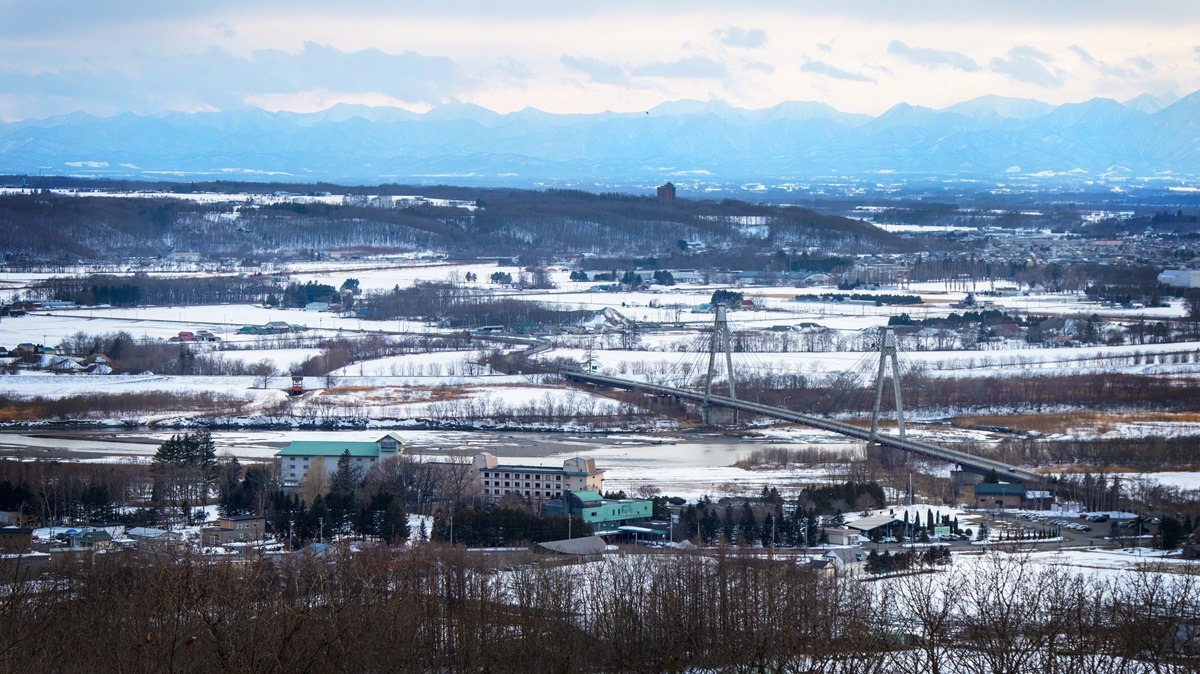
7. Tokachigawa Onsen: Moor Hot Springs
Tokachigawa Onsen, situated in the Tokachi region, is unique due to its moor hot springs, which are rare even within Japan. The hot springs here are derived from plant-based organic matter and are known for their skin-beautifying properties.
Surrounded by serene agricultural landscapes, Tokachigawa Onsen is perfect for those looking to rejuvenate their bodies and minds. The area features top-notch ryokan and wellness facilities, making it a sought-after destination for relaxation and natural beauty treatments.
You may also like

Top Things to Do in Abu Dhabi: A Comprehensive Guide to Experiencing the City's Best Attractions

Exploring Tap Room Bamboo Hills: A Hidden Gem in Kuala Lumpur's Lush Urban Oasis
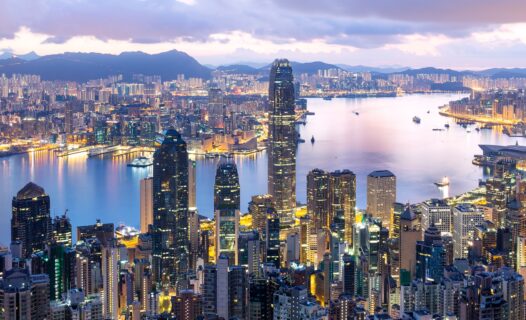
Experiencing the Chung Yeung Festival in Hong Kong: Traditions, Activities, and Hidden Gems
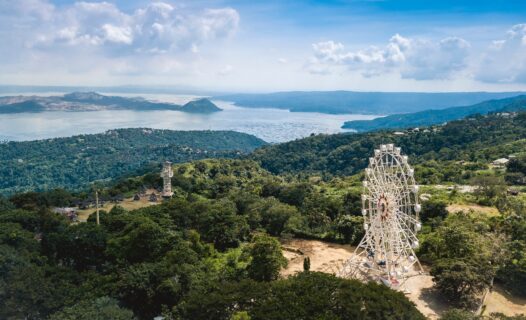
Top Attractions to Visit in Tagaytay: A Complete Travel Guide to the City's Best Spots
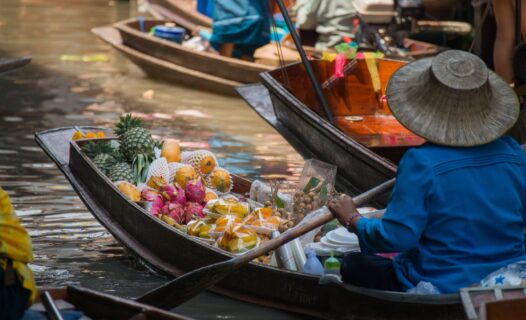
Exploring Bangkok's Best Floating Markets: A Guide to Vibrant Canal-based Commerce and Culture

Embrace the Rain: Your Ultimate Travel Guide to Thailand During the Rainy Season
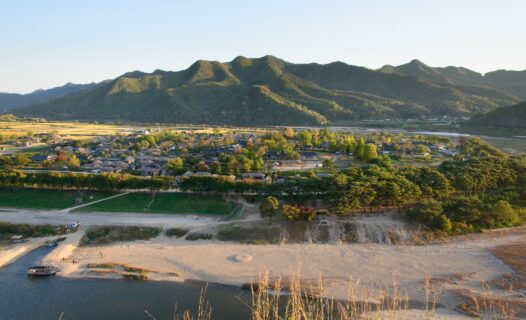
Discover the Best Places to Visit in South Korea: A Comprehensive Travel Guide

Savoring Osaka: A Culinary Guide to the Best Eats in Japan’s Kitchen
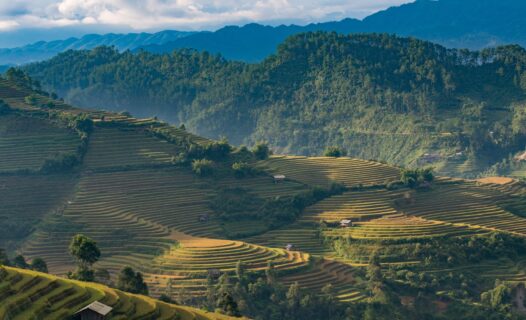
Exploring the Best Hotels in Sapa: A Guide to Luxurious Stays in Vietnam's Mountain Paradise
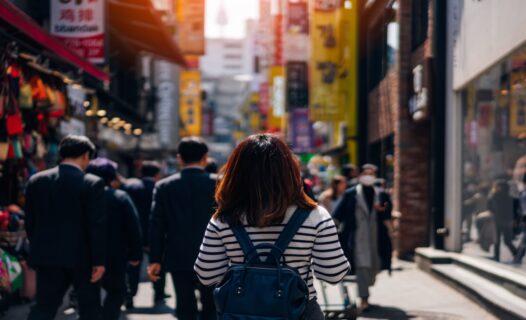
Exploring Hongdae: Discover the Heartbeat of Seoul's Art, Culture, and Nightlife
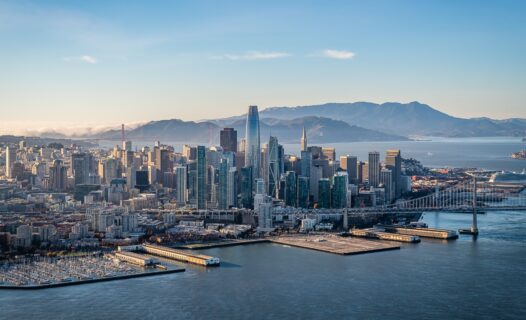
Unforgettable Things to Do in San Francisco: The Ultimate Travel Guide

Romantic Date Spots in Taipei: Unforgettable Moments in the Heart of Taiwan

Experience the Thrills of Sports Day in Osaka: A Comprehensive Guide to the Excitement, Activities, and Culture
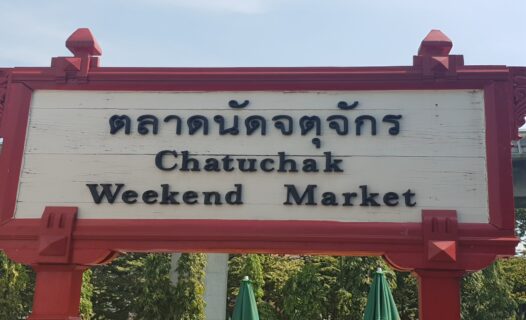
Ultimate Guide to Bangkok's Chatuchak Weekend Market: Shop, Eat, and Explore

Exploring Battleship Island: Unveil the Haunted Beauty and History of Hashima Island, Japan
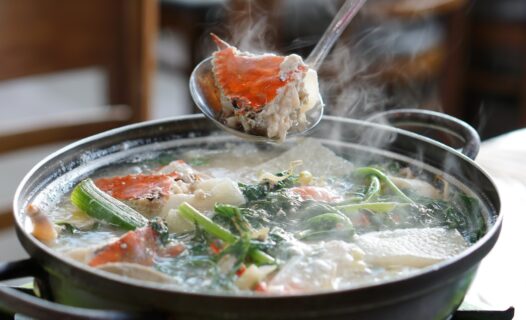
Top Culinary Destinations: Where to Eat in Busan

Solo Adventures in Ho Chi Minh City: Top Activities and Must-See Sights

Understanding the Cost of Living in Singapore: Essential Tips for Travelers and Expats

Ultimate Guide to the Best Steamboat and Grill Spots in Kuala Lumpur
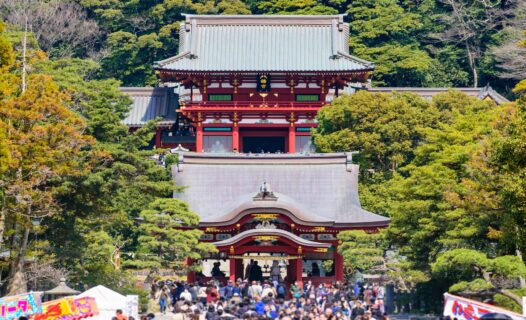
Unveiling Kamakura: Must-Do Activities for a Perfect Getaway

Top Things to Do in Abu Dhabi: A Comprehensive Guide to Experiencing the City's Best Attractions
Discover the best things to do in Abu Dhabi with our comprehensive travel guide. Explore top attractions like Sheikh Zayed Grand Mosque, Louvre Abu Dhabi, and more!

Exploring Tap Room Bamboo Hills: A Hidden Gem in Kuala Lumpur's Lush Urban Oasis
Discover the charm of Tap Room Bamboo Hills in Kuala Lumpur, featuring unique dining experiences, craft beers, and lush surroundings. Your ultimate travel guide to Bamboo Hills KL!

Discover everything you need to know about experiencing the Chung Yeung Festival in Hong Kong. From traditions and activities to hidden gems, our guide covers it all.

Top Attractions to Visit in Tagaytay: A Complete Travel Guide to the City's Best Spots
Explore the top attractions in Tagaytay with our complete travel guide. Discover must-visit places, hidden gems, and travel tips for an unforgettable trip.

Exploring Bangkok's Best Floating Markets: A Guide to Vibrant Canal-based Commerce and Culture
Discover the best floating markets in Bangkok through our detailed guide. From Damnoen Saduak to Amphawa, explore Thailand's vibrant canal commerce, food, and culture.

Discover the charm of Thailand during the rainy season. This ultimate travel guide offers tips, activities, accommodation suggestions, and more to make the most of your monsoon adventure.

Explore the best places to visit in South Korea with our comprehensive travel guide. Discover top destinations, attractions, and tips for a memorable trip to Korea.

Discover the ultimate Osaka food guide, exploring famous foods, street eats, top restaurants, and local delicacies in Japan’s kitchen.

Exploring the Best Hotels in Sapa: A Guide to Luxurious Stays in Vietnam's Mountain Paradise
Discover the best hotels in Sapa, Vietnam, from luxury stays to budget-friendly options. Explore the top accommodations and plan your perfect stay in Sapa.

Exploring Hongdae: Discover the Heartbeat of Seoul's Art, Culture, and Nightlife
Dive into the vibrant world of Hongdae, Seoul's hotspot for art, culture, nightlife, and youth culture. Discover the best things to do, eat, and see in this dynamic and energetic district.

Explore the top attractions and must-see places in San Francisco with this comprehensive travel guide. Discover insider tips and unforgettable activities for your next visit.

Explore the most romantic date spots in Taipei, from scenic views to intimate dining experiences, ensuring an unforgettable time with your loved one.

Discover the excitement of Sports Day in Osaka with our comprehensive guide, featuring top events, activities, and cultural insights. Plan your trip today!

Ultimate Guide to Bangkok's Chatuchak Weekend Market: Shop, Eat, and Explore
Discover the ultimate guide to Bangkok's Chatuchak Weekend Market including shopping tips, dining recommendations, and insider secrets.

Dive into the haunting beauty and rich history of Battleship Island (Hashima Island) in Nagasaki, Japan. Discover tours, historical context, and travel tips.

Discover the best places to eat in Busan, from traditional Korean dishes to contemporary dining spots. Explore our detailed guide for food lovers traveling to Busan.

Discover the best solo travel activities in Ho Chi Minh City. From historical sites to vibrant markets, this guide offers top tips for an unforgettable solo adventure.

Discover essential tips on the cost of living in Singapore for travelers and expats. Learn about housing, food, transportation, healthcare, and more.

Discover the top steamboat and grill spots in Kuala Lumpur with our ultimate guide. Enjoy local flavors, halal options, and the best dining experiences the city has to offer.

Discover the top activities and sights in Kamakura. From historical temples to thrilling adventures, this travel guide has everything you need for an unforgettable trip.
Last Updated: September 18, 2024
Current language
All languages.
The Magic of Hakone Onsen: Must-Visit Hot Springs in Hakone, Japan

9 Must-Visit Onsen in Hakone for the Ultimate Relaxation
Ready for relaxation hakone’s onsen await.
Just a short distance from Tokyo, Hakone is a serene destination renowned for its stunning landscapes and rejuvenating hot springs. This area has long been a favorite retreat for locals and travelers seeking relaxation in a natural setting. From traditional Japanese inns offering private baths to larger resorts with public baths, Hakone provides a wide range of onsen experiences.
In this post, we'll guide you through some of the best hot springs in Hakone, helping you discover the perfect spot to unwind and enjoy the therapeutic benefits of these natural waters.
1. Hakone Yuryo

Hakone Yuryo is a famous hot spring resort located near Hakone Yumoto Station. This onsen is known for its relaxing atmosphere and variety of bathing options. Visitors can enjoy both indoor and outdoor baths surrounded by nature, offering a peaceful retreat from the busy city life. The resort also provides private baths, making it a great choice for couples or families who prefer a more private experience.
A free shuttle bus from Hakone Yumoto Station is available, making it easily accessible for day trippers. The onsen also has a traditional Japanese restaurant where you can enjoy a meal after your bath. With its convenient location and excellent facilities, Hakone Yuryo is a top choice for anyone looking to experience the magic of Hakone's hot springs.
Address: 4 Tonosawa, Hakone, Ashigarashimo District, Kanagawa
Price: Starting from ¥1,500 for a public bath
2. Tenzan Onsen
Tenzan Onsen is one of Hakone's most famous hot springs, known for its natural beauty and traditional Japanese architecture. The onsen features a variety of outdoor baths, each set in a stunning natural environment, allowing you to soak while surrounded by lush greenery and the sounds of nature.
The baths are made from stone and wood, giving the place an authentic feel. Tenzan Onsen is also unique because it has a “kashikiri buro” system, where guests can rent private baths. This onsen is perfect for those who want a quiet, relaxing experience without the crowds.
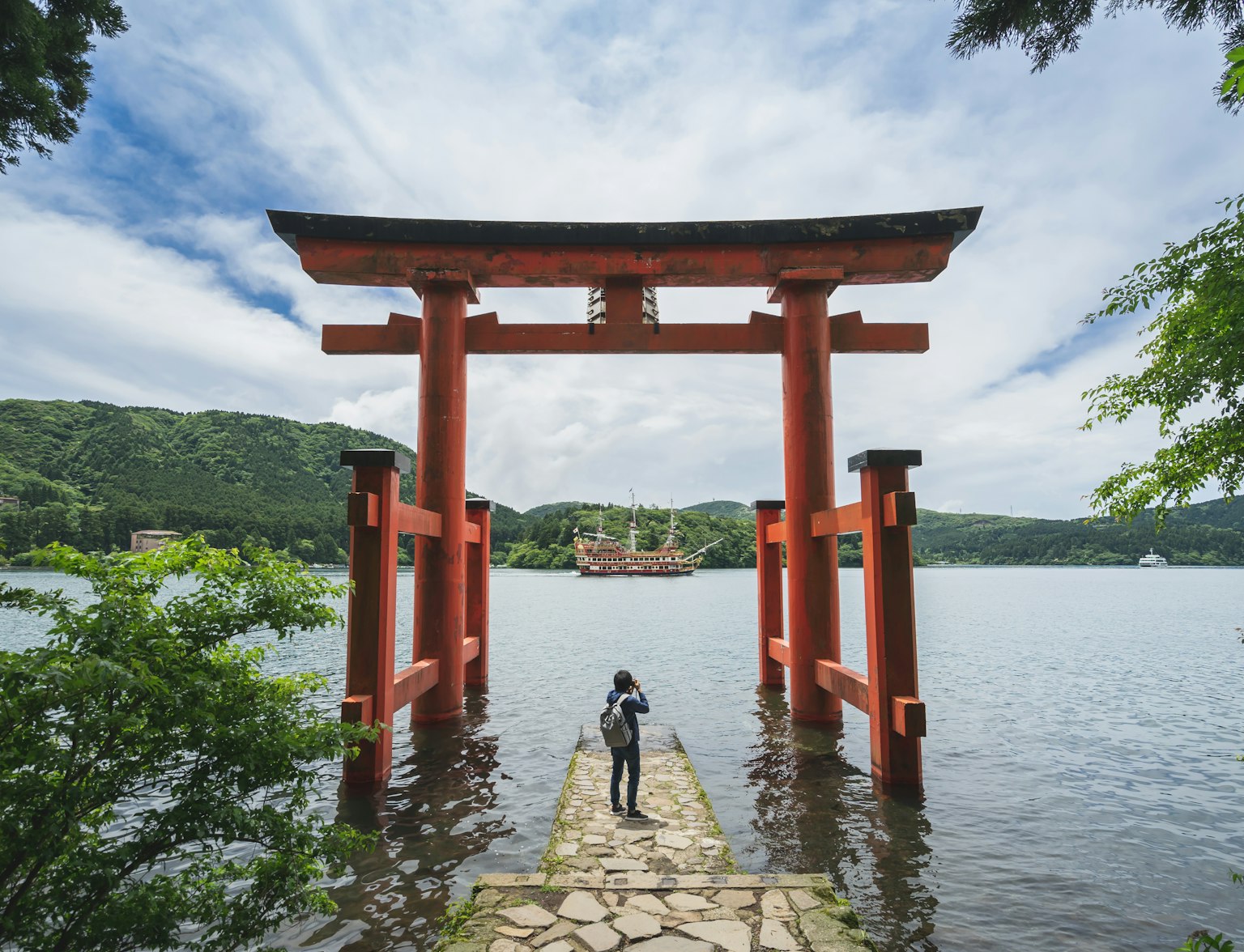
Join our private motorcycle tour from Tokyo to Mt. Fuji and Hakone.
In addition to the hot spring baths, Tenzan Onsen also offers a sauna, a restaurant serving traditional Japanese meals, and a coffee lounge where you can relax after your bath. This onsen is ideal for those who want to experience the traditional side of Japan while enjoying the healing properties of natural hot springs.
Address: 208 Yumotochaya, Hakone-machi, Ashigarashimo-gun, Kanagawa
Price: ¥1,300 for adults, ¥650 for children
3. Hakone Kowakien Yunessun
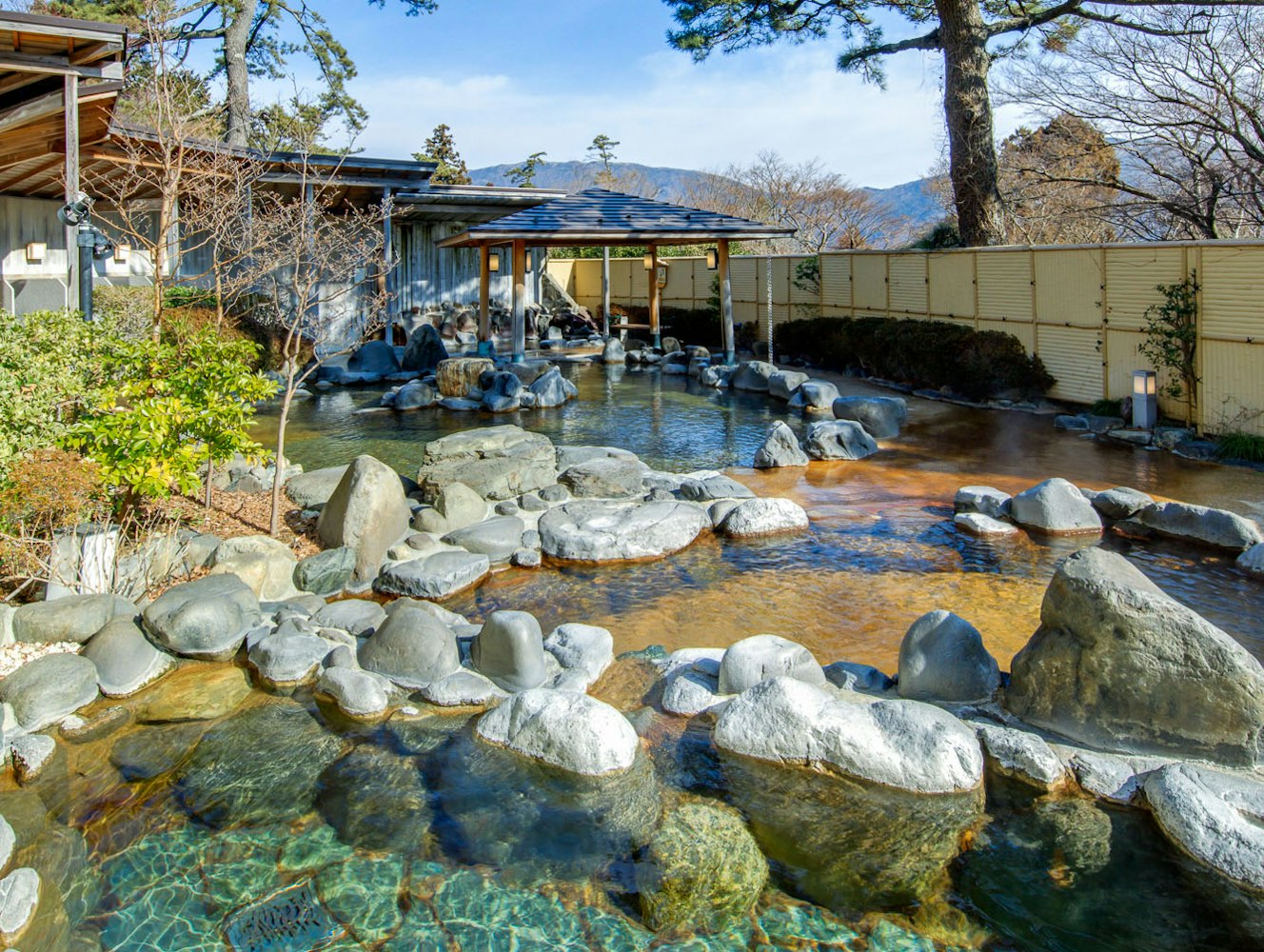
For a more modern and fun hot spring experience, Hakone Kowakien Yunessun is a must-visit. This onsen is part of a larger hot spring resort that combines traditional onsen bathing with a water park-like experience. It’s perfect for families and groups who are looking for something different.
Yunessun offers a variety of themed baths, including a wine bath, coffee bath, and even a green tea bath. These unique baths are not only fun but also provide a relaxing experience. There are also outdoor baths where you can enjoy views of the surrounding mountains.
For those who prefer a more traditional onsen experience, Yunessun has a separate area called “Mori no Yu,” where you can enjoy more typical hot spring baths . With its wide range of bathing options, Hakone Kowakien Yunessun is a great choice for both kids and adults looking for a memorable hot spring experience.
Address: 1297 Ninotaira, Hakone-machi, Ashigarashimo-gun, Kanagawa
Price: ¥2,500 for adults, ¥1,400 for children
4. Yunosato Okada
Located in the Hakone Yumoto area, Yunosato Okada is a hot spring resort that offers a peaceful retreat surrounded by nature. The onsen features both indoor and outdoor baths, with water sourced from the natural hot springs of Hakone . The outdoor baths provide a serene setting where you can soak while enjoying views of the surrounding mountains and forest.
Yunosato Okada also offers private baths for those who prefer a more intimate experience. The onsen is part of a larger resort complex, which includes a hotel, restaurants, and a relaxation area. This makes it a convenient choice for those looking to stay overnight in Hakone.
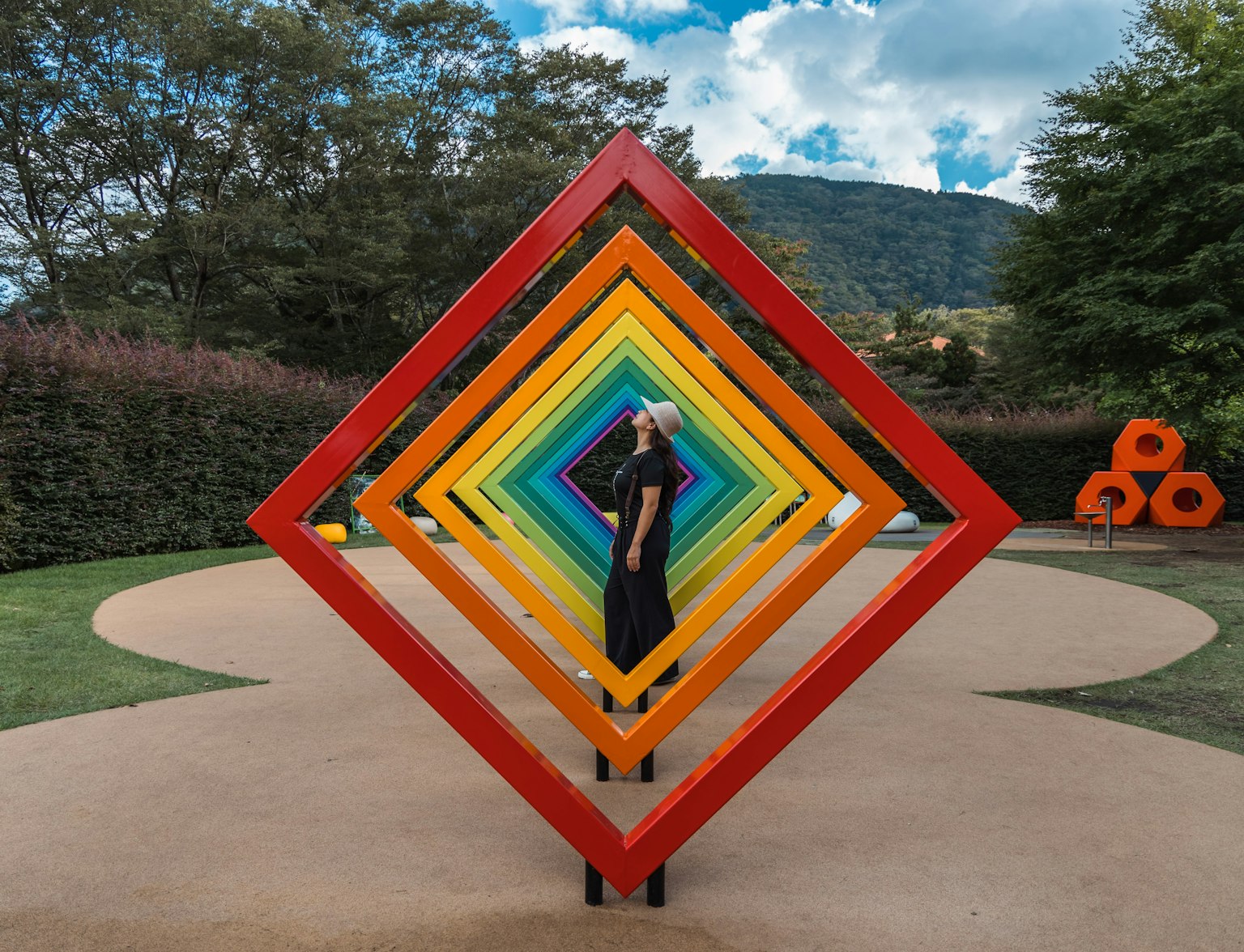
Explore the stunning landscapes of Mt. Fuji and Hakone on a private tour.
The resort is easily accessible from Hakone Yumoto Station, with a shuttle bus service available for guests. With its beautiful setting and excellent facilities, Yunosato Okada is a perfect choice for those looking to unwind and relax in Hakone.
Address: 191 Hakone-machi Yumotochaya, Hakone, Ashigarashimo District, Kanagawa
Price: ¥1,450 for adults, ¥800 for children
5. Hakone Green Plaza Hotel Onsen
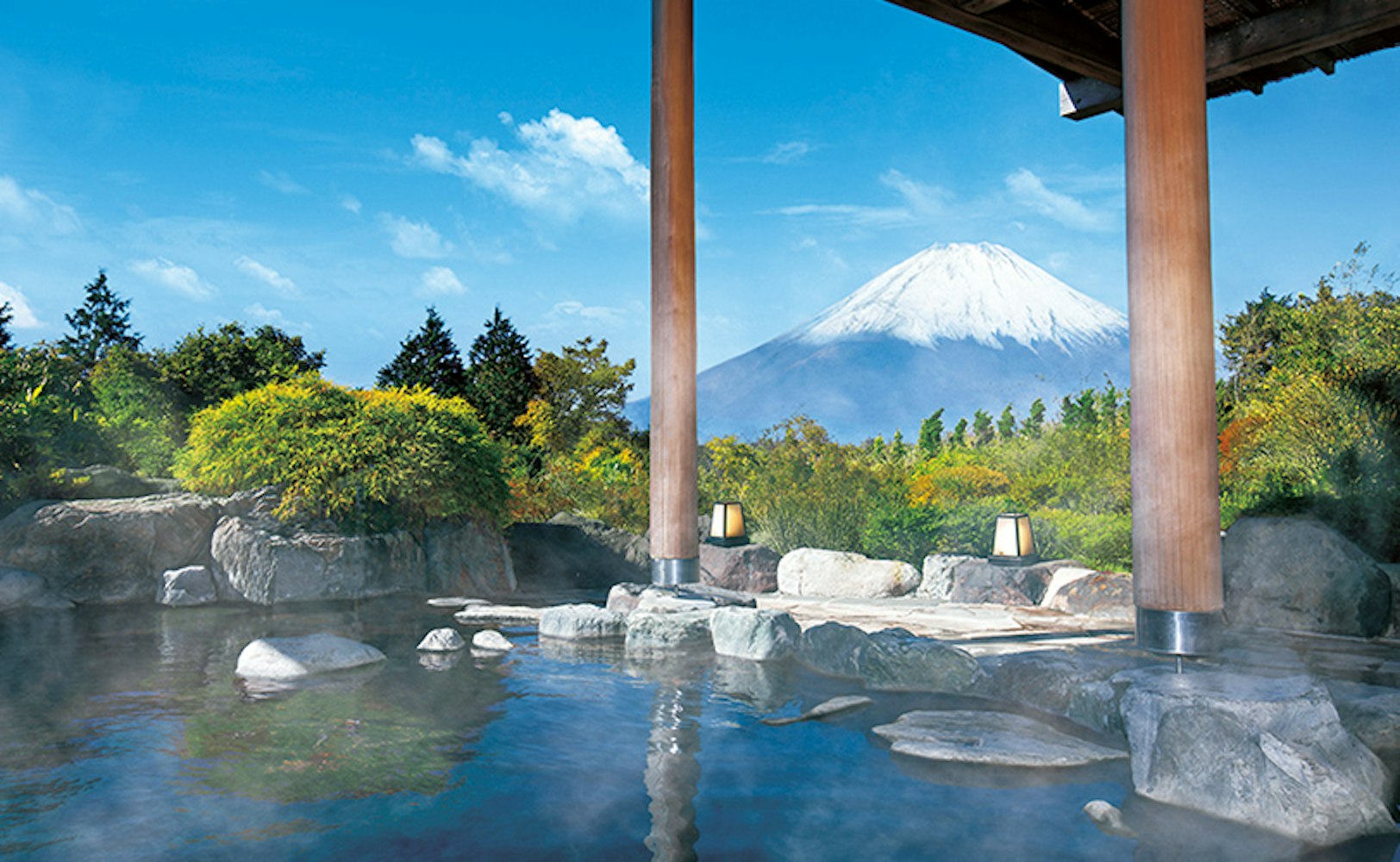
Located in the Sengokuhara area of Hakone, the Hakone Green Plaza Hotel Onsen offers breathtaking views of Mount Fuji from its outdoor baths. This onsen is part of the Hakone Green Plaza Hotel, a popular accommodation option for those visiting Hakone.
The onsen features both indoor and outdoor baths, with water sourced from the natural hot springs of Hakone. The highlight of this onsen is the outdoor bath, which offers stunning views of Mount Fuji, especially on clear days. Soaking in the hot spring while gazing at Japan’s most famous mountain is an experience you won’t want to miss.
In addition to the baths, the Hakone Green Plaza Hotel Onsen also offers a sauna and a relaxation area where you can unwind after your bath. The onsen is open to both hotel guests and day visitors, making it a great option for those looking to enjoy a luxurious hot spring experience in Hakone.
Address: 1244-2 Sengokuhara, Hakone, Ashigarashimo District, Kanagawa
Price: ¥1,600 for adults, ¥800 for children
6. Hakone Suimeisou

Hakone Suimeisou is a traditional Japanese ryokan located near Hakone Yumoto Station. The ryokan offers a variety of hot spring baths, including both indoor and outdoor options. The outdoor baths are set in a beautiful garden, providing a tranquil environment where you can relax and soak in the healing waters.
One of the highlights of Hakone Suimeisou is its private baths, which can be reserved for personal use. These baths are perfect for couples or families who want to enjoy the hot springs in privacy. The ryokan also offers traditional Japanese rooms, complete with tatami mats and futon bedding, for those who want to stay overnight.
Hakone Suimeisou is known for its warm hospitality and excellent service, making it a popular choice for visitors to Hakone. Whether you’re staying overnight or just visiting for the day, this onsen offers a traditional and relaxing hot spring experience.
Address: 70 Hakone-machi Yumoto, Hakone, Ashigarashimo District, Kanagawa
Price: Starting from ¥1,000 for a public bath
7. Fujiya Hotel Onsen
The Fujiya Hotel Onsen is part of the historic Fujiya Hotel, one of the oldest Western-style hotels in Japan. Located in the Miyanoshita area of Hakone, this onsen offers a unique blend of Western and Japanese styles, providing a different hot spring experience.
The onsen features both indoor and outdoor baths, with water sourced from the natural hot springs of Hakone. The outdoor bath is particularly beautiful, set in a traditional Japanese garden with views of the surrounding mountains. The indoor bath is equally charming with its classic Western-style design.
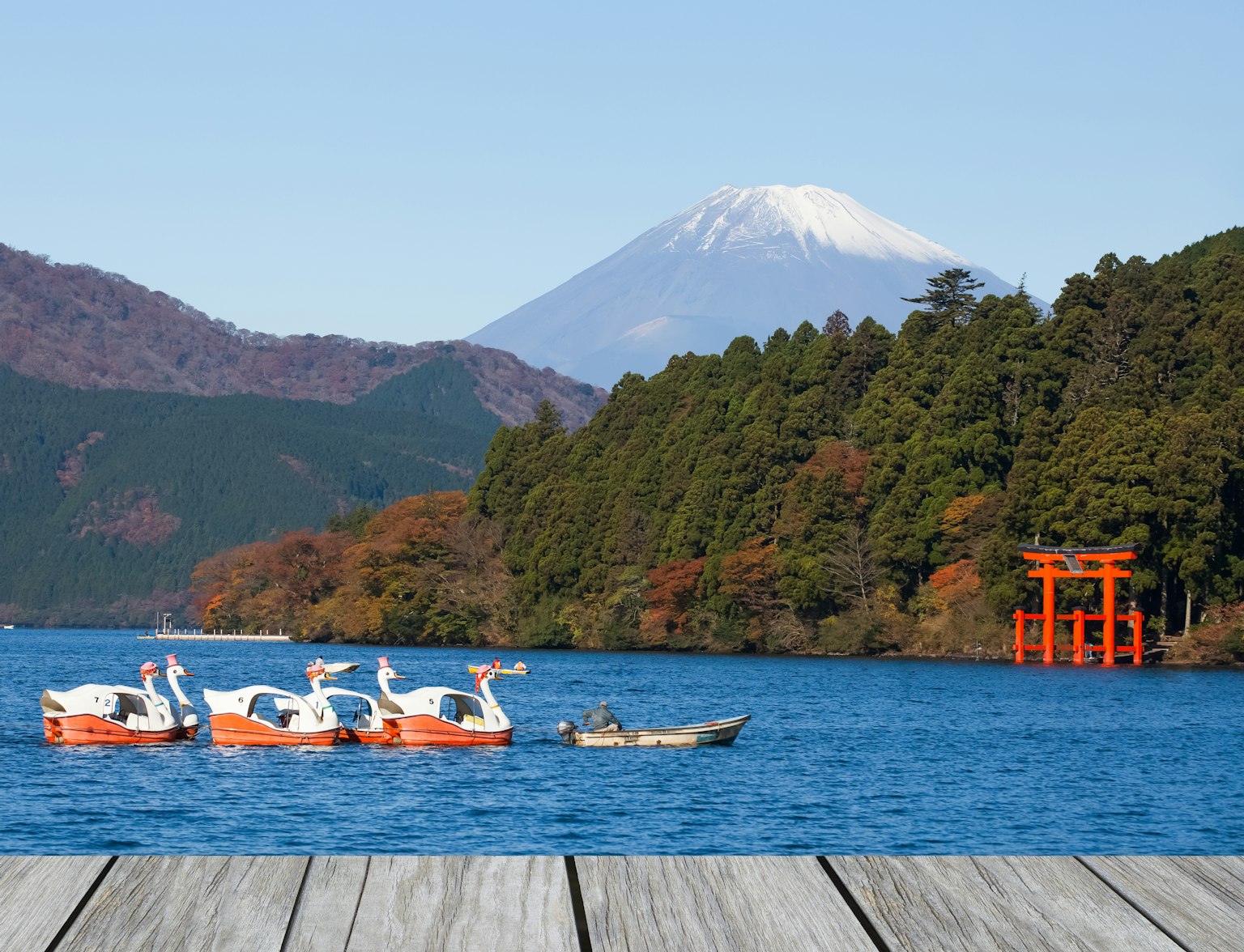
Embark on a private sports car tour to Mt Fuji and Hakone.
In addition to the baths, the Fujiya Hotel Onsen also offers a sauna and a relaxation area where you can unwind after your bath. The onsen is open to both hotel guests and day visitors, making it a great option for those looking to enjoy a unique hot spring experience in Hakone.
Address: 359 Miyanoshita, Hakone-machi, Ashigarashimo-gun, Kanagawa
Price: Starting from ¥2,000 for a public bath
8. Hakone Kamon
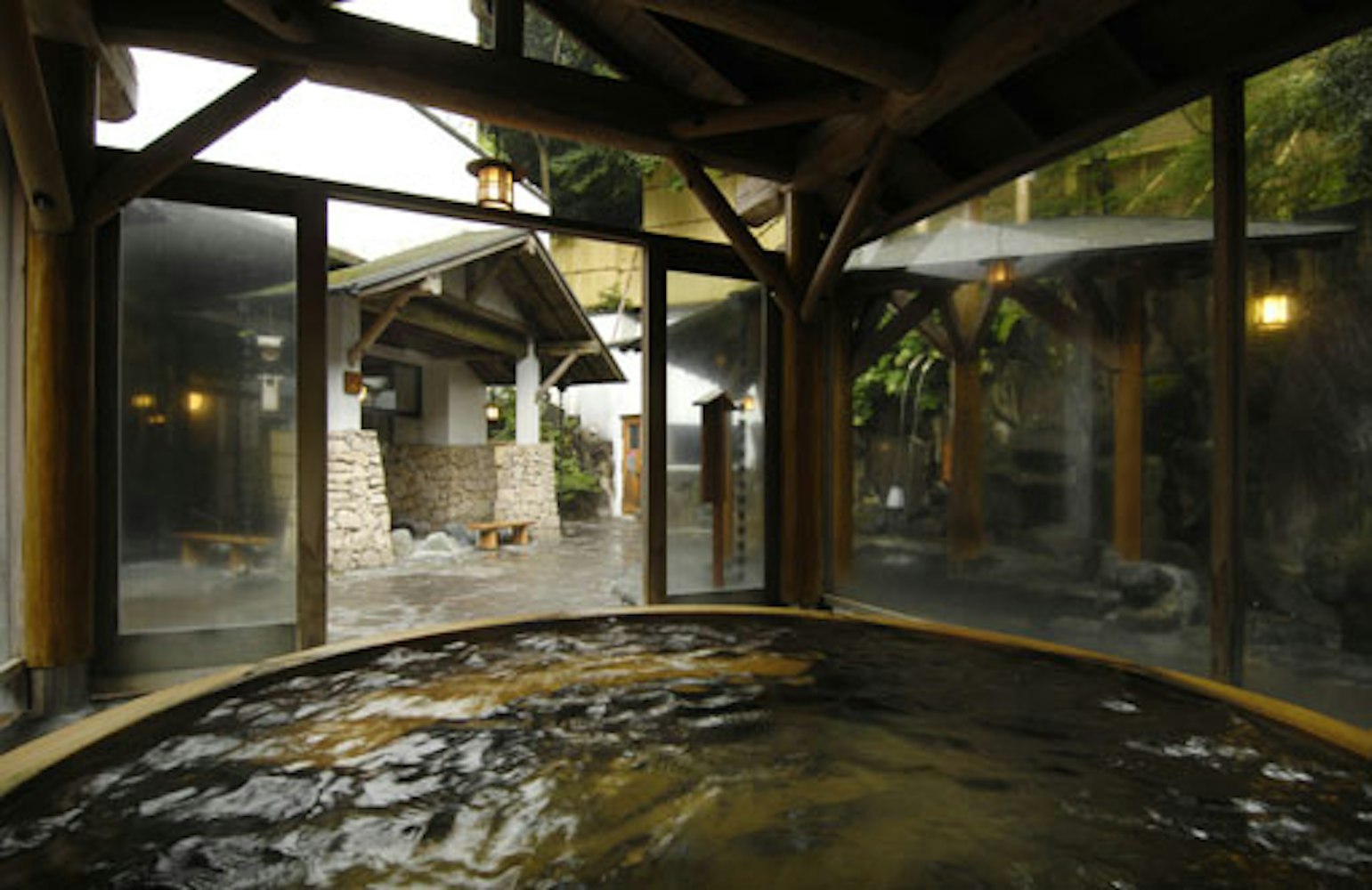
Hakone Kamon is a traditional Japanese ryokan located in the Hakone Yumoto area. The ryokan offers a variety of hot spring baths, including both indoor and outdoor options. The outdoor baths are set in a beautiful garden, providing a peaceful environment where you can relax and soak in the healing waters.
One of the highlights of Hakone Kamon is its “rotenburo,” or open-air baths, which offer stunning views of the surrounding mountains. The ryokan also offers private baths for those who prefer a more intimate experience. In addition to the baths, Hakone Kamon also offers a variety of traditional Japanese meals, including kaiseki (multi-course) dinners, which are a highlight of any stay.
Address: 435 Yumoto, Hakone, Ashigarashimo District, Kanagawa
Price: ¥1,200 for adults, ¥600 for children
9. Hakone Ginyu
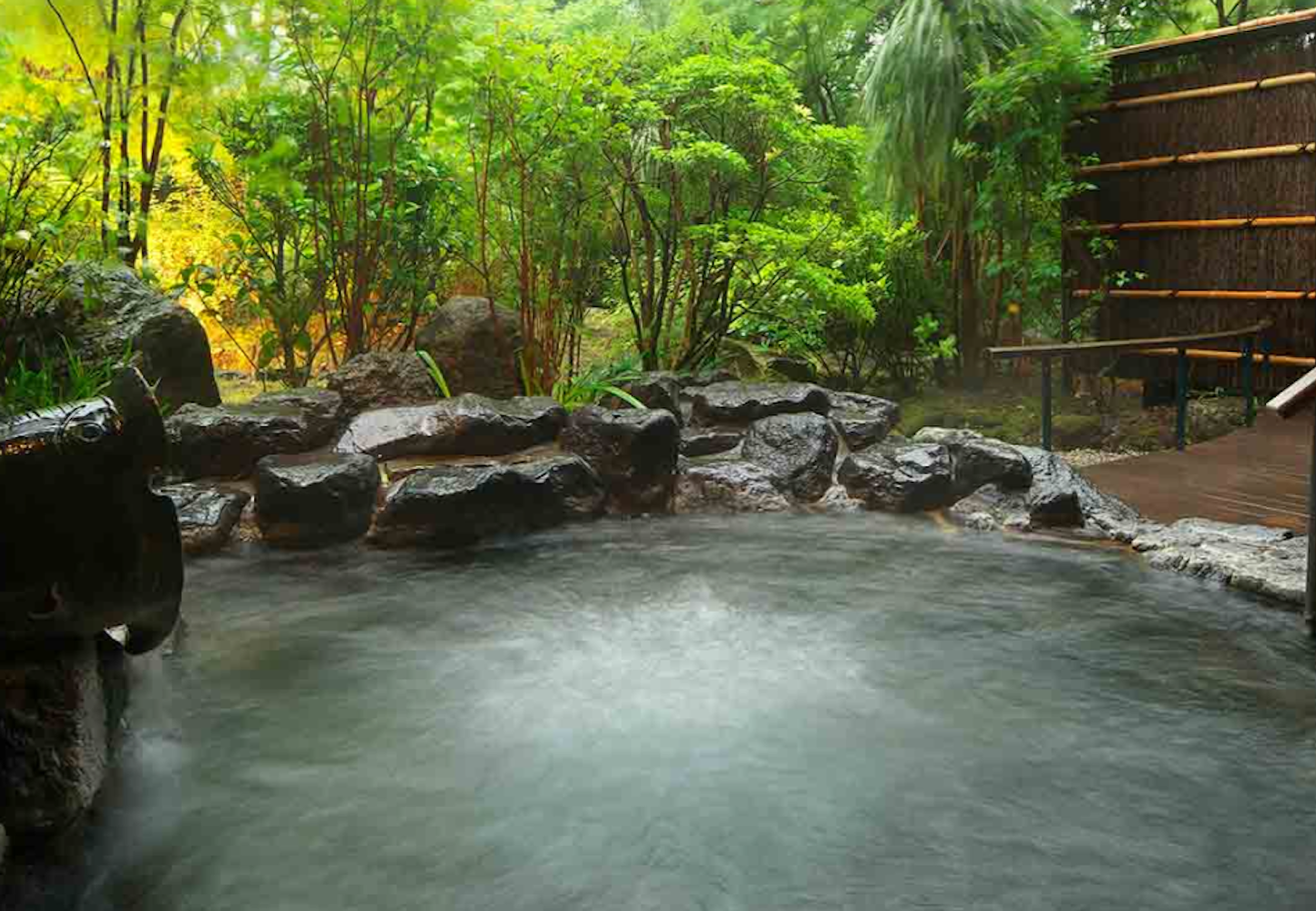
Hakone Ginyu is a luxury ryokan located in the Miyanoshita area of Hakone. This onsen is known for its stunning views and high-end facilities, making it a great choice for those looking for a more luxurious hot spring experience.
The onsen features both indoor and outdoor baths, with water sourced from the natural hot springs of Hakone. The outdoor baths offer breathtaking views of the surrounding mountains and valleys, providing a serene environment where you can relax and unwind.
In addition to the baths, Hakone Ginyu also offers private baths for those who prefer a more intimate experience. The ryokan is also known for its excellent service and attention to detail, making it a popular choice for those looking to indulge in a luxurious hot spring experience in Hakone.
Address: 100-1 Miyanoshita, Hakone, Ashigarashimo District, Kanagawa
Hakone's hot springs are more than just a place to relax—they are a gateway to experiencing the natural beauty and tranquility of the region. With so many unique options to choose from, you can find the perfect onsen to suit your needs, whether you're seeking a quiet escape or a memorable outing. Take the time to explore these top hot springs and discover why Hakone remains a top destination for onsen lovers.
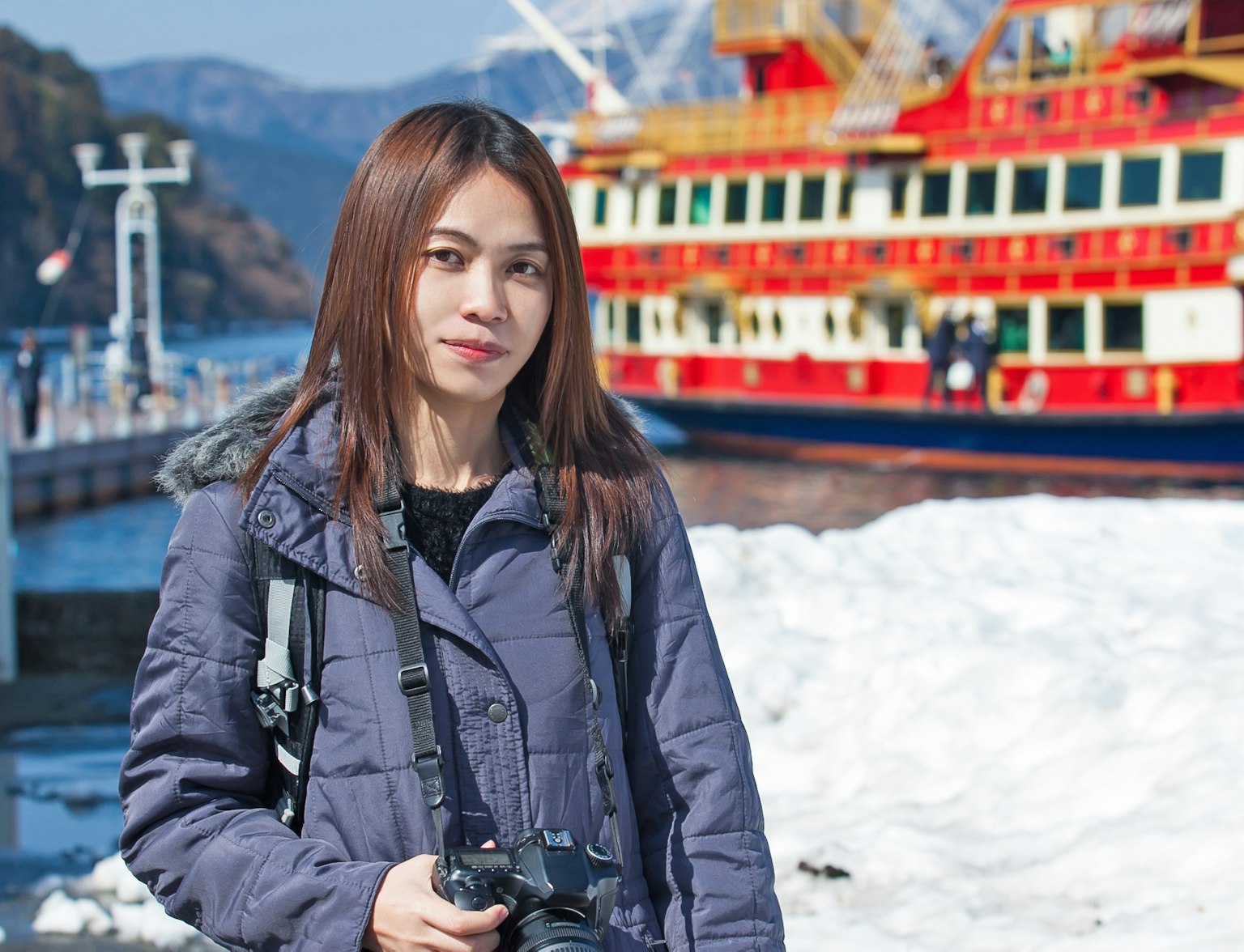
Discover the enchanting beauty of Hakone on a day tour from Tokyo by private car.
Is Hakone good for onsen?
Yes, Hakone is one of Japan's most popular destinations for onsen enthusiasts. The region is rich in natural hot springs, offering a variety of onsen experiences, from traditional ryokan baths to modern hot spring resorts. The scenic beauty of Hakone, combined with its relaxing hot springs, makes it an ideal spot for those seeking to unwind and enjoy the therapeutic benefits of onsen.
How much does it cost to go to the onsen in Hakone?
The cost of visiting an onsen in Hakone can vary depending on the type of facility and the services offered. Generally, entrance fees range from ¥1,000 to ¥3,000 for a public bath. Some high-end resorts and ryokan may charge more, especially for private baths or luxury experiences. It's a good idea to check the specific onsen's website or contact them directly for the most accurate pricing.
How do I get to Hakone Hot Springs?
Hakone is easily accessible from Tokyo by train. The most convenient option is the Odakyu Romancecar, which runs directly from Shinjuku Station to Hakone-Yumoto Station in about 85 minutes. From Hakone-Yumoto Station, many hot springs are within walking distance or a short bus or taxi ride away. Additionally, there are buses and trains within the Hakone area that connect to various onsen locations.
What are the seven onsen of Hakone?
The seven onsen of Hakone, known as "Hakone Nanayu," are the most historic and famous hot springs in the region. They include:
Yumoto Onsen - Known for its accessibility and numerous ryokan.
Tonozawa Onsen - A quieter option near Yumoto.
Miyanoshita Onsen - Home to historic hotels and a scenic atmosphere.
Dogashima Onsen - Known for its unique sulfur springs.
Sokokura Onsen - A peaceful area with a long history.
Kiga Onsen - A small, traditional onsen town.
Ashinoyu Onsen - Famous for its therapeutic waters and mountain views.
Continue reading

- Tours & Experiences
- Tailor-made Trips
- Bahasa Indonesia
We are happy to see you again!
Continue with
Or use email.
No Account? Create one
Create account
Already have an account? Sign in
Quickly Sign up with
I agree to Japan Travel's Terms of Service and Privacy Policy . Terms of--> and acknowledge that Japan Travel's Privacy--> applies to me.-->
Email reset password link
Please check your inbox and click the link we will send to you.
- Accommodation
The Bathhouses of Shibu Onsen
A unique tour of nine hot spring baths

Shibu Onsen is a 1,300 year old traditional onsen town in Nagano. It’s nestled in between the mountains, bracketed between Jigokudani Monkey Park and Yudanaka Onsen. It’s a beautiful area – the town is built up on a slope next to the Yokuyugawa River, and looking across the valley offers stunning views of the Japanese Alps. The town has always been based around the plentiful hot springs, spanning back to the days when samurai would come to recover from battle in the waters, or pilgrims would stop for a dip on their way to Zenkoji in Nagano.
Visiting this little town is truly like taking a step back in time – the roads are narrow and paved with cobblestones. The buildings lining the streets have traditional wooden architecture, and in some cases, are several hundred years old. In the evening, the streets are lit with a soft golden glow from lanterns and the air is filled with the sound of clacking geta. Visitors staying at one of the local inns can wander around the streets in yukata and explore the retro snack shops, inns, and shrines – including the gorgeous Kanaguya inn. Kanaguya is said to be one of the (many) inspirations for the bathhouse in Spirited Away, and is several hundred years old.
The 9 Bathhouses
All the cozy onsen town-charm aside, there’s one main reason to come to Shibu Onsen: to complete a tour of the town’s 9 baths. The town’s streets are dotted with 9 small bathhouses. These baths are referred to as soto-yu (外湯), which means “outside bath.” The baths are actually all indoors, the “outside” in this case means that the baths are not inside one of the inns.
The baths, with the exception of #9 (O-yu) are very small, with only enough room for 2-3 people in each. They come in a variety of styles as well, some are wooden, and some are tiled. All the baths are kake-nagashi style, meaning that the hot spring water constantly flows into the bath and pushes out old water, letting it overflow into the surrounding grates. This constant filling of the bath keeps the water fresh and hot. Very hot. Each bath comes equipped with a cold water tap that you can turn on to try to cool the bath down before entering. Just be sure that you turn the cold water off before leaving the bath.
The hot spring water can be anywhere from milky colored, to clear, to a minerally-rust color depending on the bath. The difference in water is because the area is so rich in hot spring sources, the town can draw from a variety of hot springs with different properties and mineral content. Because of this, each bath is supposed to have a different curative effect.
According to the town’s map, this is what disease each respective bath treats:
- Hatsu-yu: gastrointestinal issues
- Sasa-no-yu: skin conditions
- Wata-no-yu: cuts, injuries to the skin, and other skin conditions
- Take-no-yu: gout
- Matsu-no-yu: nerve pain and spinal issues
- Mearai-no-yu: eye diseases
- Nanakuri-no-yu: injuries and trauma
- Shinmeidaki-no-yu: women’s health and gynecological diseases
- O-yu: joint and nerve issues
Using the Baths
The town has set up an interesting way to use the baths. They’re open from 6AM - 10PM, but are locked at all times. The baths can only be accessed by locals (who each have their own key) or by overnight guests. Only the largest bath, O-yu, is open for day use. It costs ¥500, which you can pay at the Ryokan Association office or at the Shibu Onsen parking lot. Once you have a day-use bath ticket, you can go to one of the nearby inns to get someone to unlock the bath for you. The bath is available for day-users from 10AM - 4PM.
If you’re staying overnight, a bathhouse key will be given to you when you check in to your inn for the night. This key will open the doors to all 9 bathhouses. The inn I stayed at also provided guests with “going out baskets” for you to stick your towel, change, and keys in. However, you shouldn’t bring any bathing supplies. Unlike most onsen, you don’t shower before entering the soto-yu. You simply use a bucket to rinse your body before getting in. It’s also important to note that there isn’t any lockers in the changing areas in the bathhouses, so use your own discretion when it comes to carrying around money or valuables.
An important component to touring the 9 baths is filling out a tenugui towel with bathhouse stamps. Before you head out of your inn to start relaxing in the baths, you can stop by the front desk to pick up one these towels for¥350. Outside each bath, there is a stamp to add to your towel. I actually made the mistake of putting the wrong stamp under the wrong bath name, so make sure to double check before stamping!
Apparently, if you get all 9 stamps from the bathhouses, and a final one from Takayakushi Shrine, you will receive blessings for good health and long life. Whether it’s true or not, you’ll still get to take home a unique souvenir filled with fun memories of enjoying Shibu Onsen’s baths.
Getting there
From Nagano Station, visitors can ride the Nagano Dentetsu line to Yudanaka Station. From there, take one of the buses on the Snow Monkey Park route and get off at Shibu Onsen Station.
Car drivers can use the Joetsu/Hokuriku Expressway to access Shibu Onsen.
- Share on Facebook
- Share on X (Twitter)
- Copy link to share
By Linka Wade
Community writer

Information
2112-1 Hirao, 下高井郡山ノ内町 Shimotakai District, Nagano 381-0401 ( Directions )
+81269332921
shibuonsen.net
Book your trip
Find a nearby hotel, explore nearby.

Shibu Onsen Day Trip
By Nathan Eden

Staying at Ryokan Biyu no Yado
By Adeline Ong

Yudanaka Shibu Onsen
By Elena Lisina

Hotel Housei in Yudanaka
By Peter Sidell
Top Articles
- Recommended

Fūrin, the Symbol of Japanese Summer

A Foot Bath Path In Kaminoyama

APARTMENT HOTEL MIMARU

Discover Kanazawa: A Golden Journey

Culture and Beauty In Ishikawa Prefecture

Princess Adachi Festival

Fairytale Experiences at Nukumori-no-mori

Sakura-tei: The World's Largest Okonomiyaki Restaurant

Post-quake Support for Noto

Guided Tour for Foreign Visitors to Experience Traditional Japanese Performing Arts and Learn About the History of Ginza!

Guide to Bringing Medicines Into Japan

A Guide to Japanese Visas

Your Name: Real-Life Locations in Tokyo

The Ultimate Guide to Thrifting in Tokyo

Daikoku Car Meet

Hachiko Statue in Shibuya

Japanese Urban Legends

Tokyo Auto Salon

September Grand Sumo Tournament (Tokyo)

Iwatayama Monkey Park
More from this category.

Guide to Japan's Love Hotels
By JJ Nakao

Top 10 Traditional Stays in Rural..
By Veronica Carnevale

Pokémon Sleep Comes to Grand..
By Tom Roseveare

Sekizenkan Ryokan
By Aline Laborde
Join the discussion

Let us know how we can help.
Help us improve JapanTravel.com
We welcome any suggestions regarding this content. Your feedback is confidential and will be used to help improve this page.
Suggest an edit
https://en.japantravel.com/nagano/the-bathhouses-of-shibu-onsen/66253
Thank you for your support!
Your feedback has been sent.

Ginzan Onsen
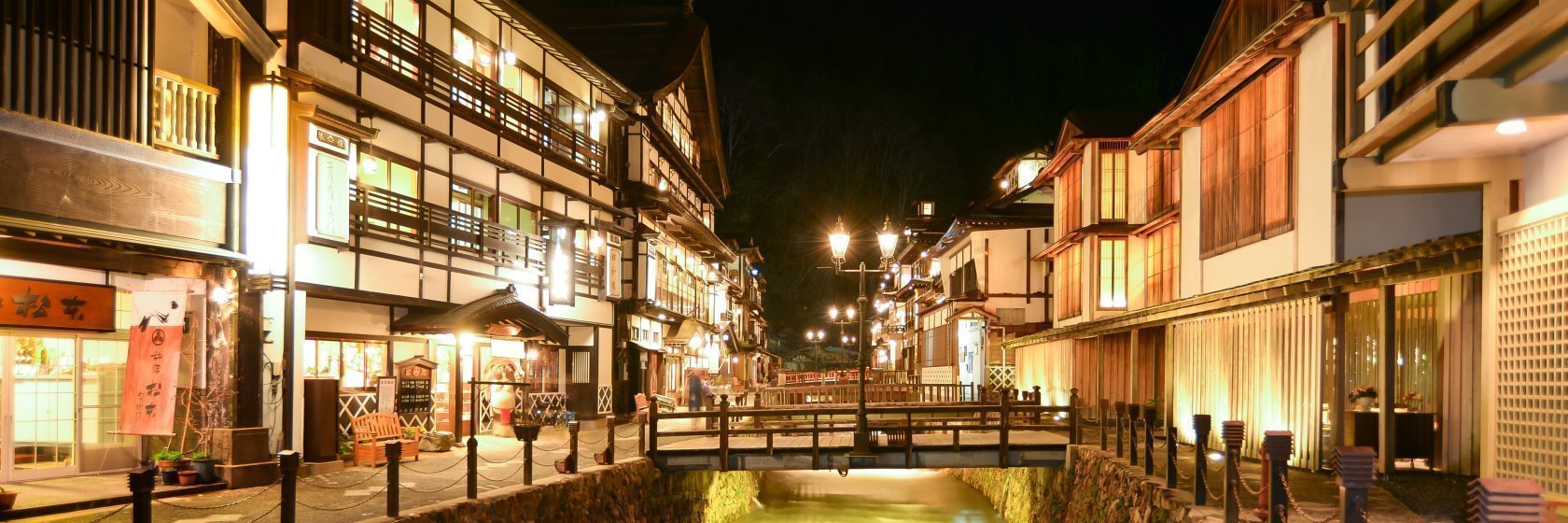
Ginzan Onsen (��R����, lit. "Silver Mountain Hot Spring") is a secluded hot spring town nestled in the mountains of Yamagata Prefecture . The area originally developed around a silver mine; however, these days it is better known as one of Japan's prettiest onsen towns with historic ryokan lined up along the river.
Ginzan Onsen's traditionally styled ryokan occupy beautiful three and four story wooden buildings that, with their exposed woodwork and white plaster walls, evoke nostalgic feelings of a bygone era. There is one exception, however, in the Fujiya ryokan at the center of town, which was recently rebuilt by famous modern architect Kuma Kengo. Although purists may find it out of place, its unique modern design incorporates many of the traditional design elements of the surrounding buildings, such as the same exposed wood and white plaster.
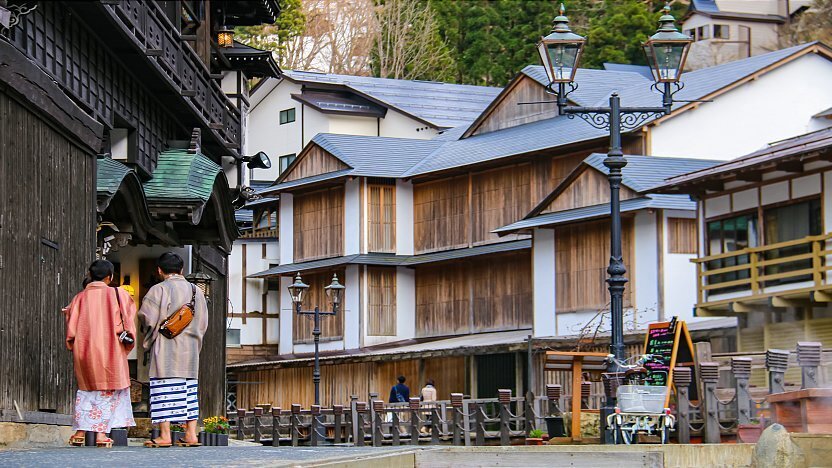
The town center of Ginzan Onsen is a pedestrian-only zone due to the narrow streets and lack of parking. It is particularly nice in the evenings when the ryokan are all lit up and the streets and bridges are illuminated by gas lights. In winter, the scenery is enhanced by heavy snow that clings to the rooftops and walkways, while during the warmer months the ryokan guests are more likely to be out strolling about town in their yukata .
Two public baths (500 yen each) and a foot bath (free of charge) can be found around the town center. One of the public baths, the Shiroganeyu, was also designed by Kuma Kengo. Further available is the Omokageyu, a public bath for private use (2000 yen per 50 minutes). In addition, many of the town's ryokan open their baths to non-staying guests during daytime for typically 500 to 1500 yen. Most feature historic indoor baths.
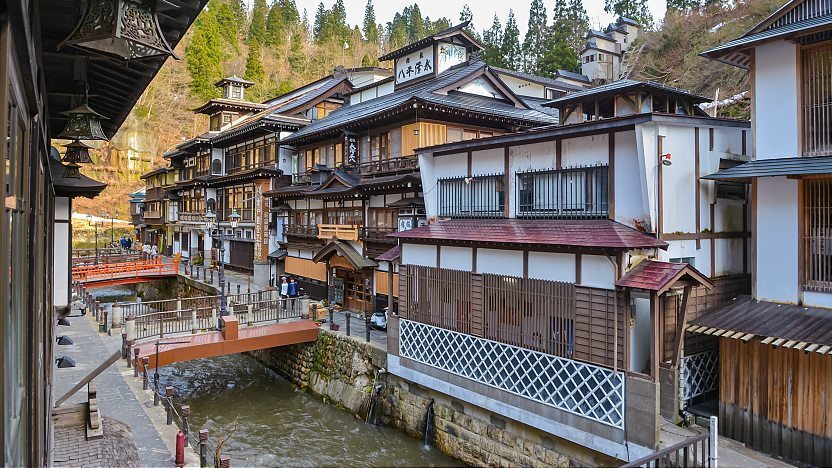
A spectacular, 22 meter tall waterfall rushes constantly at the back of the town. Not far from its base is one of the entrances to the historic silver mine that was built here over 500 years ago and served as the town's lifeblood during the early Edo Period . Visitors can enter the lit-up tunnel, although they cannot go very far in as it is only accessible for about twenty meters.
Tourists can see a little bit more of the mines by following a nature trail up into the valley for about 10-15 minutes past the waterfall. There, they will find a slightly longer section of the former mine for people to enter. Note, however, that the nature trail is not passable in winter and early spring due to snow.
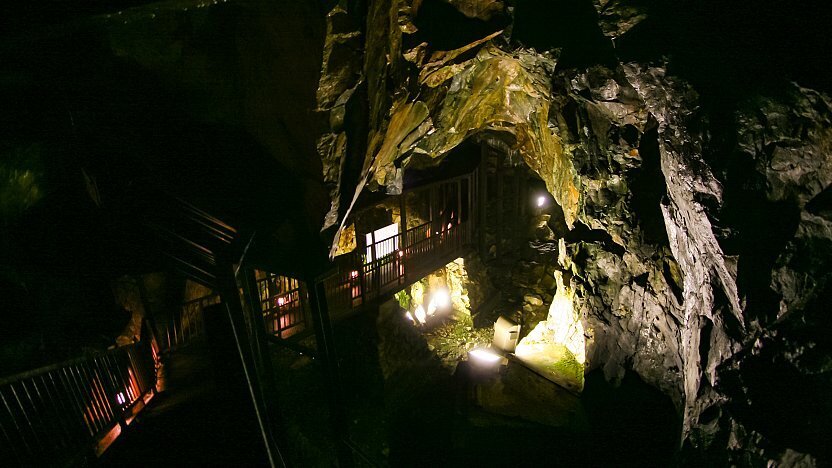
Getting there and around
Take the JR Yamagata Shinkansen from Tokyo to Oishida Station (about 200 minutes, around 12,500 yen one way), from where buses depart roughly every two hours for Ginzan Onsen (35 minutes, 720 yen one way). The train portion of the journey is fully covered by the Japan Rail Pass , JR East Tohoku Area Pass and JR East South Hokkaido Pass , but the bus ride is not.
A rental car can be convenient for exploring the area. Rental car outlets are available at stations along the Yamagata Shinkansen such as Murayama, Shinjo and Yamagata stations, as well as at Yamagata Airport. Parking is available at parking lots a 5-10 minute walk outside the town center. Many ryokan will pick up their guests from the parking lot.
There are two bus round trips per day between Yamagata Airport and Ginzan Onsen (75 minutes, 1500 yen one way) that require no prior reservations.
Questions? Ask in our forum .
Links and Resources
Hanagasa bus, yamagata airport bus.

- Attraktionen
- Deutschland
- Urlaubsangebote
- Hotels & Ferienwohnungen
- Weltspeisen
- Reisewetter
- TRAVELBOOK AWARD
TRAVELBOOK-Autorin: »So war meine Onsen-Erfahrung in Japan
10. September 2024, 13:45 Uhr | Lesezeit: 9 Minuten
„Onsen“ – so heißen die weltberühmten heißen Quellen in Japan . Im Onsen baden zu gehen gehört zu den japanischsten Erfahrungen, die man auf einer Reise ins Land der aufgehenden Sonne machen kann. Unsere Autorin wollte sich bei ihrem ersten Japan-Besuch ins heiße Wasser wagen. Das gestaltete sich zunächst schwieriger als geplant.
Baden gehört für mich zu den schönsten Dingen der Welt. Ob Badewanne oder See: Ich liebe Wasser! Und so war es für mich völlig klar, dass ich bei meiner ersten Japanreise auch in ein Onsen gehen werde. Noch zuhause versuchte ich, mir ein besonders schönes Badehaus auszusuchen, irgendwo in den Bergen vielleicht? Beim Surfen durch die Onsen-Websites stellte ich jedoch erschrocken fest: Vielleicht darf ich da gar nicht rein?
Tattoos sind im Onsen Tabu
Mehrere Onsen-Websites wiesen freundlich, aber bestimmt darauf hin, dass eines im Badehaus ganz klar nicht erwünscht ist: Tätowierungen. Ups! Ich habe vier kleine Tätowierungen, nichts Auffälliges oder Anstößiges, aber egal, denn tätowiert ist tätowiert. Damit hatte ich nicht gerechnet, kommt doch die Popularität der aufwändigen farbigen Tätowierungen – auf einigen Umwegen – aus Japan ! Warum also das Tattoo-Verbot? „In Japan werden vor allem großflächige Tätowierungen mit den Schlägertypen der Yakuza assoziiert“, klärte mich die Website des Japanischen Tourismusverbands auf. Die Yakuza? Die japanische Mafia? Die Gangmitglieder seien laut der Website daran zu erkennen, dass sie am ganzen Körper tätowiert sind. Und wenn ich mit meiner kleinen Lotusblüte am Handgelenk in das Onsen gehe, soll man mich mit einem japanischen Mafia-Boss verwechseln? Das hielt ich erstmal für unwahrscheinlich. Und sicher würde es auch Ausnahmen für Touristen geben. Oder?
Trotz Tattoo ins Onsen?
Aber meine weiteren Recherchen fielen eher entmutigend aus. Im Tenzan no Yo-Onsen in Kyoto stand beispielsweise auf der Website ganz klar: Egal welche Größe oder Farbe, keine Tattoos. Basta. War meine Onsen-Erfahrung also beendet, bevor sie begonnen hatte? Glücklicherweise bin ich nicht die einzige Bade-Freudige, die in Japan vor diesem Problem stand. Und so fand ich doch noch zwei Hoffnungsschimmer. Zum einen gäbe es die Möglichkeit, die Tätowierungen abzukleben, z. B. mit einem hautfarbenen Kinesio-Tape . Zum anderen fand ich Websites mit Listen von „tattoo-friendly Onsen“, also Badehäusern, bei denen man auch mit Tätowierung reindurfte. Badespaß, ich komme! Ich besorgte mir eine Rolle Kinesio-Tape und fühlte mich für meine Onsen-Experience gewappnet.
Was ist eigentlich ein Onsen?
Die geografische Lage Japans auf einem vulkanischen Archipel hat dem Land Tausende von heißen Quellen beschert, und es ist seit hunderten von Jahren in Japan Tradition, in diesen Quellen zu baden. Das Wort Onsen meint sowohl die heißen Quellen selbst als auch die Hotels, Resorts und Services, die rund um diese mineralhaltigen, vulkanischen Quellen entstanden sind. Die Wasserzusammensetzung in den verschiedenen Onsen variiert ebenfalls – schließlich handelt es sich um Wasser, das aus der Erde sprudelt. Onsen-Wasser kann reich an Kalzium, Natrium, Magnesium oder Schwefel sein. Um als Onsen bezeichnet zu werden, muss mindestens eines dieser Mineralien vorhanden sein, und das Wasser muss mit einer Mindesttemperatur von 25 Grad Celsius aus dem Boden kommen. Nicht verwunderlich also, dass die Badehäuser oft in wunderschönen Gegenden angesiedelt sind: Mitten in den Bergen, an Flussläufen, auf Waldlichtungen, in aufwändig angelegten Gärten oder mitten im Schnee. Ich hatte mir für meine Onsen-Experience die Bergregion um Kamikochi in den „japanischen Alpen“ ausgesucht – Wandern und Baden, herrlich!
Wundermittel Onsen – kuriose Heilsversprechen
Als ich ermattet von der Wanderung in Kamikochi abends auf mein Sofa sank, begann ich, die Details der näheren Onsen zu studieren. Mit dem „ Hirayu no Mori“ Onsen lockte ein Tattoo-tolerantes Badehaus, mitten im Bergwald: Milchiges, leicht schwefelhaltiges Wasser, 16 verschiedene Becken. Wie alle Mineralbäder pries auch das „Hirayu no Mori“ Bad an, welche gesundheitlichen Wunder die mineralischen Quellen vollbringen können: bessere Blutzirkulation, Tiefenreinigung der Haut, Blutdruckverbesserung und natürlich allgemeine Entspannung. Onsen-Fans (und -Besitzer) sind dafür bekannt, dass sie die ausgeflipptesten Behauptungen über ihr Wasser aufstellen – in einem Werbeprospekt las ich über die Linderung von vierzigtausend Beschwerden. Ich halte das weitgehend für Hokuspokus – außer die Sache mit der Entspannung. Baden entspannt mich wunderbar! Also war der Plan geschmiedet: Morgen früh ab ins „Hirayu no Mori“ Onsen.
Bin ich bereit für die Onsen-Experience?
Das Onsen öffnete um 10 Uhr. Also machte ich mich früh morgens fertig und packte – ja, was eigentlich? Was braucht man im Onsen? Genau genommen: Nichts. Denn man badet splitterfasernackt. Schon meine Reiseführer hatten mahnend angemerkt: Wer im Onsen mit Badeklamotten auftaucht, wird Probleme bekommen. Im Onsen baden Männer und Frauen in der Regel getrennt. Und: nackt. Also kein Bikini, keine Schlappen, aber ein Handtuch, vielleicht? Und wenn ja – welches? Groß, klein, beides? Ich beschloss, gar nichts mitzunehmen, denn mein Onsen versprach auf der Website, dass man sich alles Notwendige auch vor Ort mieten könne. Also düste ich los zum Badehaus und spürte nun doch, dass ich richtig nervös war – dabei hatte ich mich so auf das Baden in Japan gefreut. Ich saß noch ein paar Minuten im Auto auf dem Parkplatz und starrte auf das schmucke Holzhaus, dann fasste ich mir ein Herz und ging zur Tür.

Ich war erst mal richtig nervös!
Während ich noch etwas verlegen im Foyer von einem Fuß auf den anderen trat und versuchte, dem Ticket- (und Handtuch-) Automaten die richtigen Zettel zu entlocken, passierten mich bereits die ersten Badegäste. Sie grüßten freundlich, zeigten am Empfang ihre Dauerkarten vor und entschwanden sicheren Schrittes in die Baderäume. Ich hatte endlich meine drei Zettel (einmal Eintritt, ein großes und ein kleines Handtuch, für alle Fälle), bekam meine Handtücher und schlich etwas unsicher Richtung Umkleidekabinen. Am Eingang: Erst mal Anweisungen, das japanische Äquivalent zu unseren Baderegeln. Vor dem Baden ordentlich waschen, Haare hochbinden und beim Baden leise sein. Das Onsen ist kein Spaßbad, tobende Kinder und feiernde Gruppen gibt es nicht. Ich zupfte meinen Haargummi vom Handgelenk und öffnete die Tür zum Damen-Umkleideraum.
Vor dem Betreten des Onsen sollte man sich waschen
Aufatmen – der Umkleideraum war erst mal genau das, was ich erwartet hatte: ein normaler Umkleideraum. Ich packte meine Klamotten in ein Körbchen, schloss sie in einen Spind und ging wie Gott mich schuf (plus zwei Handtücher) in den Waschbereich. An den Waschtischen saßen bereits zwei Frauen und hatten mit der obligatorischen Waschprozedur begonnen. Darüber hatte ich schon einiges gelesen, dennoch setzte ich mich so hin, dass ich spicken konnte, wie die „Profis“ das tatsächlich machen: Man nimmt auf einem kleinen Hocker am langen Waschtisch Platz, bedient sich am bereitgestellten Duschgel und Shampoo und wäscht sich mithilfe einer Duschbrause oder eines kleinen Eimerchens. Und zwar überall. Vom Kopf bis zu den Zehen. Nach zehn Minuten Schrubben dachte ich eigentlich, ich wäre schon sehr sauber, aber die beiden Damen, die vor mir gekommen waren, schäumten immer noch. Also schäumte ich auch weiter.

Wohin mit dem Handtuch?
Nach weiteren fünf Minuten standen die beiden Damen neben mir auf, duschten sich die Seife vom Körper und begaben sich zum ersten Becken, das noch im Innenbereich des Waschraums angelegt war. Ich versuchte, aus den Augenwinkeln zu erspähen, was jetzt eigentlich mit den beiden Handtüchern geschehen sollte, die ich mitgebracht hatte. Da verstand ich: Das große Handtuch hätte ich eigentlich im Umkleideraum lassen sollen, die beiden „Profis“ hatten nämlich nur das kleine dabei. Das wurde jetzt vor Betreten des Wassers dreimal gefaltet und mit einer eleganten, beiläufigen Geste auf dem Kopf platziert. Faszinierend! Dann ließen sie sich ins heiße Wasser sinken, das Handtuch ruhte reglos auf ihren Köpfen. Hintergrund des Balanceaktes ist, dass im Onsen nichts außer der Haut das Wasser berühren soll. Kein Handtuch, kein Haarschopf. Ich schlich zurück in die Umkleide und ließ mein großes Badetuch zurück. Dann faltete ich mein kleines Tuch, fummelte es etwas ungelenk auf meinem Kopf zurecht und endlich ging es rein ins warme Wasser. Herrlich!
Langsam setzt die Entspannung ein
Nach dem ersten Becken im Waschraum wagte ich mich in den Außenbereich. Umsäumt von japanischen Ahornbäumen, Kiefern und Thujen lagen neun Badebecken im Garten, jedes mit einer anderen Wassertemperatur. Der Dampf des heißen Wassers durchzog die Luft und waberte durch die Äste. Auf den Holzwegen und Steinpfaden schlenderten meine Mitbadenden langsamen Schrittes von Becken zu Becken. Hier und da unterhielten sich zwei Onsen-Besucher flüsternd, im Wasser sitzend oder an die warmen Steine gelehnt. Andere wiederum schienen beim Waten durch die niedrigeren Becken im Gehen zu meditieren. Immer wieder ließ der Sommerwind die Blätter der Bäume sanft rascheln und die Sonne blitzte über die Gipfel. Eine Oase der Ruhe und Entspannung. Als ich langsam von Becken zu Becken wanderte, merkte ich, wie Anspannung und Nervosität von mir abfielen. Im warmen Wasser sitzend zupfte ich sanft mein Handtuch auf dem Kopf zurecht, lauschte dem Vogelgezwitscher und fand auf einmal alles, was über die Wunderwirkungen des Onsen-Badens behauptet worden war, absolut plausibel: Hier fehlt einem nichts. Ich hatte das Becken mit der für mich perfekten Temperatur gefunden, die Sonne glitzerte durch die Äste und ich fühlte mich, als würde ich fast selbst zu Wasser werden.
Ich tauche langsam wieder auf
Es gab keine Uhr im Badebereich des Onsen, deswegen ist es schwer zu sagen, wie lange ich tatsächlich baden war. Irgendwann führten mich meine Schritte zurück in den Waschraum und in die Umkleide. Noch etwas im Trance der Entspannung wandte ich mich Richtung Ausgang und entdeckte den Ruheraum, mit klassischen japanischen Tatami-Matten ausgelegt. Wie eine Handvoll anderer Besucher legte ich mich auf den Boden, schloss die Augen und dämmerte noch ein paar Minuten weg, bevor mich der Hunger weckte. Viele Badehäuser verfügen über eigene Restaurants, die erstklassige regionale Küche servieren. Der perfekte Abschluss.

Erster „Spamusement“-Park der Welt Hier kann man bald in einem Whirlpool Achterbahn fahren

Verrückter Wellnesstempel in Japan Hier kann man in Rotwein baden (mit Alkohol!)

Nishiyama Onsen Keiunkan in Japan Seit 705 n. Chr. geöffnet! Das älteste Hotel der Welt
Meine onsen-erfahrung: unvergesslich.
Wie das Teetrinken haben die Menschen in Japan auch das Baden zur Kunst erhoben. Beim Besuch in Onsen erlebt man nicht nur ein japanisches Ritual, sondern hat die Chance, für ein paar Augenblicke das Alltagsgefühl der Menschen dort nachzuempfinden. Auch wenn ich anfangs furchtbar nervös war, ich könnte etwas falsch machen oder andere mit meiner Ahnungslosigkeit stören – diese Angst war völlig unbegründet. Ich denke, solange man sich an die ungeschriebenen Gesetze des Zusammenlebens in Japan hält – bitte sei respektvoll, leise und sauber – kann man in einem Onsen kaum etwas falsch machen. Selbst wenn man das mit dem Handtuch-Balancieren noch nicht so perfekt beherrscht.
Hrmm. Looks like you're using an older browser, which means some site features may not work they way they should. For the full gadventures.com experience, we recommend upgrading to the most recent version of your browser . It's worth it! Honest!
View all tours
North America
Central america & caribbean, south america, north africa & middle east.
Few travellers make it to this icy continent, but the lucky ones who do get to explore a frozen Eden ruled by the elements and teeming with wildlife.
G Adventures Land
G adventures sailing & cruises, g adventures private travel.
Whether it’s a family retreat or a girls trip, you can surround yourself with a hand-picked crew and customize a tour that fits you all perfectly.
The Geluxe Collection
Our new line of premium active adventures is officially here. With perfectly paced itineraries, one-of-a-kind accommodations and elevated dining, this is adventure at its finest.
National Geographic Journeys
Go deeper into the cultures and habitats of the places we explore. More is included and you’ll enjoy greater hands-on exploration, interactions with local experts, and freedom to roam.
National Geographic Family Journeys
Are you an adventure-loving family in search of meaningful ways to discover the world together? These tours are specially designed for travellers seven and up and their inquisitive families.
Jane Goodall Collection
Step deeper into the animal kingdom while respecting all of its inhabitants. Our incredible collection of wildlife-focused tours is endorsed by the world-renowned ethologist.
Roamies by Hostelworld
The thrill of adventure. The awesomeness of hostels. Get ‘em both on these immersive small group trips for 18 to 35-year-old travellers.
Why choose us
As the leader in small group travel for 30 years, we know how to do it right: flexible itineraries, freedom to roam, safety, peace of mind, and locally based guides.
Change the world just by having the time of your life. When you travel with us, you become a force for good by acting responsibly and creating positive impact.
Together with our non-profit partner, Planeterra, we ensure local communities touched by our tours benefit from our visits in as many ways possible.
Trees for Days
Leave your destination even greener than you found it! For every day on tour, we’ll plant a tree in your honour and ensure that our forests get to live their best lives.
Travel resources
Last minute deals.
Looking to have the time of your life in the next 90 days or so? You can save big if you’re ready to book now.
Loyalty discount
Back home from a G Adventures tour? Submit a quick trip evaluation to save 5% on your next tour with us.
Student discount
Got proof that you’re pursuing higher learning? Then we’ve got a travel voucher with your name on it.
All travel deals
New ways to save pop up all the time. Here’s where you’ll find every hot deal in one easy place.
Active Northern Japan: Tokyo & Hokkaido
11 days, tokyo to sapporo.

- Full itinerary
- Tour details
Tokyo’s sleek, buzzing vibe is unmatched, and you could easily get lost in its magic for weeks. But why stop there? This 10-day adventure kicks off with the best of Tokyo before taking you far off the beaten path to Hokkaido. Lace up your boots for epic hikes through Shiretoko National Park, and dive deep into the culture of Japan’s Indigenous Ainu people. After a week of trekking through breathtaking landscapes, unwind in a traditional Japanese onsen and raise a glass to one unforgettable journey.
Tokyo to Sapporo
Is this tour for me, travel style: active.
Hiking, trekking, biking, rafting, and kayaking adventures all over the world, made for outdoor types.
Service Level: Standard
Comfortable tourist-class accommodations with character; mix of public and private transport.
Physical Rating: 3 - Average
Some tours may include light hiking, biking, rafting, or kayaking in addition to walking.
Trip Type: Small Group
Small group experience; Max 16, avg. 14
Age requirement: 12+
All travellers under age 18 must be accompanied by an adult.
Check Your Visa Requirements
Before booking, use our handy entry requirements tool so you know which documents you need to enter and travel through the countries on your trip.
See how your trip uplifts communities
In a number of impactful ways, your adventure directly benefits the local people and places we visit.
Help us spread love around the world with Trees for Days. Together with Planeterra, we'll plant one tree in your name for every travel day.
Trees planted for this trip: 11

Places visited
Day 1 tokyo.
Welcome to Japan! Arrive at anytime. Then meet your group and CEO this evening for a welcome meeting.
Exclusive Inclusions:
Day 2 tokyo.
Today you have the chance to see the biggest city in Japan on a tour with your CEO. See highlights of this amazing city like Asakusa Sensoji Temple and Asakusa neighbourhood, Nakamise shopping street and the Imperial Palace. In the afternoon, spend your time in Tokyo how you'd like. Opt to visit cool neighborhoods like Akihabara or Harajuku. Find some green space in the famous Ueno Park. Or connect with Japanese history at Meijii Shrine.
Meals included:
Day 3 tokyo/shiretoko.
There's no time to waste as you join your fellow travelers in the morning and head towards the airport to board your flight to Memanbetsu airport in Hokkaido. Upon arrival, head to your hotel outside Shiretoko National Park and enjoy dinner together with your CEO and travel mates.
Day 4 Shiretoko
After a filling breakfast, depart the hotel en route to the Five Lakes area of Shiretoko National Park. This area is famous for its namesake five lakes that were formed years ago by the eruption of Mount Lo. The area now offers picturesque views of the mountains and the wilderness all around. In the afternoon, take a short walk to the Furepe Waterfall, a waterfall cascading into the Okhotsk Sea.
Day 5 Shiretoko
Another morning hike in the UNESCO World Heritage Site of Shiretoko Peninsula awaits. Embark on a guided three to four hour hike through the Primeval Forest area of the park. Be sure to bring binoculars if you are a keen animal enthusiast, as there is ample opportunity to spot various species from the Steller's sea eagle to Japanese deer. The scenery is equally as dramatic as you witness the cliff edges hang over the turquoise water of the sea. The afternoon is at leisure, and you can choose to relax at your hotel bathing facilities, or walk into the village area some 20 minutes away.
Day 6 Shiretoko/Akan-ko
Depart the Shiretoko area this morning and head slightly inland towards Lake Akan. En route stop to visit active volcano Mt Lo, which sits inside the Kussharo caldera. Watch the sulfurous smoke and steam rise from the craggy landmass. From there continue on to the shore of Lake Kussharo, where you can take a moment to get your hands dirty digging into the sandy shore and actually hitting hot spring water. Dig your own personal Onsen! Yet another sign of the volcanic activity still present underground in this area. Make a final stop at the observatory deck to take in views of Lake Kussharo and Lake Mashu before continuing on your overnight stay at a Ryokan. After a dinner with your fellow travelers, enjoy a cultural performance in tribute to the history of the local Ainu people of the region. Akan Yukar Lost Kamuy is a presentation of Ainu ancient ceremonial dance, contemporary dance and digital art.
Day 7 Akan-ko/Asahikawa
Enjoy a leisurely start to the morning to spend the morning hours enjoying the Ryokan hot springs a second time. Or choose to join your CEO for a walk around Lake Akan. Then make your way towards Asahikawa. Don't fill up too much during the day, because dinner this evening is the famous Asahikawa ramen. This ramen is famed throughout Japan as one of the best in the country.
Day 8 Asahikawa
It's time to rise and shine and strap on those hiking boots once again. This morning, head to the Daisetsuzan Asahidake Ropeway. Board the ten minute gondola ride up to the start of the walk. Spend a couple of hours exploring the area on foot, and hope for glimpses of the mountain ranges as the fog comes and goes.
Day 9 Asahikawa/Sapporo
Sapporo, the capitol of Hokkaido, is home to some of the island's most interesting spots. With a day at leisure, choose to join your CEO on a half day cycling tour of Otaru, a nearby town full of historical gems to explore. Or, choose to walk on foot to explore the Hokkaido Jingu shrine, a shinto shrine honoring 4 deities.
Day 10 Sapporo
Spend today getting well acquainted with the city of Sapporo, home of the world famous beer. Begin your day with a visit to the Nijo Market. Walk through the stalls full of fresh seafood, most caught right of the coast of Hokkaido. You'll see crabs, fish and things you may have never seen before like fresh urchin and fish eggs. Afterwards, head to the home of the first Japanese made beer, Sapporo Beer Museum, and sample beer that can only be found at this location.
Day 11 Sapporo
Depart at any time.
What's Included
- Your Welcome Moment: Welcome Moment - Meet Your CEO and Group
- Your Local Living Moment: Ryokan Stay, Akan-ko
- Your Foodie Moment: Ramen Dinner in Asahikawa, Asahikawa
- Asakusa Sensō-ji Temple
- Nakamise shopping street
- Imperial Palace visit
- free time in Tokyo
- Shiretoko Five Lake trek
- Furepe waterfall hike
- Primeval Forest hiking
- Sulphur mountain visit
- Lake Kussharo hot spring beach
- Lake Mashu Observation Deck
- Akan Ryokan stay
- Asahikawa Ramen dinner
- Asahidake Ropeway
- Sugatami Pong hike
- free time in Sapporo
- Nijo Market visit
- Sapporo Beer Museum and beer sample
- all transportation between activities
Accommodations
Hotels (9nts), Ryokan stay (1nt)
10 breakfasts, 1 lunch, 6 dinners Allow USD300-390 for meals not included.
Transportation
Plane, private vehicle, local train, walking.
Staff & experts
CEO (Chief Experience Officer) and local guides throughout.
Available extras (Add these to your tour when you book)
My own room - from $1439.00.
If you're travelling solo and would prefer to have your own private room throughout your trip, select this option during the online booking process.
Make it a private tour
Book this tour as a private departure, with your own CEO and all the benefits of a G Adventures group tour.

- International
- Food and Drink
- Places of Interest
- Sustainable
- What's new
- Celebrating People
- Hall of Frame
- Responsible Tourism
- MP on my Mind
- MP Wellness
Visit Kyoto Like Disha Patani: Places To Visit, Things To Do, Where To Eat And More

Once the capital of Japan for over a millennium, Kyoto City’s rich cultural heritage, temples, shrines, gardens and universities continue to awe visitors even today. Perhaps that’s the reason why Hindi actor Disha Patani made it one of her preferred stops on her ongoing Japan tour. The capital of the Kyoto prefecture escaped the ravages of World War II with its cultural treasures mostly intact. It contains about 20 per cent of Japan's National Treasures and has 17 places which are UNESCO World Heritage Sites . Kyoto City has nurtured its elegant simplicity in parallel with its aesthetics of cleanliness and purity for centuries. Many aspects of traditional culture have been carefully preserved since the Heian period and its people are justifiably proud of their traditions, including omotenashi (traditional hospitality) and kaiseki-ryōri (food beautiful enough to be called art), among many others.
If you want to follow in Patani’s footsteps, here’s a guide to exploring the manifold charms of Kyoto City .
Places To Visit In Kyoto

Nijō-jo Castle
This UNESCO World Heritage Site has witnessed some of the most important events in Japanese history in the 400 years since it was built. The castle was completed in 1603 on the orders of Tokugawa Ieyasu, the founder and first shōgun of the Tokugawa Shogunate (1603-1867). The castle served as the Kyoto residence of the shōgun on the very rare occasions when he visited the imperial capital. The wide moat, massive stone walls and heavy yet elaborate gates are still impressive to this day. Inside the palace are several masterpieces of Japanese art, most notably the painted screens of the main chamber. In this room, the shōguns met the daimyō (high-ranking warlord-administrators) who sought an audience. Also in the palace are the famous “nightingale floors,” which were designed to squeak when stepped on and thus alert guards to any intruders.
Fushimi Inari-taisha Shrine
This intriguing shrine was dedicated to the god of rice and sake by the Hata clan in the 8 th century. As the role of agriculture diminished, deities were enrolled to ensure prosperity in business enterprises. The magical, seemingly unending path of over 5000 vibrant orange torii gates that winds through the hills behind the Fushimi Inari-taisha Shrine makes it one of the most popular shrines in Japan . The walk around the upper precincts is a pleasant day hike. You will see dozens of statues of foxes here, seen as the messenger of the god of grains. The keys often depicted in the foxes’ mouths are keys to granaries.

Gion is the famous entertainment district of the city and houses the geiko (Kyoto City’s term for geisha which means “a woman of art”) quarter on the eastern bank of the Kamo-gawa. While Gion’s true origins were in teahouses catering to weary visitors to the nearby shrine of Yasaka-jinja, by the mid-18 th century the area was the city’s largest pleasure district. Take an evening stroll around the atmospheric streets lined with 17 th -century traditional restaurants and teahouses lit up with lanterns. However, keep in mind that visitors are banned from entering the private alleys of Gion in order to preserve its cultural sanctity. Arguably the best time to visit is during the Gion Matsuri, one of the largest and most extravagant traditional festivals in Japan , which is held annually from July 1-31.
Nishiki Food Market
Shopkeepers at the Nishiki Food Market rise early to sell fish, meat, dried foods, side dishes, yuba (tofu skin) and Kyoto vegetables on the 400-metre path from Teramachi to Takakura. The market is sometimes known as the “Kitchen of Kyoto.” The place is quite narrow and can get elbow-to-elbow busy, so early morning or late afternoon is the best time to visit. Keep in mind that many of the stalls close by 5PM. While you can taste the free samples on offer, avoid eating while walking through the market. Eating food at the store at which it was purchased or bringing it home is one of the cardinal rules here.

Chion-in Temple
Chion-in Temple is a large and very popular temple which was built in 1234. Its massive front gate, the largest of its kind in Japan, is an awesome sight. The grounds are often full of people who pray in front of the images of the main hall. You will see people standing in front of a large brazier, holding small sticks of incense, or waving the fragrant smoke over their heads so as to receive inspiration and wisdom. The temple also has the largest bell in Japan on its grounds, one that reputedly weighs more than several city buses. Standing just north of Maruyama Park and the Yasaka-jinja Shrine, the temple's grounds are free to enter and are a natural part of any walking tour of Kyoto City's Higashiyama District.
Things To Do In Kyoto
Attend a tea ceremony.
Think Japanese tea, think matcha . Originally grown in China, matcha has an 800-year tradition of cultivation in the Kyoto prefecture. To learn more about the beverage, start with a traditional tea ceremony at the Fukujuen Kyoto store in Shimogyo Ward. Visitors will drink ujicha either sitting on tatami mats in the typical Japanese-style tearoom or at the table. The company also hosts tea workshops led by a Japanese tea instructor who will teach participants how to brew tea correctly. Visitors can also consider tea ceremony experiences at Camellia, Maccha House and Ippōdō.

Partake In A Samurai Ninja Experience
The family-friendly Samurai Ninja Museum Kyoto is guaranteed to please any and all who enter. Whether you’re an avid samurai and ninja fan, a martial artist, or simply have a passing interest in Japan's fascinating history, there is something for everyone here. To start with, there are exhibits of the armour and weapons of the samurai , including a wall of swords used throughout the ages in Japan. As part of the samurai experience, visitors get to live the life of a samurai for a little while by donning armour, costumes and replica swords. You can also be trained by a real samurai master if you wish. The ninja experience teaches visitors all about the kind of weapons and tools they used for their covert missions. Visitors can practice throwing ninja stars and learn secret moves, such as how to sneak around and evade enemies, with a ninja master.
Go On A Sake Tasting Tour
The Kyoto Insider Sake Experience company will help visitors uncover the sake culture of the Fushimi Sake District in Kyoto City. Their insider sake brewery tour will demonstrate how different types of sake are produced. Through expert-led tasting sessions, visitors will learn the unique characteristics of different varieties of sake and discover which type they prefer the most. The food pairing session will show how the taste of sake can change when paired with different dishes. Choose from the 1.5 hours, 3 hours and advanced sake testing experiences.

Stroll Through Arashiyama
A sprawling area in western Kyoto City that is centred around the Katsura River and surrounding mountains makes Arashiyama an extremely popular tourist spot. On any given day you’re likely to see people in kimonos or yukatas enjoying local food, shopping and pilgrimages to the local temples. Its most well-known attractions are Togetsukyō Bridge, which offers splendid views up and down the river; the Sagano Bamboo Forest, where you can walk under the shade of towering bamboo; the UNESCO World Heritage Site of Tenryū-ji Temple; the Ōkōchi Sansō Villa, which is located in the foothills of Mount Ogura and comes with a traditional tea house and Buddhist halls; and Giō-ji Temple with its charming moss garden, to name a few.
Relax In An Onsen
The hot springs that make up an onsen are a traditional Japanese experience you must not miss out on in Kyoto City. There are many types of hot springs which are distinguished by the minerals dissolved in the water. Different minerals provide different health benefits, and all hot springs are supposed to have a relaxing effect on the body and mind. They can be enjoyed at ryokans , hotels and public bathhouses, although an overnight stay at an onsen ryokan is a highly recommended experience. If you want to soak within the city limits, head to Fu-fu-no-yu, a facility with stunning rock-lined pools inches from the Katsura River.
Where To Stay In Kyoto

For a luxurious stay consider the Aman Kyoto and The Four Seasons Hotel. The Pocket Hotel and Sakura Terrace The Atelier are perfect for budget-conscious travellers. Backpackers should consider the Ryokan Hostel Gion and the Wise Owl Hostel.
Where To Eat In Kyoto

Kyoto is a food lover’s paradise, offering a rich array of dining experiences that highlight traditional Japanese cuisine. Among the best places to eat are Ramen Toritani, known for its creamy chicken broth ramen, Shokudo Ogawa for a delightful omakase experience, Gyoza Taizou for delicious pan-fried dumplings, and Soba Minagawa for finely crafted soba noodles. Each restaurant provides a unique taste of Kyoto City’s culinary heritage, from comforting bowls of ramen to sophisticated kaiseki meals, ensuring an unforgettable gastronomic journey.
Getting There
Travel from any Indian city to Thailand, Malaysia, Hong Kong or Singapore and take a connecting flight to Kansai International Airport (KIX). There are bus, taxi and train connections from the airport to Kyoto City, which is 98 kilometres away.
Best Time To Visit Kyoto
The best time to visit Kyoto City is during spring (March to May) and autumn (September to November). In spring, cherry blossoms transform the city into a picturesque landscape of delicate pink blooms, while autumn offers a vibrant tapestry of red and orange foliage. Both seasons provide mild weather, making it ideal for exploring Kyoto City's historic temples, traditional tea houses and beautiful gardens.
Related Stories


COMMENTS
Onsen. Natural hot springs (温泉, onsen) are numerous and highly popular across Japan. Every region of the country has its share of hot springs and resort towns, which come with them. There are many types of hot springs, distinguished by the minerals dissolved in the water. Different minerals provide different health benefits, and all hot ...
Bathing in one of Japan's famous onsen is one of the most relaxing experiences on this planet, as you will feel the hot springs' water warm you to the core, healing your tired body. ... Japan Travel is the leading resource for Japan travel information and the primary destination for visitors planning and traveling to Japan. Get newsletter. Help |
Onsen Trip: Travel for total relaxation of body and mind. Hot springs and the bathing facilities that are built around them are called "onsen" in Japanese. Japan has a deeply rooted bathing culture, and it is commonly thought that bathing in an onsen gives your well-being a significant boost. Going to an onsen will definitely be a learning ...
6. Yunomine Onsen. Located along the famous Nakamichi trail of the vast network of Kumano Kodo trails, Yunomine Onsen is a popular stopover for those completing the hike. Noted as the only hot spring that is included as a UNESCO World Heritage Site, this quaint town absolutely boils over with charm and character.
The Baths of Japan . Hot spring water varies from onsen to onsen. Onsen owners usually tout their baths as containing some kind of positive effects — medicinal, therapeutic, or beautifying. For example, the Takimotokan onsen in Hokkaido is home to five different springs, each with their own distinct benefits. The sodium spring supposedly ...
Discover Hot Springs (Onsen). Get inspired for your Japan travel.
Famous Onsen Towns. Here's a list of famous onsen towns in Japan: Hakone (Kanagawa Prefecture): Known for its stunning views of Mount Fuji and numerous hot spring resorts, Hakone is a popular destination for onsen enthusiasts. Beppu (Oita Prefecture): Beppu is famous for its wide variety of hot spring sources, including mud baths and sand ...
Onsen, meaning "hot springs" in Japanese, are natural springs heated by geothermal activity beneath the earth's surface. With over 27,000 hot springs scattered across the archipelago, Japan boasts a rich history and culture surrounding these mineral-rich baths that spans centuries. Soaking in an onsen is not only a beloved way to relax and unwind but also famous for its therapeutic benefits ...
8) Shibu Onsen Japan: Experience the Shibu Onsen 9 Baths for Free. Located in Nagano, Japan, Shibu Onsen is a famous hot spring tourist attraction with a long history in Japan. The natural environment is very beautiful, surrounded by mountains and water, and there are many hot spring resources.
Onsens are traditional Japanese hot spring baths that are believed to have healing properties. These baths are an important part of Japanese culture and are known for their therapeutic benefits. Onsens are often located in picturesque natural settings, such as mountains, forests, or near the sea. The water in onsens comes from geothermal ...
The typical tourist will encounter onsen baths at either an accommodation or a public bath. To many, the ultimate hot spring experience is spending a night at an onsen ryokan, a Japanese-style inn with hot spring baths. This is not only one of the most popular holiday activities among Japanese people, but is also highly recommended to any ...
1. Kusatsu Onsen - Premium Hot Springs. Located in the mountains of Gunma Prefecture, Kusatsu Onsen is renowned for its Yubatake, a central hot water field that defines the town. The sulfur-rich waters are celebrated for their healing qualities, making Kusatsu a top destination among Japan's onsens.
Kusatsu Onsen (草津温泉) is one of Japan's most famous hot spring resorts and is blessed with large volumes of high quality hot spring water said to cure every illness but lovesickness.. Well known as a hot spring resort for many centuries, Kusatsu's fame was further boasted by German doctor Erwin von Baelz, who served at the imperial court in the late 1800s and recommended Kusatsu for its ...
3. Kusatsu Onsen, Gunma Prefecture. One of the most famous onsen towns in the country, Kusatsu Onsen is a hot spring town in Gunma Prefecture. Known for its many hot springs, its water quality is said to be beneficial for the skin. Kusatsu is also a popular tourist destination, with over 2 million visitors annually.
Kusatsu is considered the foremost onsen in Japan. It is supplied with large volumes of hot water, "said to cure every illness but lovesickness". ... From Osaka Station, you can take the Konotori Limited Express train to Kinosaki Onsen Station. Travel time is 2 hours and 40 minutes. Dogo Onsen. Dogo, in Shikoku island, is the oldest onsen ...
Unwind, relax and step back in time. Founded on the site of a former silver mine in rural Yamagata, Ginzan Onsen Hot Spring caters to discerning guests with a taste for old-world atmosphere. Traditional inns line the river to create picturesque scenes more evocative of a Taisho period (1912-26) novel than a modern resort.
Hokkaido. Jozankei Onsen. This Hokkaido onsen town is conveniently located outside Sapporo and can be accessed by express buses. The area offers many ryokans, public hot spring baths, shops, restaurants, and even foot baths to choose from.. Noboribetsu Onsen. Established over 100-years ago, this is the largest hot springs complex in Hokkaido.The various naturally occurring minerals offer 11 ...
Best Onsen Towns In Japan To Visit On Your Next Trip. 1. Kusatsu. Kusatsu Onsen is one of the most famous onsen towns in Japan, and for good reason. Located in Gunma Prefecture about 200 kilometers northwest of Tokyo, Kusatsu is known for its therapeutic hot springs and charming little town center.
The serene beauty of Japan is a perfect setting for a rejuvenating hot spring experience. Onsen, as the hot springs are called, are an integral part of Japanese culture and have been enjoyed for centuries for their therapeutic and relaxing properties. With over 2,900 onsen hot springs resorts scattered throughout the country according to the Nippon Onsen Research Institute, there's no shortage ...
How to take an onsen. 1. Check the gender section by the curtain. Onsen is usually separated into male and female sections. You can distinguish the sections by the curtains at the entrance. Often there is no English translation written on the curtains, but only Japanese 男/男性 (male) and 女/女性 (female).
We recommend starting at Hyotan Onsen, a public bath with an impressive range of massaging waterfalls, as well as both indoor and outdoor pools, for only US$5.48. *. The best-known onsen in town is the picturesque Takegawara, which was built in 1879 and offers an old-fashioned interior for a traditional soak.
1. Jozankei Onsen: A Serene Escape in Nature. Set amidst the picturesque mountains of the Shikotsu-Toya National Park, Jozankei Onsen is a charming hot spring town just an hour's drive from Sapporo. Known for its lush forests, soothing rivers, and therapeutic waters, Jozankei Onsen offers a serene escape from city life.
Yes, Hakone is one of Japan's most popular destinations for onsen enthusiasts. The region is rich in natural hot springs, offering a variety of onsen experiences, from traditional ryokan baths to modern hot spring resorts. ... Takanawa Travel K.K., Kitashinagawa 5-11-1 Shinagawa, Tokyo, Japan. License. Certified Travel License Tokyo ...
By Linka Wade. Shibu Onsen is a 1,300 year old traditional onsen town in Nagano. It's nestled in between the mountains, bracketed between Jigokudani Monkey Park and Yudanaka Onsen. It's a beautiful area - the town is built up on a slope next to the Yokuyugawa River, and looking across the valley offers stunning views of the Japanese Alps.
A look through my Japan trip itinerary, reviewing how it went, with tips for the Golden Route (Tokyo, Kyoto, Osaka), plus Nagoya and Kinosaki Onsen.📅 2025 J...
Ginzan Onsen (銀山温泉, lit. "Silver Mountain Hot Spring") is a secluded hot spring town nestled in the mountains of Yamagata Prefecture.The area originally developed around a silver mine; however, these days it is better known as one of Japan's prettiest onsen towns with historic ryokan lined up along the river.. Ginzan Onsen's traditionally styled ryokan occupy beautiful three and four ...
„Onsen" - so heißen die weltberühmten heißen Quellen in Japan. Im Onsen baden zu gehen gehört zu den japanischsten Erfahrungen, die man auf einer Reise ins Land der aufgehenden Sonne machen kann. Unsere Autorin wollte sich bei ihrem ersten Japan-Besuch ins heiße Wasser wagen. Das gestaltete sich zunächst schwieriger als geplant.
Tokyo's sleek, buzzing vibe is unmatched, and you could easily get lost in its magic for weeks. But why stop there? This 10-day adventure kicks off with the best of Tokyo before taking you far off the beaten path to Hokkaido. Lace up your boots for epic hikes through Shiretoko National Park, and dive deep into the culture of Japan's Indigenous Ainu people. After a week of trekking through ...
Gion. Gion is the famous entertainment district of the city and houses the geiko (Kyoto City's term for geisha which means "a woman of art") quarter on the eastern bank of the Kamo-gawa. While Gion's true origins were in teahouses catering to weary visitors to the nearby shrine of Yasaka-jinja, by the mid-18 th century the area was the city's largest pleasure district.
Follow CNN Travel. US Crime + Justice ... This design-forward hotel includes traditional Japanese elements like shoji doors and stone onsen baths. ... Japan) 28. Mount Nelson, A Belmond Hote ...